
 Fleet Destroyers (1939-70s) – 66 destroyers:
Fleet Destroyers (1939-70s) – 66 destroyers:
USS Gleaves, Niblack, Livermore, Eberle, Plunkett, Kearny, Gwin, Meredith, Grayson, Monssen, Woolsey, Ludlow, Edison, Ericsson, Wilkes, Nicholson, Swanson, Ingraham.
Sub-class Bristol: USS Bristol, Ellyson, Hambleton, Rodman, Emmons, Macomb, Forrest, Fitch, Corry, Hobson, Aaron Ward, Buchanan, Duncan, Lansdowne, Lardner, McCalla, Mervine, Quick, Carmick, Doyle, Endicott, McCook, Frankford, Davison, Edwards, Glennon, Jeffers, Maddox, Nelson, Baldwin, Harding, Satterlee, Thompson, Welles, Cowie, Knight, Doran, Earle, Butler, Gherardi, Herndon, Shubrick, Beatty, Tillman, Stevenson, Stockton, Thorn, Turner.
DD 423 to DD 444, DD 453 to 464, DD 484 to 497, DD 618 to 622, DD 628, DD 632 to 641, DD 645 to 648
The Gleaves class destroyers were a parallel development of the Benson class, the former being built by Bethlehem yard with their own powerplant, whereas the Gleaves were built in other yards under strict Gibbs & Cox original design. They also shared echelon machinery arrangement, two funnels (rounded ones on the Gleaves) and the innovative quintuple torpedo tubes banks. 30 ships were made, including the “repeat-gleaves”, sub-class Bristol and Laffey. The repeats were an emergency design, modified with one gun and one TT banks removed for extra AA, interim before the completion of the Fletchers. In all, more than 90 Benson-Gleaves were made until 1942, taking the brunt of of the fighting notably in the Atlantic for the “repeat” ships, as Fletchers were reserved for the Pacific, but the early batches soldiered on in all the most significant pacific battles. Alltogether the Benson/Gleaves cumulated 495 battles stars, some single ships in the Atlantic, Mediterranean, Pacific and in Korea postwar as well. #ww2 #USN #usnavy #destroyers #gleaves #fletcher #pacificwar #battleatlantic #1942 #1943 #1944
The Benson/Gleaves in brief
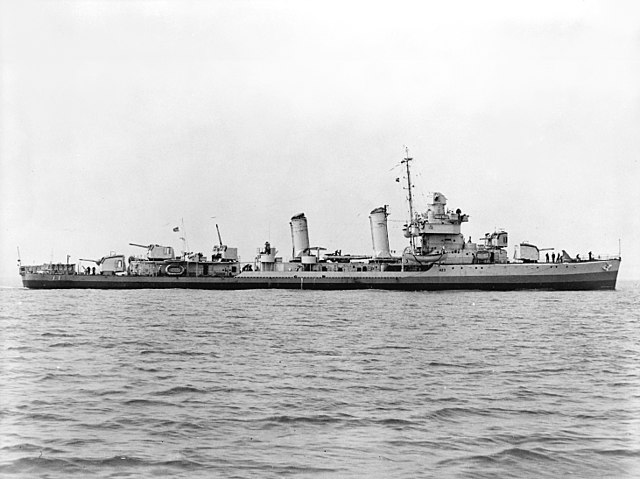
USS Gleaves (DD-423) underway on 18 June 1941, after completion.
The GLEAVES-class (DD-423) destroyers were almost identical to their near sisters of the BENSON class (DD-421), and together they were often referred to as the BENSON/GLEAVES class. About the only external feature by which they could be distinguished was the shape of their stacks; the GLEAVES class had round stacks, and the BENSONs’ stacks were flat-sided. The difference was the result of the work of naval architects at two different design firms. Gibbs & Cox designed the GLEAVES class, which was built in various navy and private shipyards. Bethlehem Steel designed the BENSONs, built only in that company’s shipyards.
An improvement on the SIMS class, which preceded them, the new destroyers were built on the same basic hull design. They introduced a new machinery arrangement, however, that featured alternating boiler and engine rooms calculated to give the ships a better chance at surviving torpedo damage. Their scantlings, or framing dimensions, were increased to carry the weight of the new machinery, which in turn increased the GLEAVES’s displacement by about sixty tons.
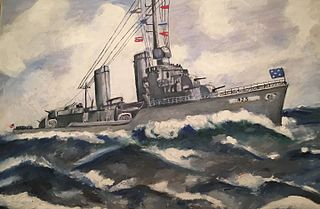 The topside arrangement of the GLEAVES class was similar to that of the SIMS class, but instead of one stack they had two because of the new machinery arrangement. A notable feature of the BENSONs and the early ships of the GLEAVES class was the streamlining of their bridge, superstructure, and deck edges forward, which were subjected to considerable windage, especially at high speeds. The rounded bridge became a flat-sided design in later units of the GLEAVES class beginning with the DAVIDSON (DD-618). The height of the Mark 37 director barbette also was lessened so that it was only slightly above the top of the bridge, thus eliminating a considerable amount of weight high in the superstructure. The ships of the GLEAVES-class were the last U.S. Navy destroyers designed with a raised forecastle deck.
The topside arrangement of the GLEAVES class was similar to that of the SIMS class, but instead of one stack they had two because of the new machinery arrangement. A notable feature of the BENSONs and the early ships of the GLEAVES class was the streamlining of their bridge, superstructure, and deck edges forward, which were subjected to considerable windage, especially at high speeds. The rounded bridge became a flat-sided design in later units of the GLEAVES class beginning with the DAVIDSON (DD-618). The height of the Mark 37 director barbette also was lessened so that it was only slightly above the top of the bridge, thus eliminating a considerable amount of weight high in the superstructure. The ships of the GLEAVES-class were the last U.S. Navy destroyers designed with a raised forecastle deck.
Five 5-inch/38 caliber single gun mounts, two located forward and three aft, were the original main armament of the class. The two mounts on the after superstructure deck were open mounts separated by a deckhouse that served as a shelter for the gun crews. A 36-in. searchlight was mounted atop the shelter. Soon after the war began, the number-three mount was removed and replaced with two twin 40-mm gun mounts. Number-four mount was given a half shield to save weight. Unlike the other mounts, it lacked roof plates. To protect the gun crew from the elements, the designers added a simple framework with a canvas top fitted as a roof for the mount.
Fitted to port and starboard of the centerline were two twin 40-mm gun mounts, which replaced the number three 5-inch gun mount. The deckhouse shelter was removed, and the searchlight was remounted on a short platform just forward of the 40-mm mounts. The .50 caliber machine guns were replaced with four single 20-mm gun mounts; two located forward on each side of the bridge and two amidships on each side of the second stack.
The BENSON/GLEAVES class also introduced the 21-inch quintuple torpedo tube mount, which became the standard for all subsequent U.S. Navy destroyers built during World War II. Originally, the men operating the after set of tubes were shielded from the blast of the number three 5-inch gun by a circular enclosure. When the number three gun was removed, the shield on the torpedo tubes was also removed.
Some references identify the BENSON-GLEAVES class as the BENSON-LIVERMORE class. This was a designation for the FY 38-destroyer procurement coined by popular writers in compiling a number of fleet handbooks, for example James C. Fahey’s The Ships and Aircraft of the U.S. Fleet, volumes 1-4, 1939-45. Some handbooks further split the class, adding the BRISTOL (DD-453) as yet another division. According to tradition, however, a class is identified by the lead ship; hence BENSON-GLEAVES is the proper designation for this group of destroyers
The sixty-six Gleaves were built in parallel to the Benson class, and were ten tons heavier but only differed by minor details, yard-based. Distinction between the two classes is rather superficial, as they were virtually identical, only differing by weight and the Benson having flat-sided funnels, whereas they were round on the Gleaves. They were the last USN destroyers built with a forecastle (no flush deck), but in essence, had the genes of the following Fletchers. They had the same armament of five 5-in/38, six single 0.5 in (12.7 mm) AA HMGs Browning of the liquid-cooled types, and two quintuple TT banks with slightly differing ASW armament. src
Production for both classes went on until February 1943 when the USS Thorn and Turner (DD 647, 648) were launched. Most authors and Conways mixed the two classes into one in fact. However a major difference came with the Bristols sub-class, from DD 453 onwards, which tended to sacrifice the antiship capability for reinforced AA and ASW capabilities. The biggest difference was the adoption of a more potent and modern AA artillery, sacrificing a turret and TT bank in the process.
The Gleaves sub-class Laffey (DD 453) concerned 48 ships in all, wartime redesigned and with four 5-in guns as ordered, but also AA reinforced with four 40 mm AA in twin mounts, seven 20 mm AA and just one TT bank, plus 4 to 6 DC throwers and two DC racks at the stern.
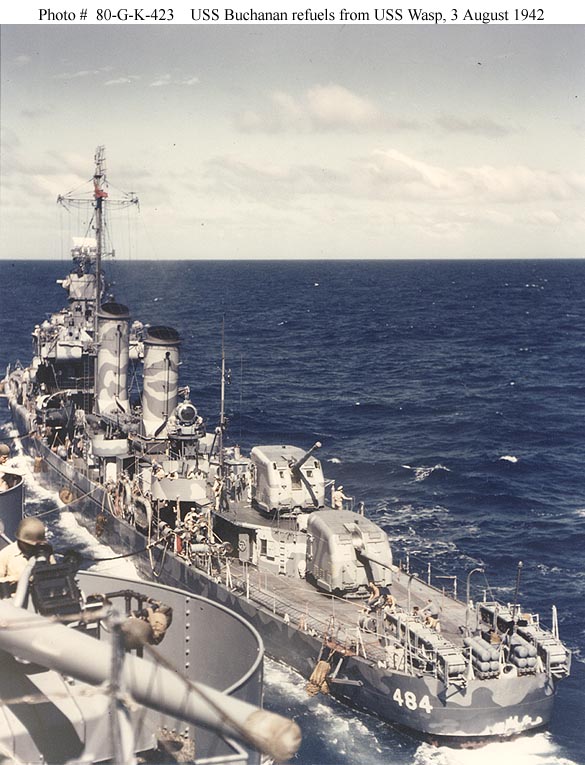
The Bristol and Laffey subclass (repeats)
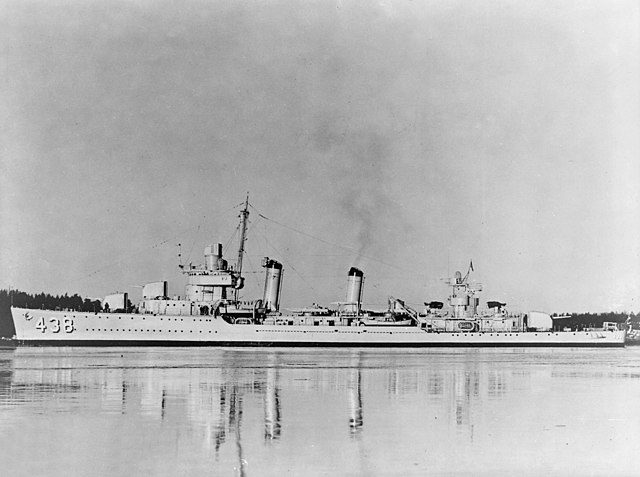
USS Ludlow
The Fletcher design was the brand new wartime design started in September 1939 already, no that all peacetime treaty limits were gone. This class was for prompt reinforcement of the US Navy wiht basically the destroyers the admiralty dreamt of for many years. But since it was also an emergency, compromises were found to the design and the final draft approved for construction was much simpler and closer to the Benson/Gleaves design (same armament but better provision for AA, larger machinery, greater speed and range). However as the new design was slow in coming, the admiralty saw the writing on the wall, as at least 1.5 years were necessary for a new destroyer from laying down to completion, even after simplifying the design and setting up pass production in various yards, all underdimensioned.
The admiralty ordered wisely to just continue with the existing, albeit imperfect Benson/Gleaves design, they also appeared easier in production and could be built faster at that stage. The first 12 ships (DD453-464) were ordered in May 1940 and 15 more (DD483-497) in September. After 7 December 1941 more ordered were placed, for DD598-628 and 632-641 and by February, the last four, DD645-648, knopwing they would be ready perhaps in 1944. Two final series reinforced their old Browning HMGs for a single 28mm quadruple MG mount placed instead of the N°3 gun mount aft well before completion.
By early 1941 from DD 453 onwards, the armament was setup to four 5-in/38mm guns all in covered mounts. But also two twin 40mm Bofors, four single 20mm Oerlikons as specificied. Since production of the latter was late in coming, quadruple 28mm Mark 1 were provided in their place. ASW armament was wartime standard also as specified, for service in the Atlantic as the Fletchers were intended for the Pacific. Each of the new Bristo/Laffey sub-class were to received two DCRs astern (32 DCs) plus a single DCT (Y-gun) on the quarter deck (ten). The increased weight obliged to remove the aftermost TT bank as approved by August 1941. Still, the planned AA increase fuelled fears about these repeat ships to be overweight and some proposed during construction to increase the hull breadth, a measure that was in the end refused to not delay the serie and only accepted for two “prototypes”, DD634 and DD635 which had a 11.3m breadth. The extra buoyancy was to provide this stability, ad they were confidently well armed.
The Bristol sub-class were essentially the Bethlehem design ships (lighter machinery, flat-side funnels) built under two detailed designs both by Bethlehem (DD459, 460, 491, 492 and 598-617) and Gibbs & Сох (DD453-458, 461-464, 483-497, 618-641 and 645-648). External were still flat-sides funnels (Bethlem, or “repeat Benson”) and rounded ones (Gibbs & Cox or “repeat Gleaves”) but the machinery on all was the same under Gibbs & Сох design. Simplification of construction was the main effort here. All the measures (simpler shapes, omitted elements) bore fruits only on the late series (DD493-497, 618-628 and 645-648) with a superstructure that reverted to a simpler rectangular forward section and the director placed directly over the chart room roof and not on a special structure for vibraiton damping (which also reduced weight).
The Laffey sub-class was essentially a repeat of the Gleaves class, Gibbs& Cox design, with heavier machinery and rounded funnels, including the last ones widened to 11.3 m (feet), USS Thorn and Turner.
The first destroyers of these new series were commissioned without 40mm guns, but additional Oerlikons (6 guns at all) as interim, or temporarily with a single 28mm quad “chicago piano” Mark I mount. Standard Bofors for appeared on DD 606 onwards. In November 1942 the armament composition was stabdardized to 4 Bofors, 7 Oerlikons. Earlier destroyers were retrofitted in 1944 in this way. By 1945 their ASW suite was often curtailed as the Atlantic Operations came to and end and this was no longer required for the Pacific.
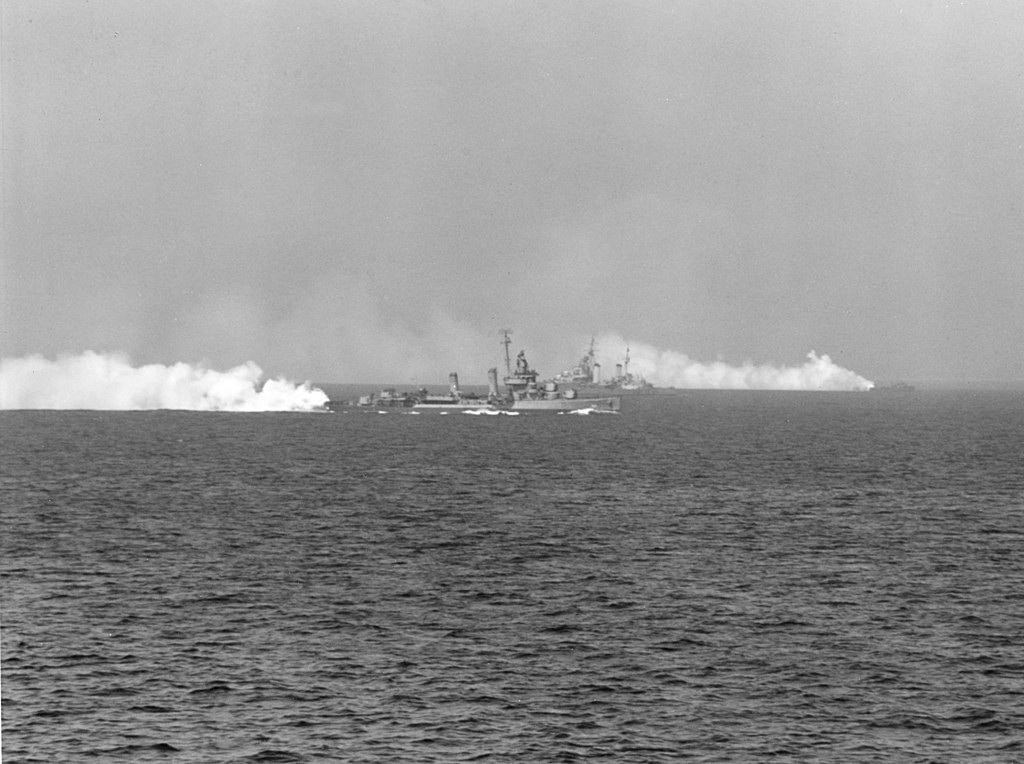
USS Gleaves laying smoke during the invasion of Southern France, 18 August 1944. Probably half of the class took part in Operation Dragoon, dealing with shore batteries, and later patrolling the Franco-Italian border as far as Genoa, sometimes dealing with E-Boats, Mas-Boats attacks as well as human torpedoes and explosive boats.
⚙ Bristol/Laffey (DD 634)* specifications |
|
| Displacement | 1900t standard, 2600t FL |
| Dimensions | 103.9 wl 106.2 oa x 11 (11.3 DD 634) x 4.92m |
| Propulsion | 2 shafts, Westinghouse geared steam turbines, 4 Babcock & Wilcox boilers, 50,000 hp |
| Speed | 35 kts max |
| Range | 302 – 453t fuel oil, 3,630 to 3,880nm at 20 kts |
| Armament | 4x 5-in/38 Mk 12, quad 28mm/75 Mk 1, 5-6x 20mm/70 Mk 4, 1×5 21-in TT, 6 DCT, 2 DCR (62) |
| Sensors | SC, SG, Mk 12.22 radars, QCJ sonar |
| Crew | 208 |
Note that DD453 to 464, 483 to 492, 598, 599, 602, 605, 633, 640, and 641 had the original armament listed on the table above. DD600, 601, 603, 604, 606 to 609, 611 to 613, 618 to 620, 622, 632, 634 to 637 received at completion tjheir planned two twin 40mm/56 Mk 1.2, and four 20mm/70 Mk 4. DD493 to 497, 610, 614 to 617, 621, 623 to 628, 638, 639, 645 to 648 had the same but seven single 20m/70 Mk 4 AA. Electronic equipment also varied over time, with the first batches equipped with the SC, Mk 4 radars, QCJ sonar (DD453 to 464, 483, 484). The remainder were all given the SC, SG, Mk 4 radars, and improved QCJ sonar and the Laffey sub-class but a few late ships (DD625 to 628) swapped the Mark 4 for a Mk 12.22 radar.
Design of the class
Hull and general design
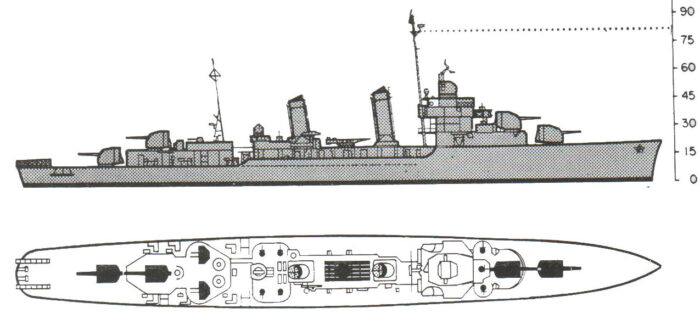
ONI schematics of the Bensons as modified with the extra AA in late 1942. Note the absence of the aft TT bank and extra intermediate 5-in gun.
The Gleaves class were a repeate of a prewar design, with some stability improvements, but nothing else but what the Benson class brought already. The Machinery made them a stacks profile (rounded in Gleaves) and the same “in echelon” machinery arrangement with alternated boiler and engine rooms. This was to ensure a torpedo hit survival, first time this measure was taken. Gibbs and Cox design team had been the driving force behind this adoption, and specified that even with a Loss of one or two adjacent compartments the powerplant at least could be half saved, ensuring that the destroyer could extract itself from the danger zone, albeit at low speed. Displacement varied also between the Gleaves class: DD423, 424, and 429-444 displaced 1838 tonnes standard and 2,572 tonnes fully loaded.
They were also the first destroyer to feature two axial quintuple torpedo tube mounts, as for the Bensons. Construction-wise they were fitted wit the same extensive scantlings (framing dimensions) as the bensons to strenghtened flexion of the hull in heavy seas sea while heaving a bit heavier machinery. The hull was catacterized by fuller hull lines, more buoyant which took part in the stability. Globally as seen from above, the hull was almonf shaped, with fine entries and limited bow flare and a generous, rounded poop but typical anti-collision bars, and counterkeels to reduce roll.
Also measures has been taken for oil bunkerage in the hull to avoid any imbalance and precises advices given to captains for managing the tanks by filling them with seawater in case of low fuel levels while heavy weather was enountered. Typhoon cobra cayastrophy mostly affected Farragut class ships, none of the benson-Gleaves. The hull was the same exactly in dimensions, 341 ft (103.9 m) waterline, 348 ft 2 in (106.12 m) overall (short than the Sims) but featuring the same beam of 36 ft 1 in (11.00 m) and equal draft up to 17 ft 9 in (5.41 m) mean (or full load).
The bridge also retook the same Bensons and Sims class one, designed by Gibbs and Cox. It was streamlined rather than trapeziodal with flat sides, as for the previous destroyer, somewhat lighter, narrower and offering far less drag in high wind, reducing the sail effect in crosswinds. It was also safer in combat that the former glasshouses, a liability in case of shrapnels. Some “ld salts” did not liked the new portholes, but they were far less vulnerable and there was both the open deck above and wings either side for open view.
The surprerstructures were pretty much a repeat of the Sims and Bensons, continuous superstructure after the forecastle, all the way the the quarterdeck supporting superfiring guns. Five main guns were provided, with an intermediate three guns position aft (two on top of the quarterdeck house, on on the poop deck), and two superfiring forward. As the bensons, the twp torpedo tibes banks were elevated one level, which had its reasons for reloads but was not ideal stability wise. Later when modified in WW2, one of these and the N°3 main gun were removed, notably to add more AA. There was no way to concile both due to the prewar stability limits of the class. The Gleaves repeated the exact same fire control system, a single unit placed above the bridge, fully enclosed. There were two masts of unequal size, a pole foremast aft of the bridge supporting light radars and smaller mainmast aft in front of n°3 main gun. A radio detector of the “Huff-Duff” type was placed over it in wartime.
Powerplant
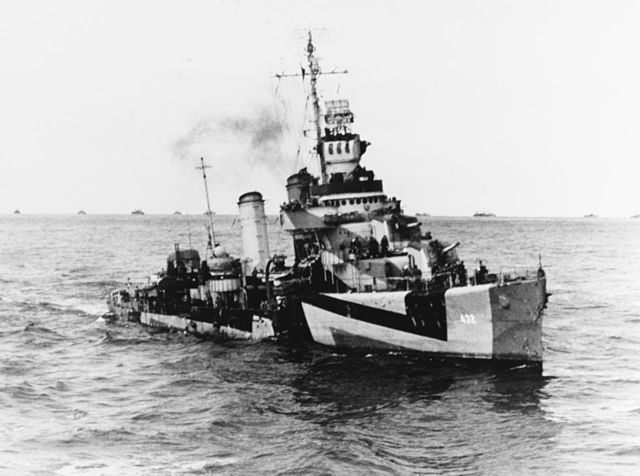
USS Kearny (DD-432) approaching Gibraltar c1944
These ships were fitted with the proven high pressure, high temperature boilers from the Mahan class. Unlike Bethlehem which asked for design changes for a simpler type to be equally efficient, at first rejected by the Bureau of Engineering, and in the end only FY 1938 ships (DD 421–428, six ships) were later built to the original Bethlehem or revised Benson design, while the first two (DD 423–424) were completed to the original admiralty design, and Gibbs & Cox planned machinery configuration. Both were made by Bath Iron Works, and the set adopted comprised two sets of Westinghouse geared steam turbines fed by four Babcock & Wilcox boilers.
The Bureau of engineering also asked to increase boiler temperature to 825° boilers for the later repeat Gleaves underGibbs & Cox design, which were called the Livermore class (from DD 429 onwards). Bath Iron Works incorporated this change also for its first two ships during construction. FY1939 and FY1940 ships became DDs 429–444. Repeat-Bensons also obtained these new boilers rated for 850 °F (454 °C), later also fitted on the Fletchers. The standard of two sets Westinghouse geared steam turbines, four Babcock & Wilcox boilers remained the same for both the initial Gleaves, Livermore, and repeats, only temperature changed.
These turbines drove 3-bladed propellers (two shafts). They were geared steam turbines with reduction and total output was circa 50,000 shp (37,000 kW). Best top speed acheved was 37.5 knots (69.5 km/h) light load on sea trials but it was officiallt 37 knots and when fully loaded, 33 knots (61.1 km/h). As for oil carried, this varied over time, from 302 on the first two to 453 tones on the repeat Gleaves. Range was also a function of the oil load, between 3,630(20) nautical miles initially at 20 knots up to 3,880 nm at the same speed or at 12 knots, up to 6,500 nautical miles (12,000 km; 7,500 mi). The bulk capacity was indeed radically augmented both on the “repeat Bensons” and “repeat Gleaves”, with extra inner hull tanks. Needless to say, the range of the following Fletcher class way above this.
Armament
This was complete repeat of the Benson class:
-Five single 5-in/38 standard DP guns, fully (N°1,2, 5) or partially enclosed (N°3,4)
-Two quintuple torpedo tibes banks amidship, centerline, with 14 torpedoes (4 reloads)
-Six single cal.0.5-in (12.7mm)/90 Browning M1921 (1929).
This was upgraded from 1942.
Main: 5x 5-in/38
The original five 5-in/38 (127 mm) were in Mk 12 enclosed gun mounts for two forward superfiring and the deck aftermost one. The aft and intermediate mount on the aft quarterdeck house were open mounts, unshielded to reduced top heaviness. Later as the N°3 was landed, the N°4 sometimes received an enclosed mount.
⚙ 5-in/38 Mark 12 specifications |
|
| Open Mount full weight | Mark 30 mount Mod 1: 33,500 lbs. (15,195 kg) |
| Enclosed Mount full weight | Mark 30 mounts Mod 41: 41,400 lbs. (18,779 kg) |
| Barrel | 3,990 lbs. (1,810 kg) without breech, 223.8 in (5.683 m) long |
| Muzzle Velocity | 2,500 fps (762 mps) average |
| Rate of Fire | 15-22 rounds/minute |
| Elevation | -10 to +85° |
| Range | Max 85°, 2,940 yards (2,688 m) |
| Crew | 8 inside, 7 outside open src |
| Ammunition | Bensons: 320 (Gleaves 360) |
| Penetrating power | 13,800 yards (12,620 m): 1.0″ (25 mm) armor* |
*with special common shell
Torpedo Tubes
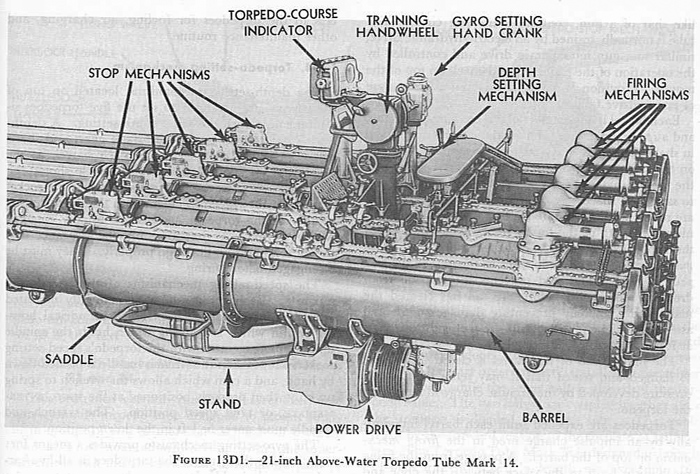
ONI explanation on the Mark 14 Quintuple Bank of the Benson-Gleaves (from navweaps).
The Gleaves class quintuple banks became the “new normal” on USN Destroyers, until the swap to missile destroyers (the were dropped in effect from Forrest Sherman destroyers already). The new arrangement was a return of experience on side TT banks, a typical feature of interwar US destroyers. The main problem was stability, and these deck TTs were regularly tossed by waves, with corrosion and accidents, plus difficult reloading in all but calm seas, when available. FY1939 program destroyers swapped to centerline TT banks (a worldwide accepted standard) and to avoid spray, they were raised well above the deck. Often also the seated operator had his own armored box. The curve-ahead fire was still optional by settings.
These quintuple torpedo tube banks were also a world’s first. Triple or quadruple was the norm, even for British destroyers late into the war. This gave these destroyers the largest broadside at the time, a solid answer to Japanese “special type destroyer”. The latter had typically three triple banks. Depending on the sources, each Gleave class destroyer carried 14 torpedoes, thus 4 reloads, or 14 reloads in all, which seems unlikely. Having reloads (stored close to the banks with manual crane/winch system) was a plus compared to previous class, although limited. Again, topweight matters prevailed and it is not even sure than these reloads were carried at all times.
It was assumed than once the volley was done, destroyers would return to the nearest base for reload. The reload process if anything was a risky and long operation requiring calm seas, and virtually impossible in a war zone. Engineers also studied the effect a full volley on the ship’s stability while at sea, and it was advised to stick to the usual successive fire of tubes. This was also to alleviate wake interferences. See a color rendition of the mount.
The MK 14 and MK 15 torpedo tube mounts launched 21-inch MK 15 torpedo. This trainable arrangement derived from the quadruple one had a larger base and reinforcements below the hull deck; Each mount had a stand, saddle, barrels, controls, heating equipment, and the optional rounded blast shield (MK 15 mount) to protect the operator from shrapnel and nearby 5-inch gun blast. The five tubes in a parallel arrangement were secured via hold down clips.
The assemblies comprised the main tube barrel, its hinging door and spoon extension, all bolted to the saddle via ring flanges. These spoon extensions were also hinged and folding backwards on top of the barrel for access to the torpedo warhead. Controls from the torpedo gyro gave displays for the depth and speed settings mounted aft of the ring flanges using electrically input. The torpedo tubes also had barrel heaters underside for cold weather, which proved handy during the Aleutian campaign in 1943 (winter 1942-43 especially).
The firing mechanism of each tube was placed on the aft end forward of the breech doors, launched individually by ignition of black powder using replacable impulse cartridges using either hydraulic percussion or electrical input. A tripping latch after the torpedo left the muzzle retrigerred the system (like re-cocking a firearm). Each Gleaves class destroyer also had a pair of retractable loading cranes and a set of holding chain bracing the torpedo until it was aligned with the tube when reloaded and manually pushed inside, after greasing.
⚙ Mark 14 Bank, 21-inch MK 15 Mod 3 torpedoes specs |
|
| Weight | 3,841 lbs. (1,742 kg) |
| Lenght | 24 ft (7.315 m) |
| Settings | 4,500 yds/45 kts – 9,000 yds/33.5 kts – 14,000 yds/26.5 kts |
| Propulsion | Wet-Heater steam turbine |
| Warhead | 801 lbs. (363 kg) TNT or 823 lbs. (373 kg) HBX |
| Exploder | Contact |
| Guidance | Mark 12 Mod 3 gyro |
| Reloads | Bensons: 0 to 4 |
AA
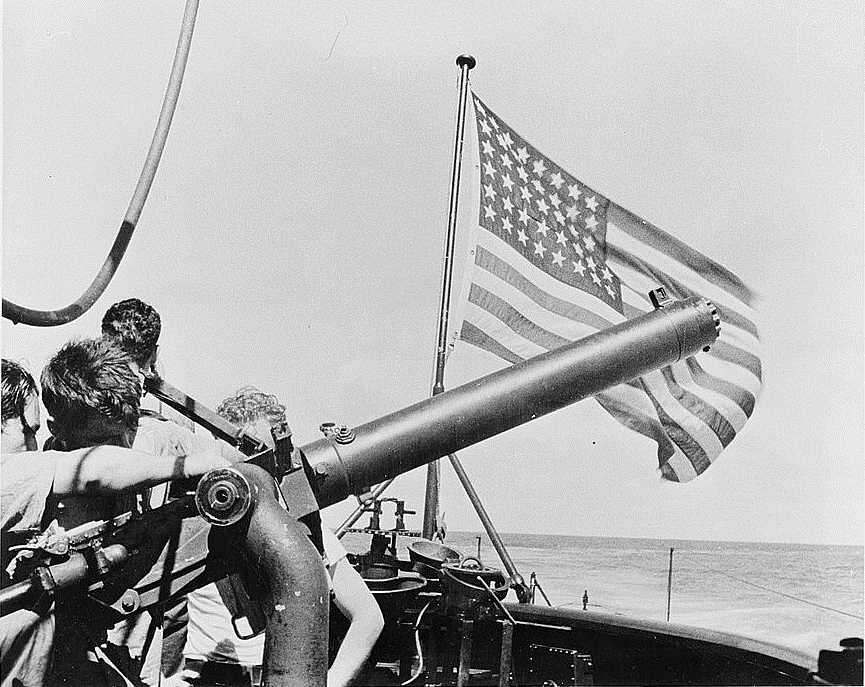
Single liquid-cooled HMG, navy standard in 1941 (navsource).
The Gleaves like the Bensons had originally as designed three pairs of liquid-colled M1921 Browning Heavy Machine Guns, located of platforms forward, amidships and aft. This was less the Sims class, and from December 1941, the admirakty planned to have them all equipped asap by 20 mm Oerlikon guns, replacing all mount on a one-to-one ratio. The Brownings fired 550 rounds per minute up to 5,000 feet (1,524 m) ceiling or 15,000 feet (4,570 m) range depending on the target.
More on navweaps
The admiralty in 1942 wanted also to mount the new 40 mm Bofors in twin mounts as soon as available also. The only way to get rid of the N°3 main gun to fit two. Later the N°2 TT bank was also removed enabling to fite two more, and later. Bottlenecks in production made the 40mm/56 Mk 1.2 arriving late, and fitted during refits. In 1945 a single quad mount was added also on some ships.
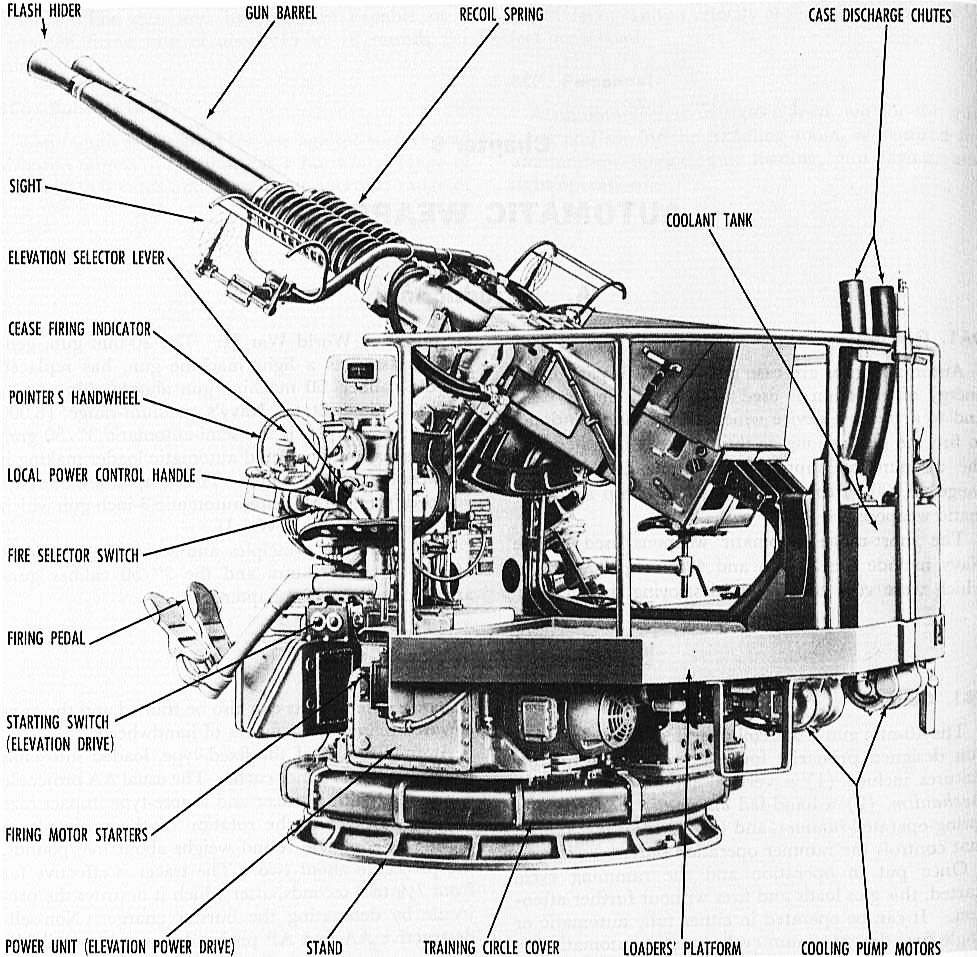
The twin-barrel 40mm/55 Mark 1.2
More on the naval weapons encyclopedia
It seems that some Gleaves class destroyers were fitted also with a single 1.1-in quad (28mm/75) Mk 1 mount from 1942 as an interim for the Bofors. The later became mandatory by early 1944, replacing the N°3 gun, with two twin 40mm/56 Mk 1.2, four single 20mm/70 Mk 4 as standard and all 21-in torpedo tubes plus a larger ASW defence.
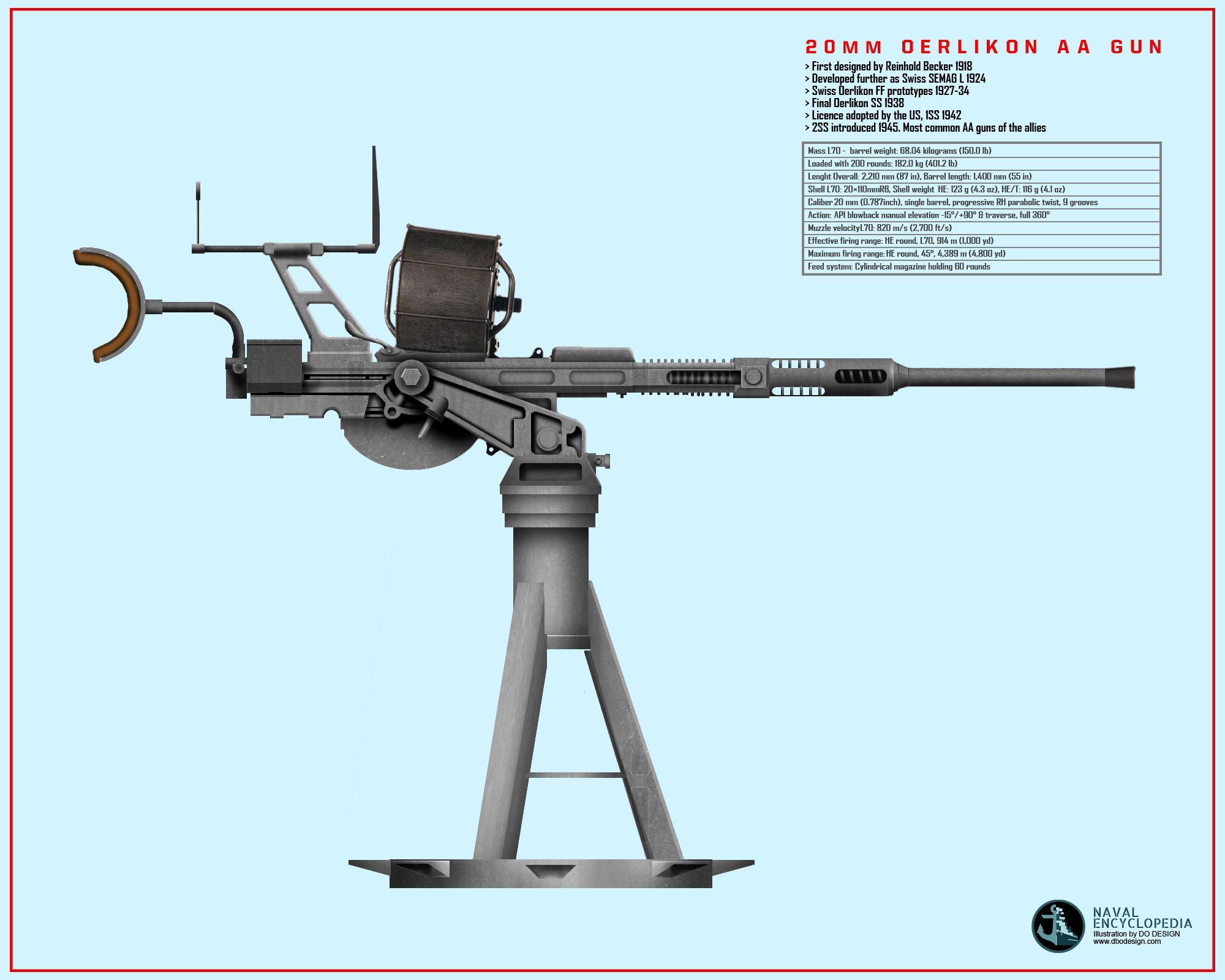
20 mm/70 Mark 4 single mount. These ships had at first those, then twin mounts. More.
ASW
Installed at the poop were two depth charge racks of the Mark 1, Mod 1 holding five depth charges each. In wartime the model was changed to the Mark 3 to hold ten, and this was completed by a battery of four or six Mark 6 K-gun depth charge throwers. K-guns had each a single launcher and three ready reloads, with more than can be reloaded from below. It fired the Mark 9 DC by 1945. There were up to 50 depth charges carried.
Types in use were the following:
–Mark 7 (1937, service 1938): 745 lbs. (338 kg) with 600 lbs. (272 kg) TNT warhead
Sink Rate or Terminal Velocity 9 fps (2.7 mps), set range from 50 to 300 feet (15-91 m)
–Mark 8 (1941, s. 1943)-Magnetic pistol DC.
525 lbs. (238 kg), 270 lbs. (122 kg) TNT warhead, sink Rate 11.5 fps (3.5 mps), up to 500 feet (unreliable but probably tested on Atlantic ships of the 1st serie)
–Mark 9 (1941, s. 1943): late war teardrop model with greater sink rate.
320 lb to 340 lbs. (154 kg) warhead 190-200 lbs. (86-91 kg) TNT
Sink rate 14.5 fps (4.4 mps) up to 22.7 fps (6.9 mps) for mod 2
Setting range from 50 to 600 feet (15-183 m). Standard for ships re-equipped in 1944-45.
Sensors & FCS
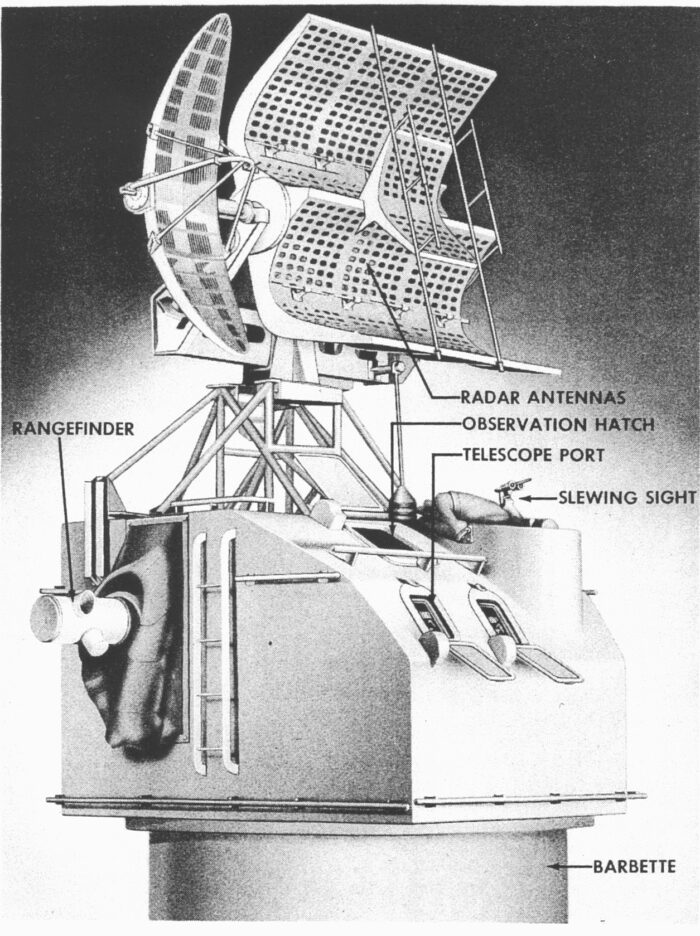
As completed, DD421 to 434 were given a QCE sonar in complement to their ASW additions. For the later “repeats” serie, DD435-444 presumably they were fitted with the SC, Mk 4 radars, and QCE sonar as standard.
Mk37 GFCS
The fire-control system on bridge top was a fully enclosed and lighter model, better protecting the operators from shrapnels. It was fitted with a radar on top and data was transmitted for a solution inside the ship to a computer Ford Mark 1. Rate information for height changes allowed to fire on aircraft flying up to 400 miles per hour (640 km/h). The computed and FCS were later revised and recalibrated to put into good use the VT (Variable Time) proximity fuze way more efficient against aviation.
SC radar
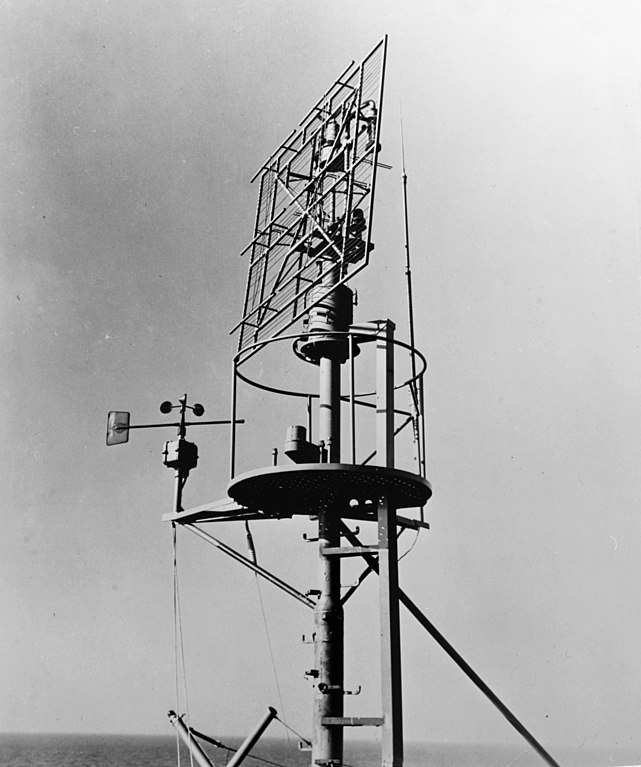
From 1942 was installed on the formast this 220 kW Air/Surface-search radar working in VHF band:
PRF 60 Hz, Beamwidth 10–25°, Pulsewidth 4–5 μs, Range 48–120 km (30–75 mi), Precision 90–180 m (98–197 yd)
Mark IV FE FCS Radar
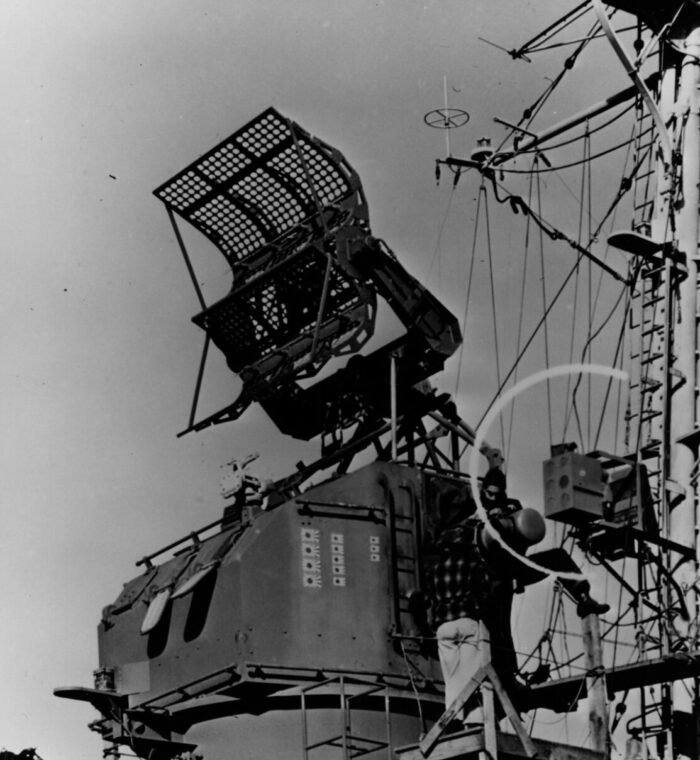
The Radar Mark 4 Or Type FD was mounted on top of the Mark 37 Fire Control System. Photo; USS McCalla, 5 January 1944. src Naval History and Heritage Command.
Specs:
Bearing Accuracy 0.225, Bearing Resolution 10, Horizontal Beamwidth 12, Vertical Beamwidth 12
Range Accuracy 37m, Range Resolution 365.76m, Range in Nautical Mile 19.966
Radar Antenna Siz 1.829 m
QC Sonar
From the U.S. Naval Research Laboratory, first destroyer-mounted, echo-ranging sonar. Worked on 15 to 20 kHz and operated from 1933, and became the standard ASW active sonar on all U.S destroyers. src and also and this.
Modifications
Both the Bensons and Gleaves were initially armed the same, and thus, underwent about the same upgrade when commissioned in 1941: All received that yea a single 1 DCT (“Y”-gun) with 22 Depht charges in total and then by early 1942 they saw the replacement of their six single Browning M1921 AA HMGs and the aftermest quintuple TT banks, as well as one “Y”-gun for the addition of six 20mm/70 Mk 4 Oerlikon and four to six DCT (44-50 DC). Later that year, many losed their N°3 5-in/38 for a single quad 28mm/75 Mk 1 for AA defense and for esome one extra 20mm/70 Mk 4 AA gun. Between 1942 and 1944 dependng on upgrades, they also received electronics, in the shape of SC, SG, Mk 4 or Mk 12.22 radars, and typically at the end of the war, they gad four 5-in/38 Mk 12, two twin 40mm/56 Mk 1.2, four single 20mm/70 Mk 4 AA guns, one or both 21-in quntuple TT banks, four to six DCTs and two DCR for up to 50 depth charges.
As for the repeat Gleaves, they already came out with a modified armament, with four main guns, one TT bank (the one between funnels), a single quad 28mm/75 Mk 1 instead of N°3 turret, all remaining ones fully enclosed, five to six 20mm/70 Mk 4 AA guns and six DCT, tow DCR (62 depth charges). They were intended indeed mostly for the Atlantic, freeing the brand new Fletchers for the Pacific. Later, they were upgraded when available with Bofors. Already the late series came up with two twin 40mm/56 Mk 1.2 and seven single 20mm/70 Mk 4.
As for electronics, they came out with SC, Mk 4 radars, QCJ sonars, then SG, Mk 12.22 radars. Upgrades concerned mostly the swapping of the single quad 28mm but two twin Bofors mounts, but it varied considerably towards the end of the war: Some were left with only three main guns 5-in/38 Mk 30, the two twin Bofors, seven Oerlikon Mk 10, but an ASW complement rediced to 2 DCT, 2 DCR (34 DCs) since the threat of UBoats was virtually nullified by late 1944, they also had a minesweeping gear.
Other retained all four main guns, got rid of their remaining TT bank for a much strenghtened AA, with two two quad 40mm/60 Mk 2, and the original two twin 40mm/60 Mk 1, and two twin 20mm/70 Mk 24, two single Mk 10, and their ASW capability intact with six DCT and two DCR for 62 Depth charges in reserve. They were essentially Pacific stationed picket “gunboats” and escorts dealing with Kamikazes.
Appearance

USS Mayo (DD 422) of the Benson class, just completed in sea trials, original configuration, Sept. 1940
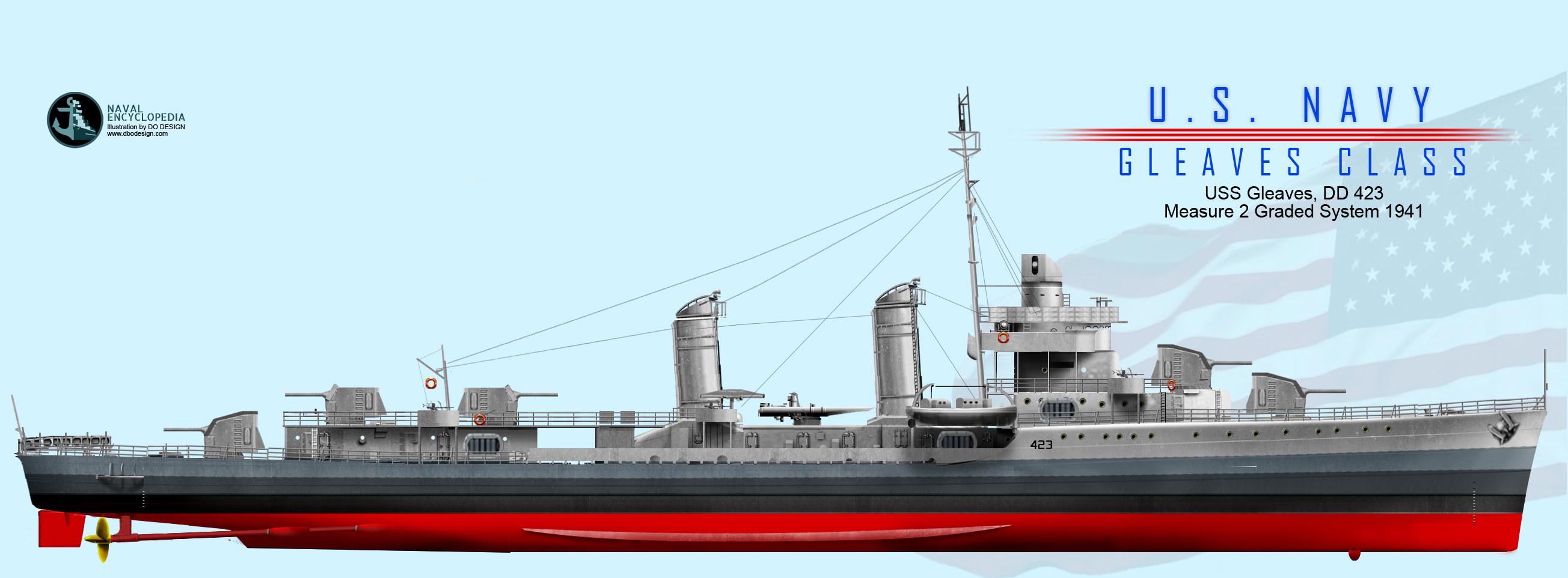
USS Gleaves in late 1941, Measure 2 graded system.

USS Meade DD 602, Measure 12 mod, graded system, fall 1942.
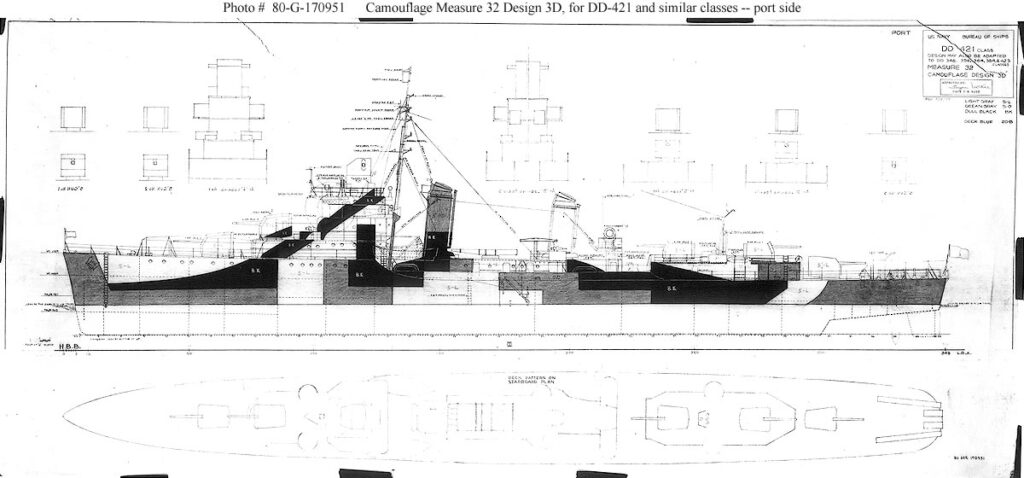
Pattern sheet MS 32, 3D, Benson class, starboard
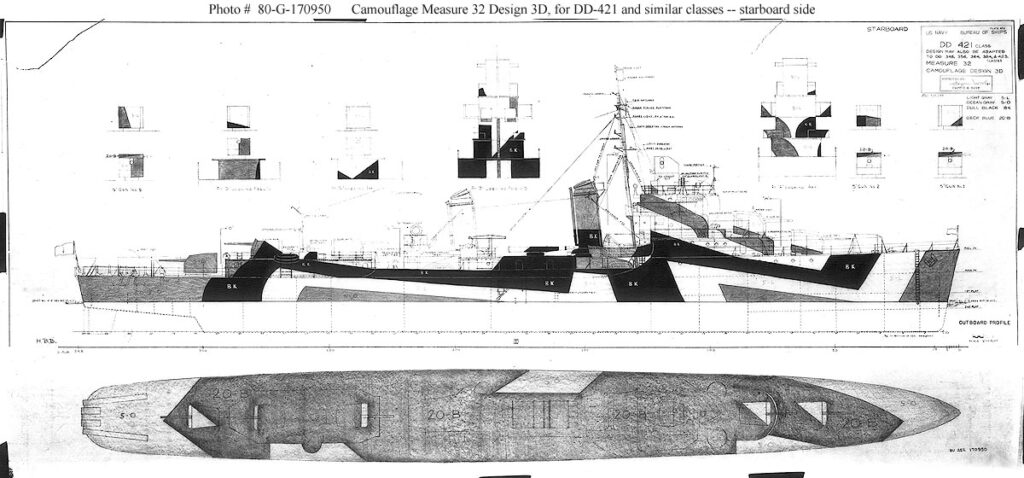
Benson class, Measure 32 design 3D, port side.
More Profiles to come !!!
⚙ Gleaves class specifications |
|
| Displacement | 1,839 t, 2,395 T FL |
| Dimensions | 106.17 oa x 11.1 x 4 m () |
| Propulsion | 2 shafts Westinghouse turbines, 4 B&W boilers, 50,000 hp. |
| Speed | 37 knots max (33 FL) |
| Range | 6500nm/12 kts, see notes |
| Armament | 5× 5-in/38, 6x 0.5-in AA, 2×5 TT 21-in (533 mm), see notes |
| Sensors | Mark 37 FCS, later QCE sonar, SC, Mk 4 radars |
| Crew | 208 |
Name: R.A. Gleaves
 The lead ship of the class, USS Gleaves, was named after Admiral Albert Gleaves, who is credited with improving both, the accuracy and precision of torpedoes. It was appropriate for destroyers. However so far, no other USN ships has been named after him. Born in Nashville, Tennessee, R.A. Gleaves graduated from the USN Academy in 1877. Her served on two frigates, USS Hartford and Trenton, before becoming an Ensign in 1881. He notably commanded USS Cushing, an early torpedo boat during the Spanish–American War. Later he was promoted to the rank of commander, being assigned the battleship North Dakota. A rear admiral in 1915 her was in charge of the cruiser & transporte force during the great war, being awarded the Army and Navy Distinguished Service Medals. In 1919, now an Admiral, her commanded the Asiatic Fleet and while at the Naval Ordnance Proving Ground, he made outstanding contributions in gunnery and torpedoes, fields for which he would be the most remembered for, the precision and accuracy he brought into these. On USS Cushing he tested a gear that was adopted prior to 1917 and became standard on US destroyers.
The lead ship of the class, USS Gleaves, was named after Admiral Albert Gleaves, who is credited with improving both, the accuracy and precision of torpedoes. It was appropriate for destroyers. However so far, no other USN ships has been named after him. Born in Nashville, Tennessee, R.A. Gleaves graduated from the USN Academy in 1877. Her served on two frigates, USS Hartford and Trenton, before becoming an Ensign in 1881. He notably commanded USS Cushing, an early torpedo boat during the Spanish–American War. Later he was promoted to the rank of commander, being assigned the battleship North Dakota. A rear admiral in 1915 her was in charge of the cruiser & transporte force during the great war, being awarded the Army and Navy Distinguished Service Medals. In 1919, now an Admiral, her commanded the Asiatic Fleet and while at the Naval Ordnance Proving Ground, he made outstanding contributions in gunnery and torpedoes, fields for which he would be the most remembered for, the precision and accuracy he brought into these. On USS Cushing he tested a gear that was adopted prior to 1917 and became standard on US destroyers.
He retired on January 1, 1922, became an author, companion of the Naval Order of the United States, died at Haverford, Pennsylvania on January 6, 1937, so the name was reserved as part of FY1938 naval plan to name a new destroyer after him. He had a statue at the State Capitol in Nashville, Tennessee, later moved to the Tennessee State Museum. His most famous alleged quote was:
“To seamen a ship becomes endowed with human virtues and faults; she ceases to be a mere inanimate thing.”
The Bensons/Gleaves in action:
Following the end on the Atlantic-Mediterranean operations, 24 ships (Bensons and Gleaves) were converted as high-speed minesweepers (DMS) for the Pacific: 12 were pressed into MinRon 20 in 1944, operating off Okinawa, spring 1945 and Tokyo Bay by August, plus 12 in MinRon 21 which arrived too late. 16 were lost during the war, including Meredith, Monssen, Laffey, Duncan and Barton in the long Guadalcanal campaign, USS Aaron Ward and Gwin in the Solomons. On the Atlantic theater, USS Lansdale, Bristol, Corry, Glennon, Maddox and Beatty were sank by U-Boats. USS Emmons was sunk by Kamikaze off Okinawa, USS Ingraham to a collision, USS Turner after an accidental magazine explosion. Forrest, Harding, Butler and Shubrick, the first three engaged as DMS were badly damaged by mines at Okinawa.
12 were decorated for outstanding action, well beyond usual battle stare. USS Hilary P. Jones, Plunkett and Woolsey in the Mediterranean, USS Hobson as Atlantic escort carrier task group 2 escort, USS Laffey and Buchanan for action in the Solomon Islands, USS Bailey for the Battle of the Komandorski Islands, four minesweeper conversions, Rodman, Emmons, Macomb and Butler at Okinawa with commendations.
Deployment (src)
DESRON 7:
The eight ships authorized in fiscal year 1938 plus Plunkett, authorized in 1939 but, after Gleaves, the second ship of the class commissioned.
DESDIV 13 — 421 Benson, 422 Mayo, 423 Gleaves, 424 Niblack, 431 Plunkett (flag).
DESDIV 14 — 425 Madison (initial flag), 426 Lansdale, 427 Hilary P. Jones, 428 Charles F. Hughes.
DESRON 10:
After Bristol, the nine low-numbered repeat 1,630-tonners (Bristol class); the first squadron of F/Y 1941 ships commissioned.
DESDIV 19 — 454 Ellyson (flag), 455 Hambleton, 456 Rodman, 457 Emmons, 458 Macomb.
DESDIV 20 — 461 Forrest (flag), 462 Fitch, 463 Corry, 464 Hobson.
DESRON 11:
The remaining F/Y 1939 ships plus Ericsson, initially with Sims-class Roe as flagship. DesDiv 22 was deployed to the Pacific in 1942 where, after two of its four ships were lost, survivors were attached to DesRon 12.
DESDIV 21 — 418 Roe (flag), 429 Livermore, 430 Eberle, 432 Kearny, 440 Ericsson.
DESDIV 22 — 433 Gwin (flag), 434 Meredith, 435 Grayson, 436 Monssen.
DESRON 12:
The second squadron of repeat 1,620- and 1,630-tonners commissioned: the three lowest-numbered 1,620-tonners plus six consecutively-numbered 1,630-tonners from Federal.
DESDIV 23 — 459 Laffey, 460 Woodworth, 483 Aaron Ward, 484 Buchanan, 491 Farenholt (flag).
DESDIV 24 — 485 Duncan, 486 Lansdowne (flag), 487 Lardner, 488 McCalla.
DESRON 13:
The remaining F/Y 1940 ships plus repeat 1,630-tonner Bristol, initially with Sims-class Buck as flagship.
DESDIV 25 — 420 Buck (flag), 437 Woolsey, 438 Ludlow, 439 Edison, 453 Bristol.
DESDIV 26 — 441 Wilkes (flag), 442 Nicholson, 443 Swanson, 444 Ingraham.
DESRON 14:
DESDIV 27 — 602 Meade, 607 Frazier, 608 Gansevoort (squadron flag from June 1943), 619 Edwards.
DESDIV 28 — 492 Bailey (initial squadron flag), 598 Bancroft, 605 Caldwell, 606 Coghlan.
DESRON 15:
DESDIV 29 — 489 Mervine (flag), 490 Quick, 618 Davison, 640 Beatty, 641 Tillman.
DESDIV 30 — 632 Cowie (flag), 633 Knight, 634 Doran, 635 Earle.
DESRON 16:
DESDIV 31 — 604 Parker (flag), 612 Kendrick, 613 Laub, 614 Mackenzie, 615 McLanahan.
DESDIV 32 — 600 Boyle (flag), 601 Champlin, 616 Nields, 617 Ordronaux.
DESRON 17:
DESDIV 33 — 603 Murphy, 620 Glennon, 621 Jeffers, 622 Maddox, 623 Nelson (flag).
DESDIV 34 — 636 Butler (flag), 637 Gherardi, 638 Herndon, 639 Shubrick.
DESRON 18:
DESDIV 35 — 493 Carmick, 494 Doyle, 495 Endicott, 496 McCook, 497 Frankford (flag).
DESDIV 36 — 624 Baldwin (flag), 625 Harding, 626 Satterlee, 627 Thompson.
DESRON 19:
DESDIV 37 — 645 Stevenson (flag), 646 Stockton, 647 Thorn, 648 Turner.
DESDIV 38 — 609 Gillespie, 610 Hobby (flag), 611 Kalk, 628 Welles.
Combat reports
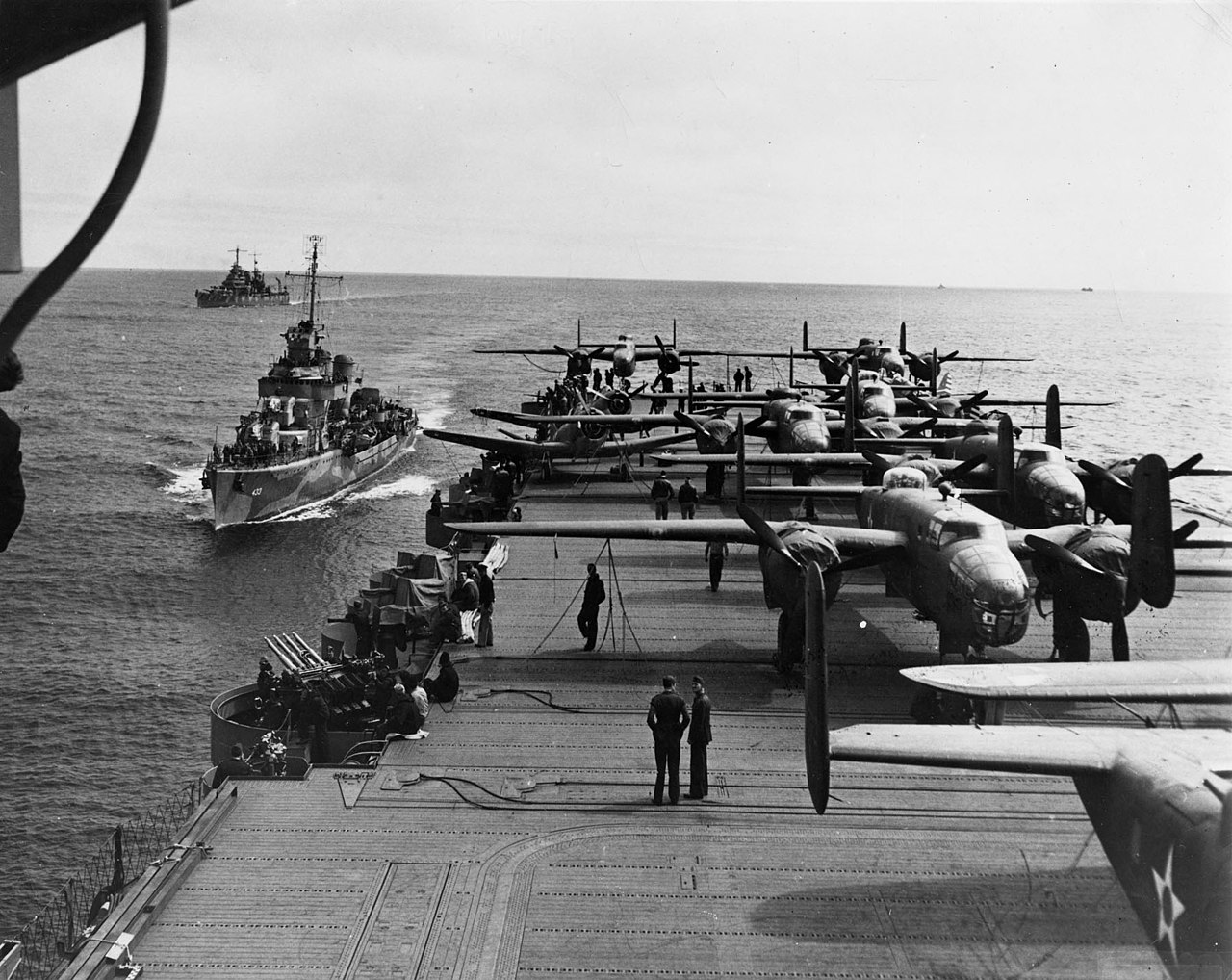
USS Hornet (CV-8) with USS Gwin (DD-433) during the Doolittle Raid
Twenty-one of these Gleaves & Bristol subclass class were in commission when the Japanese attacked Pearl Harbor. Of course afterwards, production was step up and the logical step was to deliver the simplified Fletchers. But in 1941 already, the admiralty ordered simplifications in design to Seattle-Tacoma batch (DD493-497, 624-628) and Federal/Kearny (DD618-623, 645-648) with squared-faced bridges and directors directly on the pilot house rather than suspended on pedestals. After these changes, USS Livermore was tested at 50,400 hp and 37.58 knots at full speed. In total, sixteen of both class were sunk in action, starting with the USS Meredith (15.10.1940) the USS Lansdale (20.4.1944), Gwin (13.7.1943), Monssen (13.11.1942), Ingraham (22.8.1942), Bristol (12.10.1943), Emmons (06.04.1945), Laffey (13.11.1942), Corry (6.6.1944), Hobson (27.4.42), Aaron Ward (7.4.43), Duncan (12.10.42), Glennon (10.6.44), Maddow (10.7.43), Beatty (6.11.43) and Turner (3.1.44).
The fast minesweepers (DMS) in action
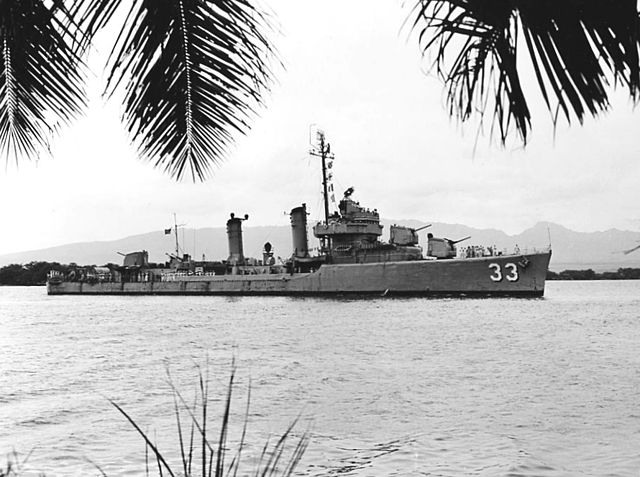
USS Carmick, DMS-33 at Pearl Harbor 1951
Twenty-four Gleaves-class were converted (generally in early 1945) to destroyer minesweepers (DMS-19 to DMS-42) in 1944-1945. The earlier numbers were former Wickes/Clemson class vessels. There were 12 Atlantic Fleet ships (DD-454–458, 461, 462, 464, 621, 625, 636, and 637) in late 1944, and the remainder were Pacific vessels by 1945 (DD-489, 490, 493–496, 618, 627, and 632–635). They had a magnetic and acoustic minesweeping gear installed as well as extra AA, which imposed to reduce main armament to just three 5-in guns, no torpedo tubes at all, two K-guns (instead of 4-6), but they had four 40 mm guns in two twin mounts, seven 20 mm guns for the Atlantic ships, and eight 40 mm guns in two quad mounts, six 20 mm guns in two twin and two single mounts for the Pacific one. These were the best AA defended destroyers of the prewar era ever. But it was needed to, as just as picket ships, it was a dangerous job: You can’t dodge mines when attacked by kamikazes. And they all served in the cauldron of Okinawa, cearing up extensive minefields in all the bays and approaches to the large island. They also cleared mines for up to two years in the yellow sea, inner sea and in many areas postwar. Twelve DMS ships saw service in the cold war, notably in Korea for the same job. However, they were judged ineffective due to their large crew compared to true minesweepers, and so decommissioned in 1954–56.
Bensons/Gleaves in the cold war
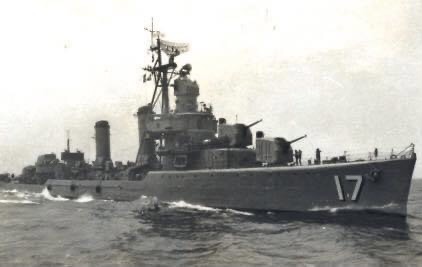
ROCS Nan Yang (DD-17) in the 1960s
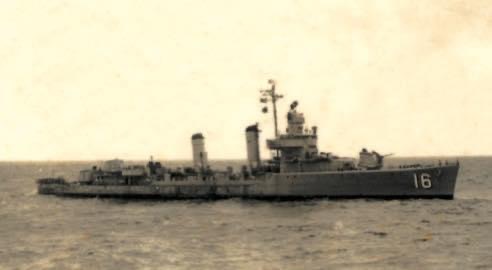
ROCS Hsien Yang, DD-16
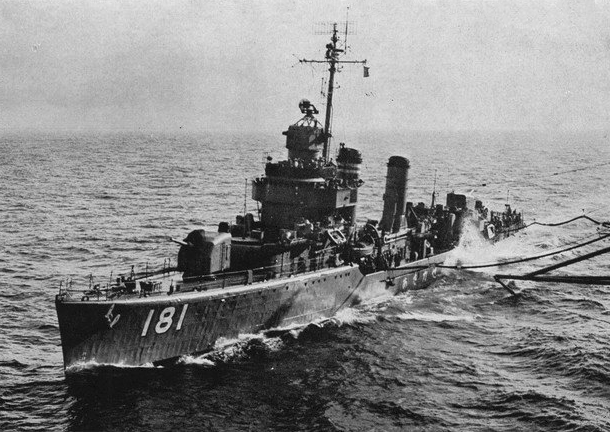
JMSDF destroyer Asakaze, DD-181 underway, 1959.jpg
Post-war saw the fast minesweepers remaining in commission. USS Nicholson and Woodworth were transfered under MDAP to the Italian Navy in 1951 as the Artigliere class, while the others were mothballed.
Some however were recommissioned for the Korean War. 12 were transferred abroad later still under MDAP:
-USS Lansdowne, Lardner and McCalla joined the Turkish Navy in 1949.
-Eberle and Ludlow joined the Greek Navy in 1951
-Ellyson and Macomb made the bulk of the JMSDF in 1954
-Benson, Hilary P. Jones and Rodman joined the ROCN (Taiwanese Navy) in 1954–55 and USS Plunkett in 1959, many of these ships were still active in the 1970s, at a time the US-mothball ships were stricken and BU.
Korea:
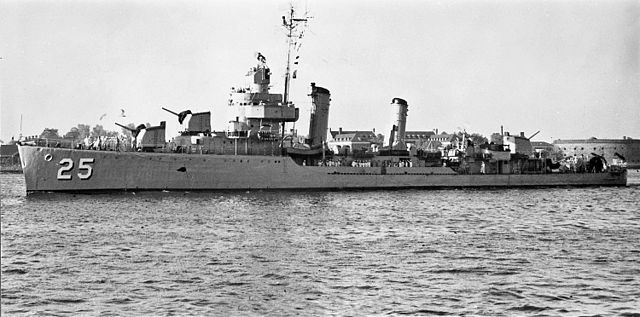
USS Fitch as DMS-25 underway off Korea in the 1950s
Some late ships saw action in the Atlantic, vefore being transferred to the Pacific often quite late. In that case, they mostly operated escorts with occupation duties troops, and stayed in the area until 1946-47, sometimes longer, but others were retransferred to the Atlantic fleet and made several tours of duty in the Mediterranean with the 6th fleet. However about 6-7 saw intensive action in Korea, 1950-1953, in various tasks. Two even saw action at the landings of Inchon. And they collected about 20 battle stars in Korea collectively.
Read More
Books
Bauer, K. Jack; Roberts, Stephen S. (1991). Register of Ships of the U.S. Navy, 1775–1990: Major Combatants. Greenwood Press.
Friedman, Norman (2004). US Destroyers: An Illustrated Design History (Revised ed.). NIP
Gardiner, Robert; Chesneau, Roger (1980). Conway’s All the World’s Fighting Ships 1922–1946.
Gardiner, Robert; Chumbley, Stephen (1995). Conway’s All the World’s Fighting Ships 1947–1995 (cold war Gleaves).
Silverstone, Paul H. (1965). U.S. Warships of World War II. Ian Allan Ltd.
Public domain Dictionary of American Naval Fighting Ships.
Links
Benson/Gleaves destroyerhistory.org/
navypedia bensons/gleaves
navypedia bristol/laffey (repeats)
navsource.org/ global
PDF general info about the USS Gleaves, Bath Iron works.
destroyers.org Bethleham steel ships
Gleaves class on destroyerhistory.org/
CC Photos, gleaves class
Model Kits
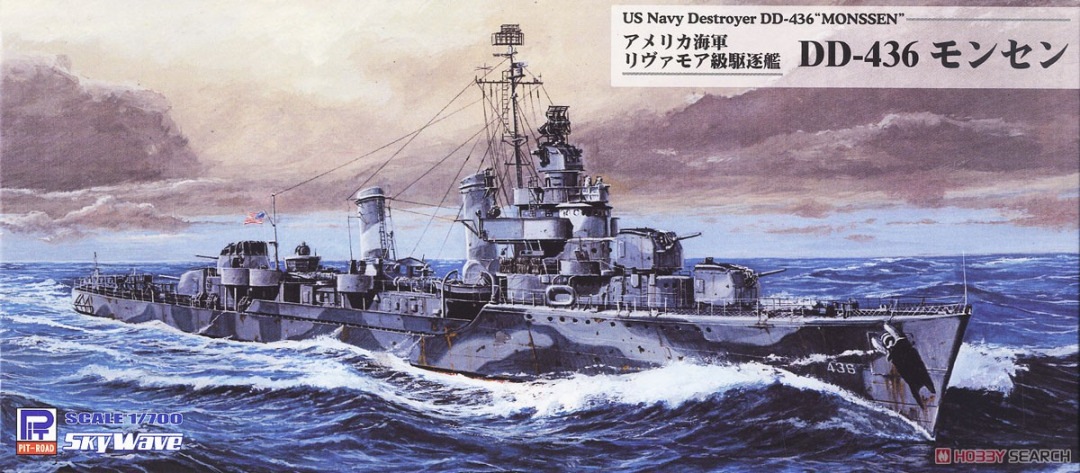
Some choice but mostly old kits (click the image to get the scalemates full offer). Pit-Road, Dragon, Cyber Hobby covered a few in 1/700. Apart Photo-Etched Parts, books has been published also:
Gleaves-class destroyer: USS Davison DD-618 US Navy Booklet of General Plans, New York Navy Yard, 2022 Digital version
Gleaves-class destroyer USS Gleaves DD-423 Model Monkey US Navy Booklet of General Plans, Bath Iron Works, same.
USS Buchanan DD-484: Classic Warships Publishing 31, Warship Pictorial No. 31 by Steve Wiper
It has been also covered by modelmakers and is proposed at various scales.
The Gleaves in service
 USS Gleaves DD 427
USS Gleaves DD 427
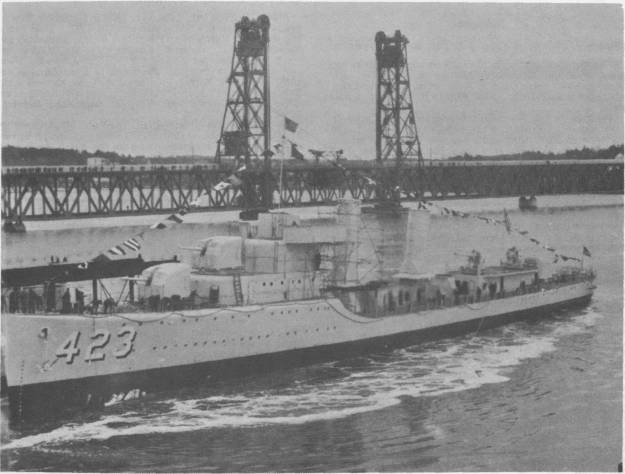
USS Gleaves was commissioned on 14 June 1940 at Boston Navy Yard. She was assigned first to the Atlantic convoys, after a shakedown in Cuban waters, starting convoy escort work off the Atlantic coast and Caribbean, homeported to Boston from 19 March 1941 and starting her first mission on 23 June 1941 to Iceland and back to Boston on 23 July. She made four more convoy voyages to Iceland but pushed also to Ireland and started later her participation to Operation Torch (North Africa) supply convoy route. During her escort missions (ON 18, HX 154, ON 30, HX 164, ON 49, HX 171, ON 62, HX 178, ON 79, HX 185, ON 92 and AT 18) she pinged and spotted U-boats, but recorded no confirmed kill. On 11–12 May 1942 she could not prevent the destruction of ONS 92 by a large wolfpack, attacking night after night.
USS Gleaves took part from 10 May to the Allied landings in Sicily, Operation Husky. Convoy operations in the battle area with USS Plunkett were concluded with acceptation of the surrender of the Italian garrison on the island of Ustica, on 5 August 1943. Both also drive off an attack of five German E-boats attempting to attack Palermo. She also bombarded the Italian mainland by September 1943, covering the Salerno landing forces, before making another convoy mission in and out of Salerno. By January 1944 she fought off the Luftwaffe and by May underway for another mision she chased down U-616, picking up survivors by 17 May. By August she took part in Operation Dragoon, the invasion of southern France in August 1944, covering the Rangers landing and dealing with shore defences.
On 1 October a single army Piper Cub pilot spotted an assembly of German MAS boats in nearby San Remo. Gleaves was depatched with other destroyers for a bombardment of the port, sinking three MAS and damaging the others as well as the shore repair installations and facilities around the port and silincing several 88 mm (3 in) batteries. With the spotter from USS Brooklyn, she went only shelling shore establishments and battery positions this time in the harbor of Oneglia, damaging two large cargo ships, destroying a shore battery and an AA battery. She went not unscaved, taking a 88-mm shell, perforating her hull and showering splinters. She had two lightly wounded. By radar during the night she spotted three vessels moving down the coast and she soon encountered them, destroying one, driving the others. The remaining two were detected later underway to San Remo, she caught them and sink one, the other retreating back to Genoa, badly damaged.
Back to San Remo a third time during the night five suicide-manned explosive motor boats tried to hit her. By gun-fire and her own violent maneuvering at top speed, she all dodged them, sinking four. She captured the fifth one intact with two boat operators aboard, bringing precious intel. By December 1944, she was back at the gunline on the Franco-Italian frontier, until back to the US by February 1945. After outfitting at New York, training in the Caribbean by 30 June 1945 she was reassigned to the Pacific, arriving at Pearl Harbor on 4 August and learning about the surrender during training. She escorted still outbound occupation convoys and arrived in Nagasaki by September 1945. She assisted several ships (got a navy commendation) after the 29 September 1945 typhoon.
By late November she also assisted the smallpox-quaratined SS Adabelle Lykes underway from Shanghai to San Francisco, with 2000 servicemen aboard. She also took part in “magic carpet” with 300 veterans aboard from the Aleutian Islands to Seattle on 10 December 1945. Sent to San Francisco and then Charleston, arriving on 18 January 1946, she was decommissioned on 8 May 1946, reserve at Philadelphia and then Orange, Texas, until 1967, stricken on 1 November 1969, sold on 29 June 1972, BU. 5 battle stars.
 USS Niblack DD 428
USS Niblack DD 428
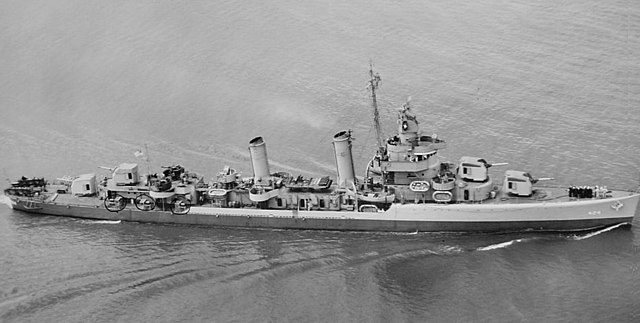
Laid down on 8 August 1938, Launched on 18 May 1940 and Commissioned on 1 August 1940, USS Niblack had about the same career as her sister: Europe and then Pacific lately. After shakedown and training she made her first convoy from NS Argentia in Newfoundland. By July 1940 she escorted troopships to Iceland. On 10 April 1941 she picked up three survivor’s boats from a torpedoed merchantman and later detected an U-Boat, depth charged under orders. U-52 fled the area. This was apparently the first action between US and German forces in World War II, part of the Atlantic “quasi war”.
With four other destroyers, she was escorting another fast convoy when on 31 October 1941, USS Reuben James was sunk by an U-Boat, and she picked up 44 survivors. Orderrs from then on was “sink without orders all Uboats”. But the attack on Pearl Harbor made it official. She went on with North Atlantic convoys, to Reykjavík, Derry, Greenock, and by July 1942 was transferred to the Caribbean and back north in August. By November 1942, shr took part in Operation Torch convoy escorts followed by coastal convoy escort duty.
Long story short she took part in the invasion of Sicily, operations near Gela, to Syracuse, fighting E-Boats, entered Palerm. Then bombardments of the Italian mainland, landings at Salerno and gunline on the Salerno campaign, assisted radio-guided bom damaged USS Philadelphia and Savannah. Chased U-boat off Bizerte. Assisted sank U-593. Left TF 86 for the landings at Anzio. Fought of Luftwaffe and E-boats plus human torpedoes. OVL New York, back Med in May, Southern Italy. Part of a hunter-killer group with her and Woolsey, Madison, Benson, Ludlow, starting ops by 18 May 1944. Destoyed U-960. Fighter-director training with USS Gleaves for the 8th Fleet, directed French and British planes on luftwaffe attacked on Allied, invasion of Southern France.
Assigned to TF 86 and “Flank Force,” support for 1st Airborne, Franco–Italian frontier up to 25 December 1944. She sank 43 mines, destroyed a German MAS boat, damaged four others in San Remo. Back Oran flagship DesRon 7, 8th Fleet and OVL Boston Navy Yard February 1945. Sailed out to the Pacific on 3 July 1945 , Pearl Harbor via San Diego and in training on V-Day. Escort to Sasebo, Japan, 22 September 1945, Matsuyama, and decomm. back home by June 1946, Atlantic Reserve at Charleston, then Philadelphia, stricken 31 July 1968, BU. 5 battle stars.
 USS Livermore DD 429
USS Livermore DD 429
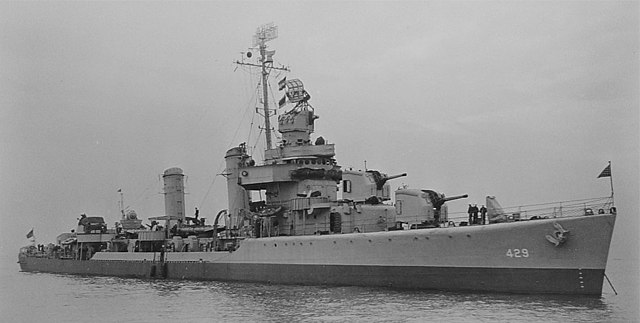
Often associated with a sub-class, USS Livermore was laid down on 6 March 1939 by Bath Iron Works, launched 3 August 1940, commissioned 7 October 1940 (LtCom. Vernon Huber) and after shakedown and brief training was assigned on 29 April 1941 to the neutrality patrol, escorting USS Wasp and tok part in Iceland convoys. She ws present when USS Kearny was torpedoed on 17 October. She had a temporary grounding on 24 November during a storm while having a “blue on blue” battery fire with a battery in Iceland. On 7 April 1942 she left New York for her first transatlantic escort mission to Greenock, Scotland and coastal patrol duty to the Caribbean. She took part in Operation Torch invasion convoys and was tasked there for ASW patrols. She was back in Norfolk by November.
Later she patrolled off Brazil, and made five escorts from 14 April to 17 January 1944 between New York and Casablanca. She was present for the Anzio Landings and on the gunline on 5 March. She rotated convoys between Algeria and Naples and took part in Operation Dragoon in southern France, 16 August. She was hit by a shore battery at Cavallaire Bay and silenced it. By 26 October she left Oran for overhaul in New York Navy. She made her last trip by 29 May, and was prepared for the Pacific. Departing New York on 22 June she was training when the war ended at Pearl Harbor. By 27 September she arrived in Japan with the 98th Division, occupation duty. She made trips to Saipan, the Philippines, Wakayama, and the Aleutians picking up discharged troops at Dutch Harbor and Attu Island to Seattle and San Francisco. She was discharged herself in Charleston on 18 January 1946, placed in reserve 1 May 1946, decommissioned but in limited service from 24 January 1947, Naval Reserve training, 6th Naval District, then 1st Naval District 15 March 1949 for training cruises. She ran aground off southern Cape Cod, 30 July 1949, refloated and discharged in Boston, 15 May 1950, inactivated, stricken 19 July 1956, cannibalized and used as testship for experiments off Indianhead, Maryland. Sold 3 March 1961 for scrap. 3 battle stars.
 USS Eberle DD 430
USS Eberle DD 430
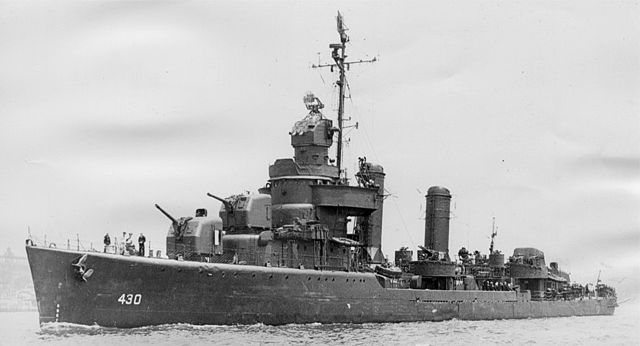
Laid down at Bath on 12 April 1939, launched 14 September 1940 she was Commissioned on 4 December 1940. USS Eberle after a short shakedown and training was assigned to patrol duty off Bermuda until August 1941, then Newfoundland for Icelandic convoys, Ireland and Scotland. From Norfolk on 23 August 1942 she escorted tankers to Cristóbal and from Trinidad to Belém. She started her first north african convoy on 25 October 1942, provided shore bombardment and fire support at Mehedia (Morocco) on 8 November. Then assisgned to South Atlantic patrol based on Recife, Brazil. 10 March 1943 intercepted German blockade runner Karin but lost all her boaridng party when her demolition charges exploded. She took up 72 prisoners. After OVL at Charleston, she returned for north African ports co,voys until 31 January 1944. Based in Naples on 11 March until May and by 20 April repelled an attack by German E-boats. She was in Malta on 13 August 1944 for the invasion of southern France, shalling the Porquerolles island until reddition of the garrison and sent a landing party that took 58 prisoners.
Back to New York on 6 November 1944, she escorted two convoys to Oran by April 1945, had an OVL overhaul 8 June and was prepared for the Pacific, arriving at Pearl Harbor on 20 July to join the aircraft carrier USS Antietam for plane guard duty and departed on 1 November for Alaska, stopp edin Petropavlovsk in December and back to Pearl Harbor. She arrived at Charleston on 8 February, placed out of commission, reserve 3 June 1946. 12 August Naval Reserve Training program in the 3rd Naval District. After being towed to New York in September, she was placed “in-service” 13 January 1947 and carried Naval Reservists on cruises to Canada, Caribbean, Bermuda and decommissioned 19 May 1950 but again in full commission by 21 November 1950, refit at Boston on 21 January 1951 for transfer to the Greek Navy under MDAP (Mutual Defense Assistance Program) as Niki, in service until stricken 1972. 3 Battle stars.
 USS Plunkett DD 431
USS Plunkett DD 431
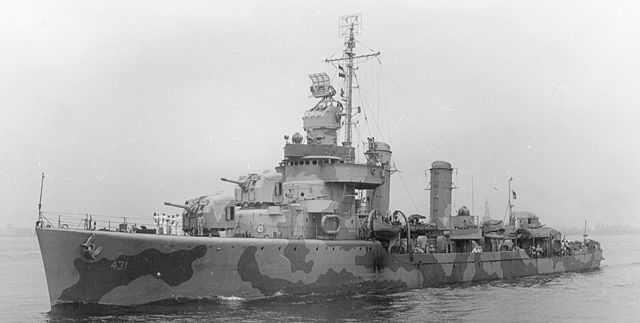
USS Plunkett was laid down on 1 March 1939 at Federal Shipbuilding and Dry Dock Co. in Kearny, New Jersey. She was launched on 7 March 1940, commissioned on 17 July 1940. Sh was assigned to neutrality patrols prior to 7 December 1941, Western Atlantic, Gulf of Mexico and Caribbean. She also blockaded out off Tampico the departure of several German steamers and cruised off Martinique (French Antilles) watching over Vichy French ships there. Patrol and convoy notably brought her to Reykjavík and Argentia.
Assigned to TF 39 on 20 March 1942 she departed the east coast for Scapa Flow, arrived in Orkney on 4 April and commenced operations with the British Home Fleet, North Sea patrols and the first leg of the Murmansk road until relieved by USS Mayrant, and reassigned to escort USS New York back home. By August she after UK-bound convoys she made her first run to North Africa, to Casablanca and patrolling off the Moroccan coast. She operated later in southern New England and back to Casablanca until May 1943 and Oran in Algeria with TF 60 while detached in May-July in a hunter-killer group in North African waters. On 6 July she left Mers-el-Kebir to take part in the invasion of Sicily screening TG 80.5, and Gela waters, Scoglitti, Palermo and TG 81.6 for the landings at Salerno. She also rescued and tried to save the bombed hospital ship HMHS Newfoundland.
After North Africa–Naples convoys until 21 January 1944, she was sent to Cape Anzio, drove off the Luftwaffe. but that day a new attack by Ju 88s had consequences as she took a 250 kg (550 lb) bomb hit and caught fire. She had 23 kill, 30 missing, many more wounded, extensive damage to her fire control, armament, and port engine. But she was saved, could sail to Casablanca for early repairs completed in New York. Via Belfast on 14 May until 3 June, she was sent training in the Channel for the D-Day landings. She screened transports off Omaha beach and brough fire support and patrol until 9 June and later multiplied shore bombardment missions, notably during the battle of Cherbourg with TF 129. On the 13th she mistook the British cable laying ship (1890) HMTS Monarch and its Canadian escort HMCS Trentonian for axis vessels before realizing its mistake. Her gunfire killed two, with 30+ wounded, including the Master. The ship was badly damaged, the cable was cut and lost, disrupting installation of communications to Normandy, quite a blunder.
In July, USS Plunkett was back to the Mediterranean for Operation Dragoon, carrying officials to and from the beaches, screening, then shore bombardment off St. Tropez, Port de Bouc, and Marseilles follwoed by Italian-French border patorls until 23 November. From Oran, she escorted a convoy back to New York on 16 January 1945. Back to training and ASW patrols, until May, she left UK, for the east coast, OVL, refresher and in the Pacific by 13 August via Panama Canal learning en route to San Diego V-Day. In September she escorted occupation forces and brough back troops from the Philippines and Aleutians, decommissioned 3 May 1946 in Charleston, Atlantic Reserve Fleet, then reactivated, transferred under MDAP to the Nationalist Chinese government on 16 February 1959 as ROCS Nan Yang (DD-17), until 1975. 5 battle stars.
 USS Kearny DD 432
USS Kearny DD 432
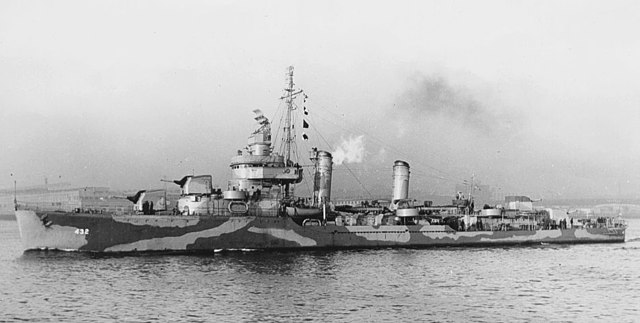
USS Kearny was launched 9 March 1940, by Federal Shipbuilding and Drydock Co. Kearny, New Jersey, commissioned on 13 September 1940. After shakedown and sea trials, she sailed on 19 February 1941, from New York Harbor to the Virgin Islands and start of her Neutrality Patrols off Vichy French Martinique until 9 March 1941, then off Puerto Rico, Norfolk until August and NS Argentia for North Atlantic convoys, HX 151, ON 24, SC 48, AT 18 and by October 17, 1941, while docked at Reykjavík, Iceland, a “wolfpack” attacked a nearby British convoy, and the Canadian escorts were soon unsufficient. USS Kearny and three other U.S. destroyers were asked to assist, which was tricky due to the quasi-war situation. Joining the action, USS Kearny depth charged sonar spots, and this went on during the night, cited by Hitler as a provocation. On 17 October she was hit by a torpedo by U-568 on her starboard, killing 11, injuring 22. The flooding was contained to the forward fire room (Gibbs & Cox proved their point there and the ecehelon arrangement for machinery became standard for DDs) and thanks to this they could leave by themselves the danger zone back to Iceland at 10 knots, by 19 October. Six days later she was fully repaired in Boston.
From 5 April to 28 September 1942, she escorted other convoys to Great Britain, down to Texas and Panama and the North African invasion, screening USS Texas and Savannah on fire support missions, notably off Safi (Morocco). In 1943 this was the same, via Port of Spain, Trinidad, Recife, Casablanca. On 25 November she joined USS Core “hunter-killer” task group and on 1 January 1944, depth charged and U-Boatn probable kill (oil slick). Back to the 8th Fleet in Algeria from 10 March she screened USS Brooklyn for fire support, 5th Army in Italy, Anzio beachhead, and she became part of the “Anzio Express” based in Naples, commended by General Mark W. Clark for their fire support. Her missions went on along the coast until the capture of Rome. Next she took part in operation Anvil Dragoon, southern France on 15 August, off Red Beach in Cavalaire Bay. Next she escorted troopships between Naples and southern France.
After several escorts between New York and Oran by 6 August 1945, she crossed Panama to the Pacific, Pearl Harbor, after V-day and escorted transports of occupation troops to Japan, Wakayama, 27 September. She travelled to the Philippines and Okinawa and returned to Pearl Harbor, San Diego, Panama Canal and was put in reserve at Charleston, decommissioned on 7 March 1946, then in Orange, stricken on 1 June 1971, sold 6 October 1972, BU. 3 battle stars.
 USS Gwin DD 433
USS Gwin DD 433
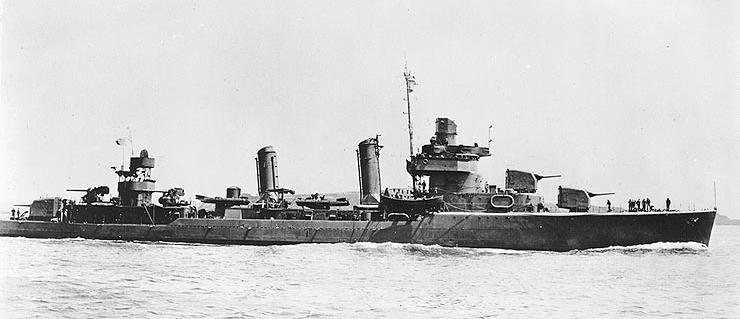
USS Gwin (DD-433) was third of the name, launched on 25 May 1940, commissioned at Boston on 15 January 1941. She was part of the batch effectively fighting in the Pacific. After shakedown on 20 April 1941 and post-fixes in Boston she started her round of neutrality patrols in the Caribbean and from 28 September 1941, North Atlantic, based mid-way at Hvalfjörður, Iceland. From February 1942 she was back to the Eastern Seaboard, ordered to the Pacific, via San Francisco. On 3 April 1942 she escorted USS Hornet, carrying 16 modified B-25 bombers for the Doolittle raid on Tokyo under command of Admiral William F. Halsey on USS Enterprise, RDV off Midway woth General Jimmy Doolittle aboard, launching the raid on 18 April earlier due to a spotter ship, some 600 miles east of Tokyo. The force rapidly retired to Pearl Harbor and were rapidly redeployed hoping to assist on 30 April 1942 USS Yorktown and Lexington at the Battle of the Coral Sea. They were back to Pearl Harbor on 21 May.
USS Gwin then will narrowly missed the battle of Midway. She departed on 23 May 1942 with Marine reinforcements for Midway and was bacl on 1 June and later joined the Fast Carrier Task Force off Midway. The battle was over when she arrived on 5 June. She launched a salvage party to assist saving the crippled USS Yorktown, until she was finished off on 6 June 1942 by a Japanese submarine, and she rescued all she could with USS Hammann, returning to Pearl with 102 survivor on 10 June. She departed on 15 July, screening fast carriers for the invasion of Guadalcanal from 7 August 1942. She escorted supply/troop reinforcements and patrolled “the Slot” and watched for the “Tokyo Express”. On 13 November 1942 she screened USS South Dakota and Washington taking part in the Savo Island battle, fighting IJN Kirishima, four cruisers, 11 destroyers escorting four transports (1st Naval Battle of Guadalcanal) whre she duelled with other destroyers and in the melee, fought at close quarters the light cruiser Nagara and Japanese destroyers Ayanami and Uranami, taking hell hits in her engine room, fantail and exploding depth charges. Later she escorted the nose-less Benham to Espiritu Santo and rescued survivors when she sank. After Nouméa (New Caledonia) she sailed to Hawaii, and an OVL at Mare Island Navy Yard, back in the pacific by 7 April 1943.
She escorted troopships and supplies in the Solomons, took part in the New Georgia invasion, supported landings off Rendova Island, duelling with Japanese shore batteries after being straddled and having one hitting her main deck aft, killing 3, wounding 7. She also laid a heavy smoke screen and repelled aerial raiders. But she met her fate at the Battle of Kolombangara, racing to the “Slot” on 7 July to rescue 87 survivors from cruiser USS Helena (Battle of Kula Gulf). She was part of Rear Admiral Walden L. Ainsworth intercepting the “Tokyo Express” force which developed as the Battle of Kolombangara on 13 July, helping to sink IJN Jintsu, but she was in the path of a Japanese volley of 31 “long lance” torpedoes at the American formation. USS Honolulu, St. Louis and Gwin turned right into their path and if the cruisers survived, USS Gwin received hit amidships in her engine room exploded, and she became crippled. Her suvivors were picked up later by USS Ralph Talbot took off Gwin’s crew after she was scuttled, all effort to save her being spent. 2 officers and 59 men went down with her. 5 battle stars.
 USS Meredith DD 434
USS Meredith DD 434
Meredith was laid down 1 June 1939 (Boston Naval Shipyard), launched 24 April 1940, commissioned on 1 March 1941. After her short Cuban shakedown, post-fixes at Boston on 8 June 1941 she was assigned to Destroyer Division 22 and patrolled along the southern coast until 20 September. From 28 September she was based at Hvalfjörður, Iceland, and escort ships up to the Denmark Straits. On 17 October 1941, she rescued survivors from the steamer Empire Wave. She left Iceland for Boston with a convoy, then to Norfolk by 18 February 1942 and escorted USS Washington, and USS Hornet with TF 18 to the Pacific.
In San Diego on 21 March, then San Francisco on 2 April after preparation she met TF 16 on 13 April for the Doolittle Raid on Tokyo, launched on 18 April and she was back in Hawaii on 25 April. On 13 May until 21 June Meredith she escorted fleet oilers to New Caledonia, and patrolled off Nouméa, escorting USS Tangier to Pearl Harbor. She departed Pearl on 15 August 1942 for Samoa, Pago Pago and escorted Transport Force 2 to the Solomons and Guadalcanal on 20 September, then patrolled the New Hebrides. She departed Espiritu Santo on 12 October 1942 under Commander Harry E. Hubbard, escorting a convoy with Alchiba, Bellatrix, Jamestown, Nicholas, and Vireo loaded with aviation gasoline and 500 Ibs bombs to Guadalcanal but were turned back by a Japanese carrier task force. Having only its surface-search Commander Hubbard decided however to press on and deliver its critical payload anyway after approval of the crew.
Unfortunately she was sighted by a Japanese patrol plane on 15 October, and after taking aboard the 68-man crew of Vireo, just hit and crippled, while preparing to torpedo her, she was attacked by 38 planes from IJN Zuikaku. After 3 minutes of dodging torpedoes she was struck by a bomb exploding beneath her bridge. She lost communications, steering and gun direction. A second forward hit her forward port side, detonating torpedoes below the ready ammunition locker, burning through pyrotechnics and and fuel oil leaking from her bunkers. Menwhile her AA gunners shoot down three but her fate was sealed when she took another 14 bombs and 7 torpedoes (as estimated by suvivors). She rolled over and sank in 10 minutes, wuth 8 officers and 73 enlisted men staying in water for three days in open sea and sharks until discovered and rescued by USS Grayson, Seminole and Gwin and a PBY Catalina on 19 October. 1 battle star.
 USS Grayson DD 435
USS Grayson DD 435
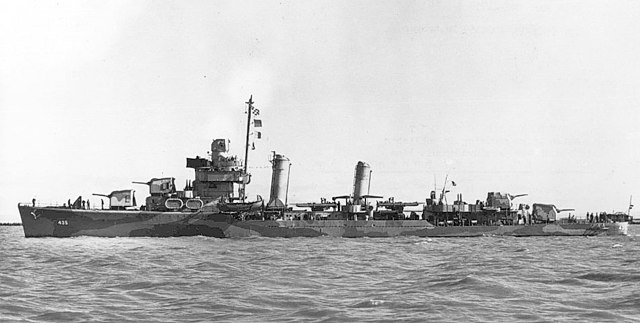
Laid down on 17 July 1939 at Charleston Navy Yard, launched on 7 August 1940, Grayson was commissioned on 14 February 1941. After shakedown she was assigned to DesDiv 22, Atlantic Fleet. On 28 August she became flagship, DesRon 11 in the Caribbean, neutrality patrols, then North Atlantic Newfoundland-Iceland from 26 October. In all ten months of escort missions until ordered to tge Pacific, San Diego, 2 April 1942, USS Hornet Carrier Group and the Doolittle Raid. After OVL in California on 5 July she escorted USS Enterprise and Hornet to Guadalcanal via Tongatapu. Campaign of Guadalcanal, defended USS Enterprise on 24 August. She claimed two attackers. She joined TF 11, USS Saratoga. 25 August, sighted a Japanese submarine surfaced, dropped 46 depth charges in five passes, probable kill. She escorted resupply ships and patrolled “The Slot” or radar picket duties and on 18 October rescued 75 survivors from sister USS Meredith
Back to Pearl Harbor on 15 April 1943 for OVL she resumed service from New Caledonia, 24 September, claimed several Japanese barges at Kolombangara with DesRon 21 and had another OVL in Puget Sound on 16 December and returned to the Pacific, Majuro Atoll (Marshall Islands) on 10 February 1944. She patrolled in the Carolines and Marshalls for six months. Covered the landings at Pityilu Island, Admiralties in April. Fighter-director ship for the landings at Tanahmerah Bay, New Guinea. In July, pounded Biak Island, Noemfoor Island before landings. 1 September 1944 joined TG 38, Palau Islands. Next took part in air raids over Okinawa and the Philippines. 15 October rescued 194 men from USS Houston. 3 November, assignd radar picket off Saipan, and SAR. Sent to Seattle on 9 June 1945 for OVL, back to Pearl Harbor 1 September 1945 and back home, transiting Panama to Charleston, 16 October. Hosted 5,000 visitors on Navy Day. Decommissioned 4 February 1947, reserve, stricken 1972, sold 12 June 1974, BU. 13 battle stars.
 USS Monssen DD 436
USS Monssen DD 436
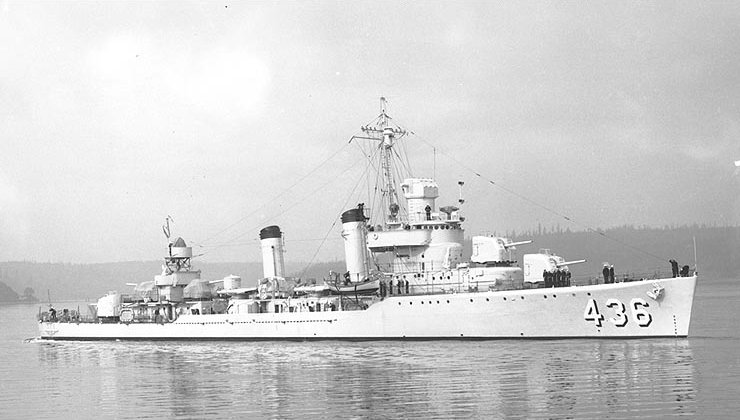
Monnsen was laid down on 12 July 1939 on the west coast, Puget Sound Navy Yard (Bremerton, Washington), launched on 16 May 1940, commissioned on 14 March 1941 under Lt. Cdr Roland N. Smoot. After shakedown and training, assigned to the Atlantic Fleet on 27 June 1941 in DesDiv 22 she made five months of neutrality patrols in the northwestern Atlantic, to Iceland, and until 9 February 1942 and an OVL in Boston Navy Yard. She was assigned to the Pacific Fleet, transiting tp San Francisco on 31 March 1942 and joined TF 16. Escorted USS Hornet Carrier group for the Doolittle Raid. From 30 April she escorted USS Yorktown and Lexington at the Battle of the Coral Sea but this was over when she arrived. She returned briefly to Pearl before her deployment to Midway and by 2 June, TF 16 met TF 17 350 miles northeast, the battle starting on 4 June, until 7 June.
Next she took part until mid-1943 to the entire Solomon Islands campaign. First she was in the Tonga Islands and on 7 August Guadalcanal and Tulagi. On 7–8 August with Buchanan dhr patrollred Gavutu and Tanambogo, covering the 2nd Marine Regiment in an amphibious assault and the eastern approaches to Sealark, Lengo, and Nggela Channels. She was enearby during the Battle of the Eastern Solomons, and escorted the damaged USS Saratoga to the Tonga Islands. Back to Guadalcanal on 18 September she escorted supply ships and 8 November, departed Nouméa with two cruisers, two destroyers as TG 67.4 (RADM Admiral Daniel J. Callaghan) as escort up to Lunga Point on 12 November. The transports unladen in the afternoon under IJN torpedo plane attacks. She sailed to Espiritu Santo, however Callaghan turned back to help outnumbered Admiral Scott and started the Naval Battle of Guadalcanal.
On 13 November, VADM Hiroaki Abe was spotted 3 miles (4.8 km) north of Kukum to shell Henderson Field and the Battle became furious at 01:50. Monssen fired five torpedoes at IJN Hiei hitting her on her port side and second salvo of five at an unidentified ship (which was USS Atlanta) and fortunately missed. At 02:00 she start firing at all Japanese warships spotted by projectors and in fire. At 02:03, Hiei fired point-blank at USS Monssen with main and secondary batteries. Caught under spotlight she was hit by 39 shells and completely destroyed. 20 min. later she was completely immobilized and abandoned. The last 8 men still aboard were rescued and survivors (40%) were picked up and brought to Guadalcanal. She sank, still ablaze, in the afternoon. 4 battle stars. The wreck was rediscovered in 1992 by Robert Ballard.
 USS Woolsey DD 437
USS Woolsey DD 437
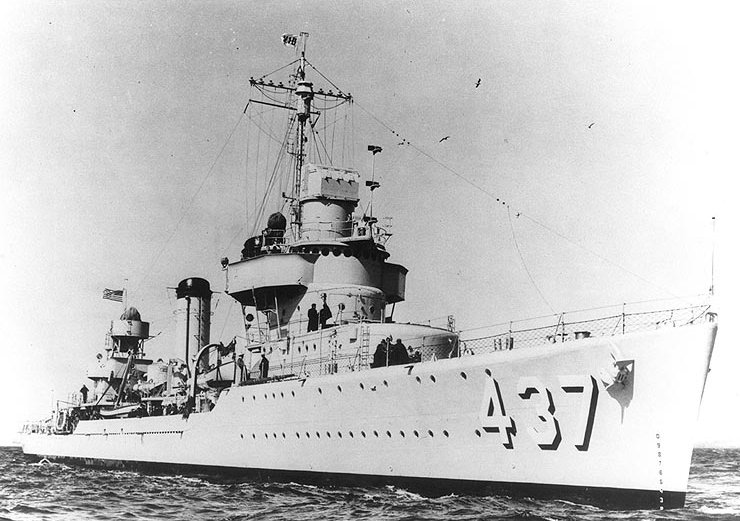
USS Woolsey was laid down on 9 October 1939 at Bath, Maine, launched on 12 February 1941, commissioned on 7 May 1941. After Carribean shakedown she was assigned to the Atlantic Fleet Neutrality Patrols for a short time from September to December 1941. She also screed the newly commissioned USS North Carolina and escorted convoys to Iceland. Next to the British Isles and Puerto Rico until the fall of 1942 and Operation Torch with DesRon 13, Center Attack Group and Fedhala landing force followed by antisubmarine patrols. On 11 November, U-173 sank Joseph Hewes and until 16 November other attacks went on but that day she spotted and attacked U-173, which escape. But she repicked her and she was destroyed. Back home for eastern seaboard off New England she restarted to transatlantic convoys by mid-January 1943 with UGF-4 to Casablanca, GUF-4 to New York and others.
Based in Gibraltar she joined the 8th Fleet for the invasion of Sicily, Licata landing beaches, gunfire support, notably claiming an enemy railroad battery. Mid-August, she swapped to Salerno, Southern Attack Force fire support group with five cruisers, 4 destroyers of DesRon 13. Afterwards routine escort missions resumed between Naples and North African ports. On 16 December she sunk U-73, escued and made POW 23 survivors. January 1944 saw her in the Fire Support Group, Anzio landings. She went back home for an OVL, via Gibraltar and Horta, Azores to Boston, 25 February until mid-March, refresher training off Maine, Gibraltar and Oran in May. For three months, she performed ASW patrols and with an hunting group (Benson, Ludlow, Niblack) she spotted and attacked U-960 on 17 May and respotted on the 19th, attacked by a British Wellington and attacked on surface, submerged, depth charged, damaged, resurfaced, crew evacuated before she sunk again for good. 21 POW. July-August saw her in action off South France for Operation Dragoon.
Next she supported the 1st Airborne TF toward Italy and supported the liberation of Cannes on 24 August, followed by operations on the Franco–Italian coast until late October and more operations in the area until mid-January 1945. Via the Azores she was back in New York on 23 February 1945, prepared for the Pacific. After retraining and preps in June she crossed Panama on 7 July, San Diego, and learned about V-Day at Pearl Harbor. She escorted occupation troops to Japan, Sasebo, and made port visits at Manila, Shanghai, Okinawa, and Saipan, repatriating troops until 3 November. In Charleston on 4 December, she was inactivated, decomm. 6 February 1947, Atlantic Reserve Fleet then Boston October 1957, stricken 1 July 1971, sold for BU 29 May 1974. 7 battle stars .
 USS Ludlow DD 438
USS Ludlow DD 438
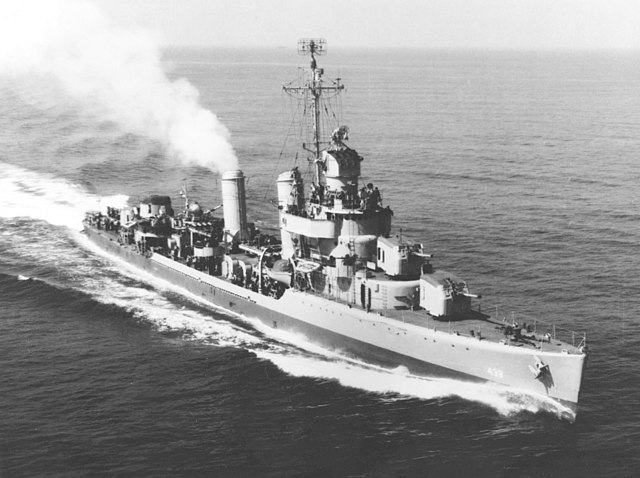
USS Ludlow was laid down 18 December 1939 in Bath Iron Works, launched 11 November 1940, commissioned at Boston 5 March 1941. After shakedown, from Boston by October 1941she headed for neutrality patrols in the north atlantic, Newfoundland and Iceland. From 7 December she escorted ships to Derry, Liverpool, Greenoch, and even Freetown in South Africa. By October 1942, she took part in Operation Torch with TF 34, Cape Fedhala (Morocco) on 7 November 1942. She dealt with shore batteries and Vichy French air and naval attacks, at the Naval Battle of Casablanca. She was hit by a 6-inch shell forward and straddling shots until Augusta and Brooklyn sunk the French ships. Next was Operation Husky after repairs in New York, training off Maine, escorting a convoy to Casablanca. On 10 July, she gave fire support off Licata and Porsa Empedocle and 11 August downed a Luftwaffe bomber.
Next was the invasion of Italy on 9 September, Salerno where she was commended by her accurate and decisive close range fire support. After convoy duty between Naples and Oran until 11 January 1944 she was back at Anzio on 22 January, repelling counterattacks by the air, splashed two bombers, one fighter, three rocket glider bombs but took a 5-inch shell through her torpedo director deck and pilothouse. Chief Gunners Mate James D. Johnson managed to retrieve and disposed of the the hot, unexploded shell overboard. After repairs-OVL in New York, training she was back in the Mediterranean on 20 April, ASW patrols. On 19 May she destroyed U-960 surfaced by gunfire. From 11 she took part in Operation Dragoon in southern France. She screened USS Augusta 25-30 August off Marseilles. Off Monaco, she she destroyed floating mines and E-boats, suicide boats and human torpedoes, capturing three operators on the latter on 5 September. After plane guard duty off African west coast she had an OVL in Boston on 28 February, back to UK escorted LSTs until recalled for the Pacific.
Through Panama on 27 June, Pearl Harbor on 17 July, training to join the fast carriers until V-Day. Escorted convoys with occupation troops, Wakayama (27 July) and stayed there until 3 November, repatriated GIs from the Aleutians (“Magic Carpet”), returned on the east coast, decom. 20 May 1946 at Charleston, but used for reserve training. Full decom. on 6 June 1950, but reactivated status, refurbished and modernized, decommissioned 22 January 1951, transferred to the Royal Hellenic Navy as Doxa (D20). Career ended in 1972. 6 battle stars.
 USS Edison DD 439
USS Edison DD 439
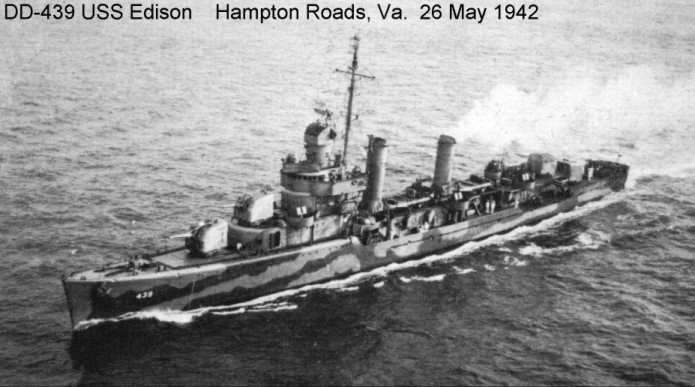
USS Edison was launched 23 November 1940 at Federal Kearny, commissioned 31 January 1941 (Lt.Cdr. A. C. Murdaugh) and after shakedown and east coast training, she went on with neutrality patrols from NS Argentia, convoy to Iceland. February 1942 saw her with ON 67 from Iceland to Halifax, combating three U-boats. 24 October 1942 saw her with Op. Torch, Fedhala landings, 8 November, dealing with shore batteries and French ships at Cape Fedhala, Naval Battle of Casablanca, firing 362 rounds, all director-controlled with average range 9,500 yards, to 14,000 yards and 12,500 yards, with a sustained rapid fire of 268 rounds, so 12 rpm without a hitch. She later escorted tanks to Gulf ports and convoys from New York City and Norfolk to Casablanca-Oran.
From July 1943 to February 1944 she took part in the landings in Sicily, escorted support convoys from Algiers and Bizerte, took part in the invasion at Salerno, provided fire support and co-claimed U-73. On 21 January 1944 she was off Anzio for patrol and fire support until home for overhaul, back on 1 May 1944, escort work off Italy, followed by the invasion of southern France. She rampaged and patrolled the Iatlo-French border. Back to NyC 17 January 1945, overhaul, then coboy convoy to Le Havre in April-May. Departing NyC she was sent to the Pacific, learning about V-Day as she trained at Pearl Harbor. Occupation troopship escorts, Nagoya, then weather station Aleutian and back to San Francisco on 30 December 1945, east coast training, decom. at Charleston, 18 May 1946, then Philadelphia, from 1962, sold for BU 29 December 1966. 1 battle star.
 USS Ericsson DD 440
USS Ericsson DD 440
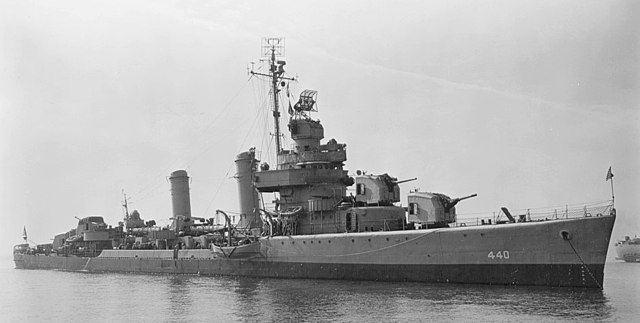
Ericsson was launched on 23 November 1940 by Federal Kearny, commissioned on 13 March 1941. Shakedown, training from HP Norfolk, May 1941, East Coast-Bermuda Naval Reserve midshipmen cruises and tranining with submarines, battle practice. Fall 1941 she made two runs from Newfoundland to Iceland escorting convoys, and patrols off NS Argentia by January 1942, rescued survivors from SS Dayrose and USCGC Hamilton on 30 January. February 13, collided with trawler Græðir off Reykjavik, the latter sank, rescue six. Escorted a convoy to Panama May 1942, to Ireland-Scotland in June and coastal east coast-Caribbean, Puerto Rico. October she sailed to take part in Op. Torch in North Africa, landings in Morocco, fire suppor, enemy batteries and back to Norfolk. OVL In Charleston, and by May 1943, convoys to Casablanca. She took part in the invasion of Italy, escorts and Anzio gunline, Gulf of Gaeta. Next, invasion of southern France from Malta with British ships. Covered the amphibious landings 15-17 August, escreened HMS Ramillies to liberate Corsica and gunline along the French coast, patrols, interceped trawler with U-230 crew, scuttled in the area. Back to Oran, Azores escort duty, Gibraltar, and NyC, overhaul in fall 1944.
Refresher training, escorted convoy to Oran April 1945, Boston in 5 May, started a last submarine hunt, USS Block Island group. Sank U-853. Prepared for Pacific, training Caribbean, Pearl Harbor, departed to Saipan, arrived 13 September 1945. Then to Okinawa, Japan, Philippines, Japan on escort, Sasebo brought back home servicemen to San Diego. Charleston 5 December 1945, decommissioned 15 March 1946, reserve. Later sold, BU. 3 battle stars.
 USS Wilkes DD 441
USS Wilkes DD 441
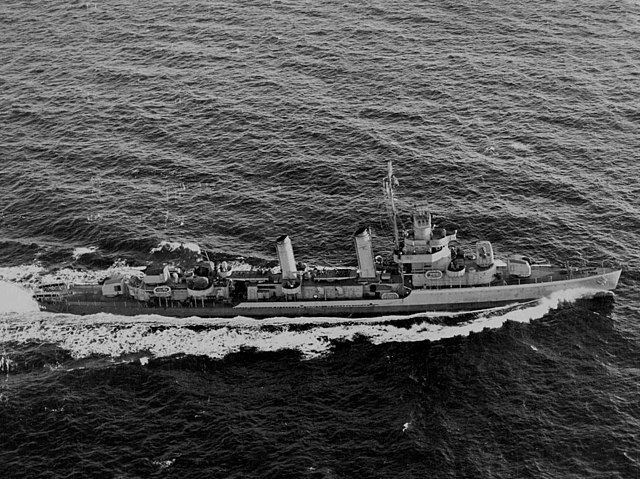
Third of the name, USS Wilkes was laid down on 1 November 1939 at the Boston Navy Yard, launched on 31 May 1940, commissioned on 22 April 1941. On 1 June 1941 after shakedown training off New England she was sent to Bermuda in August to screen USS North Carolina and Washington on their shakedown cruises. After extra training in Cuban waters in October she was sent to New York and Casco Bay, NS Argentia, escorting Convoy HX 162 to Iceland, making several runs. Resplenished in Boston, she returned to Newfoundland with Convoy HX 169, later based in Derry. Next this was Convoy ON 59 and an OVL in Boston. On 18 February 1942 she was grounded on the fog as Pollux or Truxtun, but the latter were totally lost. By April 1942 she joined TF 21, escorting USS Augusta for the Argentia Conference. She later collided with the oil tanker SS Davila. In the summer she escorted Convoy BX-26 and patrolled Newfoundland.
Next she was with Convoy AS-4, had spottings and made depth charge attacks, rescuing survivor. On 17 July, other sound contact, this time claimed unknown U-Boat.
She entered Norfolk on 25 July, made two coastal runs and back to Halifax and Greenoch until 5 September. Next she trained with TF 33. On 24 October she departed for Operation Torch, covered landings on 8 November 1942 at Fedhala, and taked part in the Battle of Casablanca, reassigned to TF 34 as control vessel. She also made an U-boat attack and duelled with a French destroyer from Casablanca, destroyed the shore battery on Pointe d’Oukach. On 11 November she chased another sub as on the 12th, 13th and 15 November. On the 30th she was back in Norfolk. Next year started with escorts New York-Casablanca and back and New York-Norfolk until May 1943. By January 1944, she escort ships to Panama and back. She transited and escort ships to Bora Bora and Nouméa, then New Guinea by 20 February 1944, and then Cape Gloucester. She covered the 1st Cavalry Division there.
She carried troops to the Wakde–Sarmi area of New Guinea and joined TF 77 as radar picket. On 22 April 1944, she took part in the landings of Tanahmerah Bay, Wakde Island, Biak Island, Schouten Islands, gunline on Aitape and Toem, landings at Noemfoor Island, Cape Sansapor before heading for the Marshall Islands, Eniwetok on 25 August 1944, joining TF 38 for raids on Iwo Jima, Saipan, Yap, Ulithi, Peleliu, and Formosa, Luzon, Leyte on 17 October and took part in the battle of Samar Island on 24 October. She joined TG 38.4 and took part in the battle of Cape Engaño. After resplenishment she sailed to Guam, Manus, and escorted Convoy GE-29 to Eniwetok before heading back to Pearl Harbor and via Puget Sound OVL at Todd’s Pacific Shipbuilding Co., Seattle until 28 January 1945.
She screened USS Franklin, proceeded to San Francisco, Pearl Harbor and took part in exercises and drills with USS Shangri-La. By March, she joined USS New Mexico to Ulithi and Guam, then Saipan, for two trips until 27 April. Next she escorted a convoy to Okinawa, Hagushi anchorage in May, and Kerama Retto and in May she covered carriers for strikes on Nansei Shoto. She escorted USS Makin Island to Kerama Retto and returned to patrols and covering carrier strikes on Nansei Shoto. By July 1945 until V-Day she stayed with TF 38. She operated with TU 30.8.9 off the Mariana and Bonin Islands. In September she was at Okinawa, with TG 70.6 and proceeded to Korea, Jinsen (now Inchon), used as “taxi”. On 21 October 1945 she sailed to Saipan on 27 October, Hawaii and San Diego, then Charleston on 2 December 1945, Inactive Fleet, moored for preservation, decom. 4 March 1946, stricken 16 September 1968, sold on 29 June 1972. 10 battle stars, with a balanced service in the Atlantic and Pacific, which was rare.
 USS Nicholson DD 442
USS Nicholson DD 442
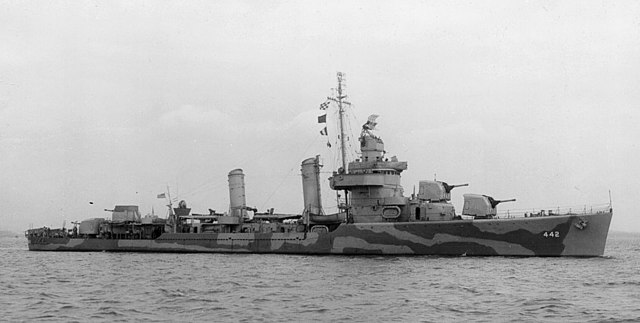
USS Nicholson was laid down on 1 November 1939 at Boston Naval Shipyard, launched on 31 May 1940, commissioned on 3 June 1941. After shakedown, eastern Atlantic, she started escorting north atlantic convoys (HX 160, ON 41, HX 173, ON 67, AT 17 and AT 18) from Boston to Newfoundland and to Scotland and England, until fall 1942. Next she was to take part in the Casablanca landings, but her turbine broke down and she missed the initial operations. She was there four days later on 12 November for the consolidation, patrol, Bizerte campaign and the assaults on Salerno, repelling the Luftwaffe. Five months later she was overhauled at Boston and prepared for the Pacific. Leaving Boston in January 1944 she corss Panama, San Diego and sailed to Pearl Harbor before assigned to a convoy to New Guinea in February, LSTs for the the Cape Gloucester campaign. She escorted successive assaults on coastal points and islands with gunfire support and did the same in the Admiralties until Seeadler Harbor fell. While shelling Hauwei Island she was hit in return by a 4-inch (102 mm) shell landing in No. 2 ammunition handling room, killing 3, wounding 4, but silence the battery.
In August 1944 she was assigned the 3rd Fleet for the Marshalls Campaign. She screened fast carriers in the Bonins, Formosa, Philippines, supported the invasion of the Palaus, neutralization of Yap and assisted the 7th Fleet for the invasion of Leyte, taking part in the Battle for Leyte Gulf before leaving for Pearl Harbor and Seattle for OVL. Back in February 1945 she escorted vessels between Guam and Ulithi and took part in the campaign of Okinawa in March, notably as radar picket, and escape kamikazes, rescued survivors from USS Little and Morrison. She was with the 3rd Fleet (TF 38) for final air strikes against the home islands and at V-Day was off Honshū. She was in Sagami Wan on 29 August, Tokyo Bay on 15 September and back to San Diego on 6 November, then Charleston, Atlantic Reserve Fleet. She was decommissioned on 26 February 1946, Naval Reserve training ship (3d Naval District) on 30 November 1948. She won 10 battle stars for her WW2 services.
In reserve training ship, Brooklyn NyD Nicholson she became a backdrop for the big-screen musical “On the Town” (Frank Sinatra, Gene Kelly, Vera Ellen, Ann Miller, Betty Garret) at the start and last scene. Recommissioned on 17 July 1950, she was decommissioned for MDAP transfer to the Italian Navy on 15 January 1951 as Aviere (D 554) and converted as experimental gun ship in 1970, stricken, sunk as a target in 1975.
 USS Swanson DD 443
USS Swanson DD 443
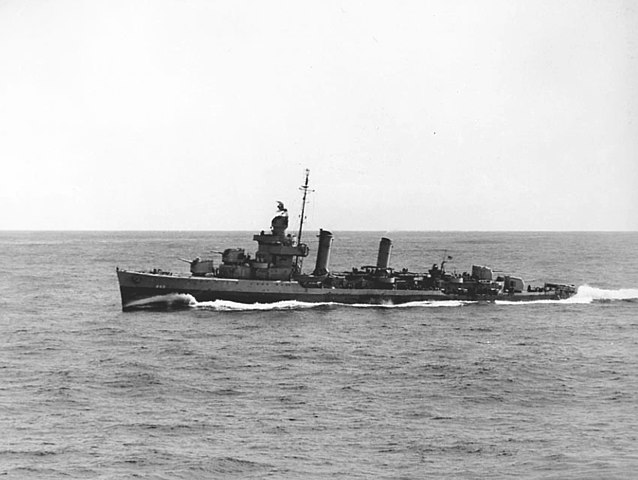
Swanson was laid down on 15 November 1939 by the Charleston Navy Yard, launched on 2 November 1940; sponsored by Mrs Claude A. Swanson, widow of Secretary Swanson; and commissioned on 29 May 1941. After shakedown cruise, shortened training, she started right away convoy escorts from New England to Bermuda and later Iceland as well as USS Washington and North Carolina, USS Hornet in sea trials. Post-December she made three runs to Scotland, Nova Scotia and Greenland. From October 1942 she took part in Operation Torch, on 8 November 1942 off Fedhala. She was targeted by French shore batteries and dealt with these. Next she took part in the naval battle of Casablanca, when seven French destroyers sallied out to attack the transports. They targeted USS Ludlow, Wilkes and Swanson, and Ludlow was hit and withdrew but Swanson and Wilkes were soon joined by USS Augusta and Brooklyn and they came back opening fire, ending the matter decisively, while USS Massachusetts later dealt with Jean Bart.
On 11 November while on patrol she was reported an attack by U-130 and U-173, sinking four transports and on the 16th Woolsey got sonar contact, attacked and later turned the contact over to Swanson and Quick, which sank U-173. Next she was in Atlantic convoy duty (HX 158, ON 37, HX 165, ON 51, HX 172, ON 65, AT 17, ON 115, UGF 1) until July 1943 and took part in Operation Husky, off Licata. On 10-11 July she collided with Roe while searching for radar contacts. The damage was considerable, she had a flooded fire room and lost all power. After regaining control she retired to Malta for temporary repairs and sailed to Brooklyn Navy Yard for completion, resumed Atlantic escorts until 7 January 1944, rassigned to the Pacific.
She was asked to join the 7th Fleet off New Guinea and there, provided gunfire support at Seeadler Harbor (3-7 March), became command ship at Hollandia (22 April), gunfire support at Noemfoor (2 July) and command ship at Sansapor (30 July). She left the area late August and joined TF 38 (USS Franklin, Enterprise, San Jacinto group) for air strikes on the Bonins, Ulithi, Yap, Palau, Okinawa, Taiwan, the Philippine landings and the battle of Leyte, San Bernardino Strait Battle and later Cape Engaño, Luzon. 26 October 1944 saw her detached to escort a patrol group at Saipan and spent the rest of the year and early 1945 with SAR missiones and ASW patrols, radar picket missions, between Iwo Jima and Saipan and HQ for the commander. She was back in April 1945 for OVL, Puget Sound and back for the Iwo Jima post-Campaign operations. She repatriated GIs and sailed back home on 9 September 1945, decommissioned on 10 December 1945, reserve at Charleston, stricken 1 March 1971, sold 1972. 8 battle stars.
 USS Ingraham DD 444
USS Ingraham DD 444
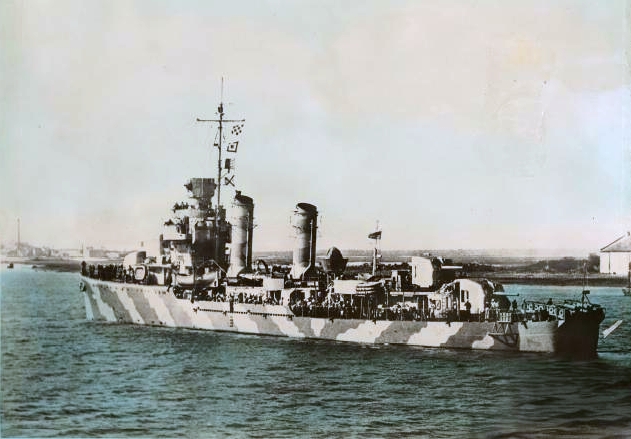
USS Ingraham was launched on 15 February 1941 at Charleston Navy Yard, commissioned on 19 July 1941, under Lt.Cdr William M. Haynsworth, Jr., and after shakedown, East Coast training, she started convoy escort missions from December 1941 and until mid-1942, to Iceland and UK, making a few U-boats picks and attacks but no kill. Her career was shortened by fog; While in T-20 convoy from Halifax to Scotland on 22 August, still underway close to Nova Scotia she received an erroneous U-Boat report. She tried to pick it up in heavy fog but this night she was detached to investigate a collision between USS Buck and a merchant vessel, and soon collided herself with the oil tanker Chemung. The latter rammed her, she sank almost immediately when her Depth charges exploded. Only 11 men survived. She was struck on 11 September 1942, earning no battle star.
Sub-class Bristol (Repeats)
(In writing)
 USS Bristol DD 453
USS Bristol DD 453
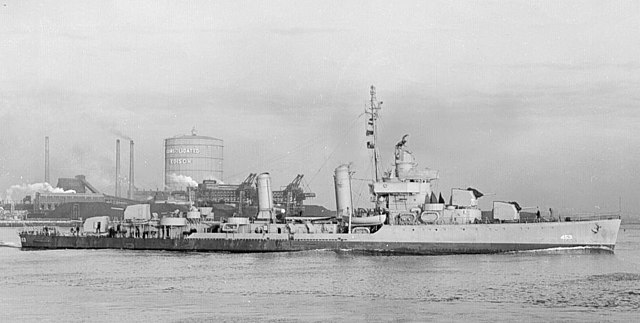
USS Bristol (DD 453) was launched on 25 July 1941 by Federal Shipbuilding, Kearny, New Jersey, commissioned on 22 October 1941. Patrol and convoy escort, North Atlantic. Operation Torch. HP Norfolk until 14 January 1943. Mediterranean until 13 October 1943. Operation Husky, Salerno landings. Shore bombardment, destroyed the Italian Navy armed train (“treno armato”) T.A. 76/2/T at Licata. Hit by torpedo from U-371 (Waldemar Mehl) abandoned, sank 52 losses. 3 battle stars.
 USS Ellyson DD 454
USS Ellyson DD 454

Built in Kearny, launched on 26 July 1941, commissioned on 28 November 1941. Atlantic patrols, Halifax, West Indies, Panama. Flag DesDiv 10 and MineDiv 20. Escorted USS Ranger, Operation Torch. Operations with the Royal Navy, escorted South Dakota and Alabama British Home Fleet, Scapa Flow, Murmansk-Iceland convoys. Feint invasion of southern Norway. Screened Iowa, escort Teheran Conference. Escorts to Bahia, Freetown, Dakar, Port Royal, Boston. Attacked U-616, sunk by gunfire. DD-Day, support Pointe du Hoc, battle of Cherbourg. Operation Dragoon SFrance 15 August. Boston conversion to high-speed minesweeper DMS-19 15 November 1944. Pacific, Okinawa, radar picket line. July 1945 flagship East China Sea TG. Tokyo Bay, occupation duty, Buckner Bay command ship, Norfolk, Charleston reserve 1948, training duty, Mediterranean 6th Fleet 1949-1953, DD-454, decommissioned 19 October 1954, transferred MDAP 20 October, JMSDFS Asakaze. 1970 to Taiwan cannibalized. 7 battle stars.
 USS Hambelton DD 455
USS Hambelton DD 455
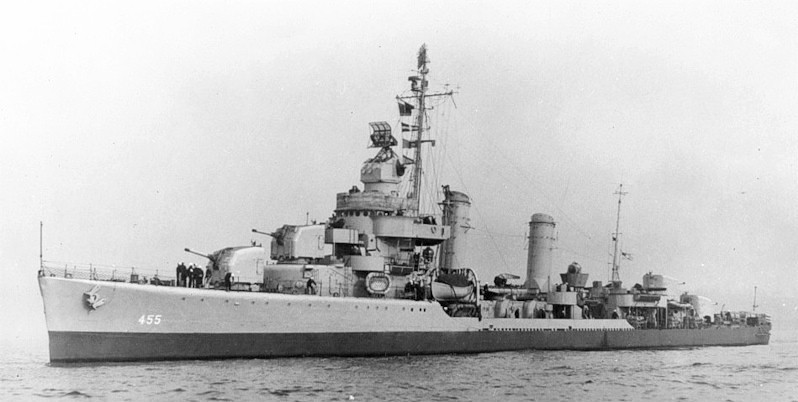
Hambleton built at Kearny, launched 26 September 1941, commissioned on 22 December 1941. Shakedown southAM, ASW patrols, East Coast. Ecorted Augusta and Ranger to North Africa. 17 May collided with Ellyson, repaired Charleston. Convoys New York-Ireland. Joined Royal Navy, escorted HMS Duke of York. Operation Torch, screened USS Sangamon 8 November, Fedala. Hit 11 November by U-173. Towed to Casablanca floating dry dock by Seabees, tugged to Boston 28 June 1943. Back to Oran April 1944, then Normandy invasion. Sank U-616 on 17 May. Escorted LSTs 7 June Omaha Beach. Attacked E-boats, sank one severely damaged another. Battle of Cherbourg. Mediterranean, Naples, Operation Anvil. Back to Boston 8 November conversion DMS-20. Pacific, Ulithi 9 March 1945, invasion of Okinawa. Damaged 3 April by kamikaze. Ryukyu Islands campaign, East China Sea. Tokyo Bay 28 August. Rode out four typhoons. Norfolk December 1945. Postwar Caribbean-East Coast service, Mediterranean 6th Fleet, decom. 15 January 1955, Atlantic Reserve Fleet, DD-455, stricken 1 June 1971, sold 22 November 1972. 7 battle stars.
 USS Rodman DD 456
USS Rodman DD 456
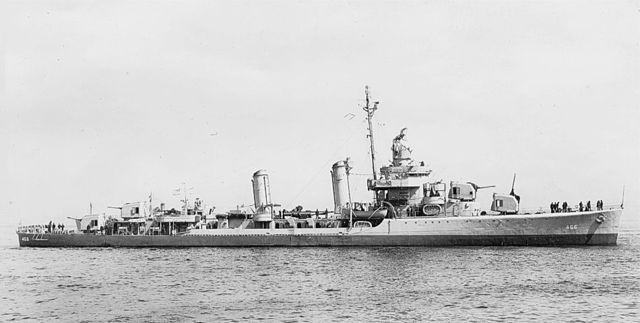
Built in Kearny, launched 26 September 1941, commissioned 27 January 1942. Joined TF 22 NS Argentia, escorted Ranger, ferried 33rd Pursuit Squadron to Gold Coast May 1942. Based Scapa flow, TF 99, escorts Scotland and Iceland Murmansk PQ/QP convoy lanes. Operation “Easy Unit”farrying RAF planes to Kola Inlet in August. OVL Boston, joint TG 34.2, TF 34, Operation Torch, escorted USS Santee. 2 more ferry runs to Africa; Western Atlantic Argentia-Panama service. Back Home Fleet, patrols Scotland-Iceland, screening HMS Duke of York, USS South Dakota, USS Alabama luring out Tirpitz. Escorted USS Iowa to Teheran Conference. Joined TG 80.6 Med hunter-killer group. Destroyed U-616 surfaced. Joined CTU 126.2.1 for Operation Neptune (Overlord) 4 June escorted convoy B-1, Omaha Beach, joined TG 122.4, battleof Cherbourg. Operation Dragoon, TU 85.12.4 from Taranto. Boston, conversion to DMS-21 16 December 1944. Pacific, operation Iceberg, Kerama Retto, Okinawa. 6 April kamikazed crashed into port bow (16 Kia, 20 wd), downed 6. Repaired FDD Kerama Retto, Charleston. War ended, 3 years east coast training and Mediterranean. DD-456 15 January 1955, decom. 28 July 1955 transferred as ROCS Hsien Yang (DD-16), lost 1970. 5 battle stars.
 USS Emmons DD 457
USS Emmons DD 457
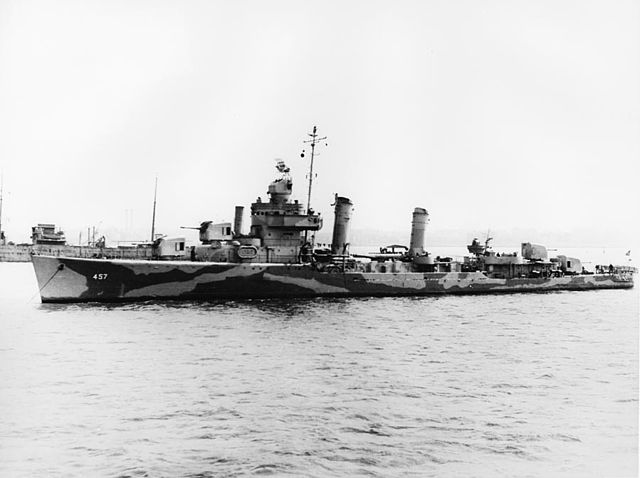
Built at Bath Iron Works Corp., Bath, commissioned 5 December 1941. Patrols New England waters, escorted Ranger to Gold Coast. NS Argentia escorts, Boston-Halifax, Iceland. Escorted HMS Duke of York to Iceland-Scapa Flow, Scottish coast patrol. Murmuanks, Kola Inlet, Greenock. NyC, Bermuda, screened carriers Op. Torch, landings at Safi. OVL, convoy from New York to north Africa. May 1943 back Home Fleet, northern waters, watch for Norwegian bases, guarded British carriers. Escorted Iowa to Teheran Conference. HK group, sank 17 May U-616. D-Day Operations, screening USS Texas. Battle of Cherbourg with TF 129. Convoys to Mediterranean, Operation Dragoon, patrols Italy, Corsica. Boston, converted DMS-22. Pacific, Ulithi, invasion of Okinawa. 6 April hit by 5 kamikaze. Crippled and ablaze, long crew fight (Navy Unit Commendation), 60 Kia 77 wd, abandoned, torpedoes 7 April. 5 battle stars.
 USS Macomb DD 458
USS Macomb DD 458
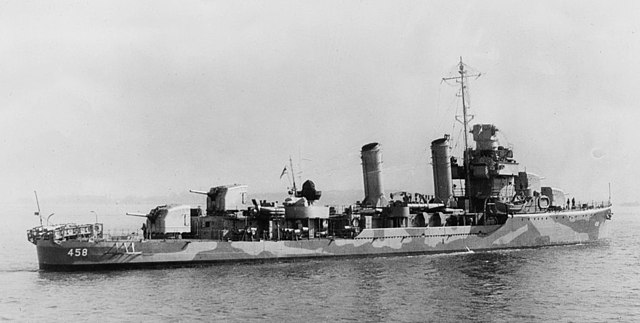
Built Bath Iron Works, launched 23 September 1941, commissioned 26 January 1942. East coast, screened aircraft carriers. South America, West African coast, Newfoundland, Scotland, Iceland. Back Norfolk Caribbean patrols, Operation Torch, carrier screen. Convoys east coast-Caribbean, north Africa, North Atlantic patrol. British Home Fleet, Azores, Freetown, Dakar, Bermuda. 18 May 1944 72-hour submarine chase, sunk U-616. Operation Dragoon. Charleston 9 November, conversion DMS-23, MineRon 20. Pacific, 3 January 1945, TG 52.2 to Okinawa. 27 April attack, splashed 3 Kamikaze. 3 May one crashed into her (7 Kia) awarded the Navy Unit Commendation. Repairs Saipan. 3d Fleet, Japanese home islands raids. Tokyo Bay surrender. Minsweeping missions Yellow Sea, Chosen Straits. Back Norfolk, Atlantic Fleet duty, 6th Fleet Mediterranean, HP Charleston. Reserve July 1954, decommissioned MDAP transfer as Hatakaze (DD-182) JMSDF and back in 1969, sold ROCS 6 August 1970 as Hsien Yang (DD-16), discarded 1978. 5 battle stars.
 USS Forrest DD 459
USS Forrest DD 459
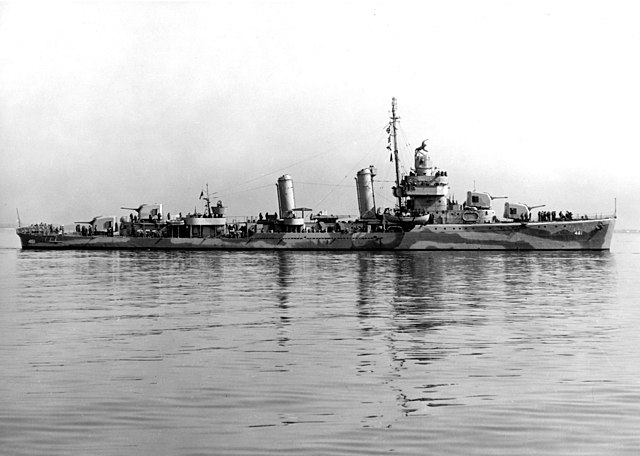
USS Forrest was launched on 14 June 1941 (Boston Navy Yard) commissioned 13 January 1942. Started escorts from NS Argentia, and with USS Ranger to West Africa, and later Bermuda for Operation Torch, Safi, Casablanca, Fedhala, HP Norfolk. Still with Ranger group up to Scapa Flow and 4 October raid on Bodø, Norway. Mediterranean-Scapa Flow and coast of Norway to Kola inlet; OVL Boston 3 December 1943, early 1944 training precommissioning crews for new destroyers, escorting USS Hornet shakedown. Atlantic hunter-killer group USS Guadalcanal. Northern Ireland, British Isles service, Normandy invasion: Utah Beach. Operations off Cotentin Peninsula, shore batteries. August 1944 invasion of southern France. Escorts Palermo, Naples, Ajaccio, Oran. Norfolk 8 November 1944 conversion to high speed minesweeper DMS-24. Pacific 17 January 1945 San Diego, Pearl Harbor, Ulithi 9 March 1945, Okinawa. 27 May down two kamikaze, third crashedr starboard side (5 Kia, 13 Wd) but damage control efficient. Sailed to Kerama Retto then Boston 6 August 1945, but decommissioned 30 November 1945 sold 20 November 1946. 6 battle stars.
 USS Fitch DD 462
USS Fitch DD 462
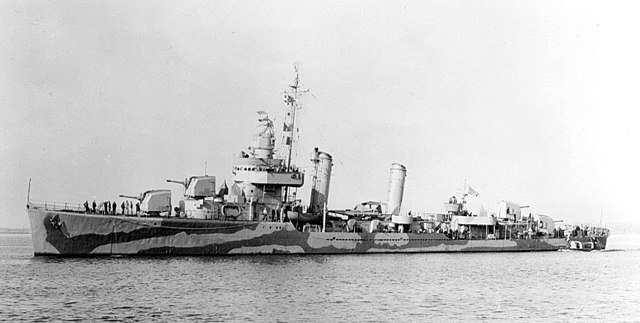
Fitch was launched on 14 June 1941 (Boston) commissioned on 3 February 1942 and by August 1942 escorted Ranger to the Gold Coast. Later Bermuda in October with Ranger group, Op. Torch, Fedhala 8 November. Back Norfolk exercizes Casco- Chesapeake Bays, coastal escort duty until fall 1942. 2 more runs with Ranger to Africa. NS Argentia and Scapa Flow, Iceland. Sept 43 escorted convoy to Derry, Thurso Bay, and Scapa Flow two more months, attack on Bodø, patrols Spitzbergen. Boston December 1943, Caribbean escort, hunter-killer group to April 1944. Prep Normandy invasion, 6 June Utah Beach until 19 June. Convoy escort Belfast-Oran. Taranto 11 August 1944, invasion of Southern France. Escorts Naples, Palermo, Oran, Gibraltar, Marseilles. 3 January 1945 converted as DMS-25.
Pearl Harbor 10 February 1945, Ulithi, (propellers badly damaged coral, Repairs Pearl Harbor til 6 August) missed Okinawa ops. 3rd Fleet, Tokyo Bay 28 August, surrender 2 September, East China Sea, San Diego 23 December, Norfolk, Charleston, New York transferring minesweeper crews, then regular ops training Mine Force officers, ToDs Mediterranean 1949, 1951, 1953. 1955 tests for Operational Development Force. Decommissioned 24 February 1956, reserve, later stricken and BU. 5 battle stars.
 USS Corry DD 463
USS Corry DD 463
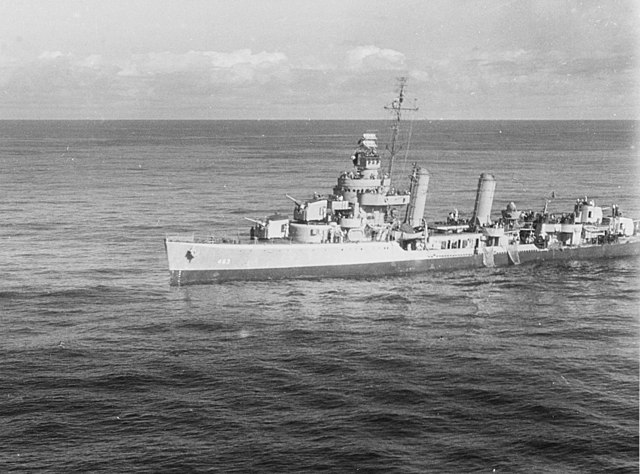
USS Corry launched 28 July 1941 Charleston, commissioned 18 December 1941. Special operations with Radio Washington, Annapolis 18 to 21 May 1942, escorted RMS Queen Elizabeth New York. Bermuda, Newfoundland, Newport summer ASW patrols, coastal patrol/escort Caribbean-Bermuda, headed 25 October for Casablanca landings, USS Ranger. OVL Boston, coastal escorts til February 1943, more trips to north Africa. 11 August joined Home Fleet, Ops. Norway, Ranger group, Bodø raid. Iceland, Murmansk convoys. Back home, service New Orleans-Panama until 16 February 1944. Hunter-killer ops TG 21.16. Sunk U-801. Picked survivors U-1059. Boston on 30 March 1944 overhaul. Preps Normandy invasion, lead destroyer task force, fire support Utah Beach. 6 June duelled with German shore batteries down to 1,000 yards from the beach, suffered 210mm (8-inch) hits engineering spaces amidships, rudder jammed, steam lost; sank rapidly, keel broken, abandon ship. Survivors rescued by Fitch, Hobson, Butler, and PT-199. 24 Kia 60 wounded. 4 battle stars.
 USS Hobson DD 464
USS Hobson DD 464
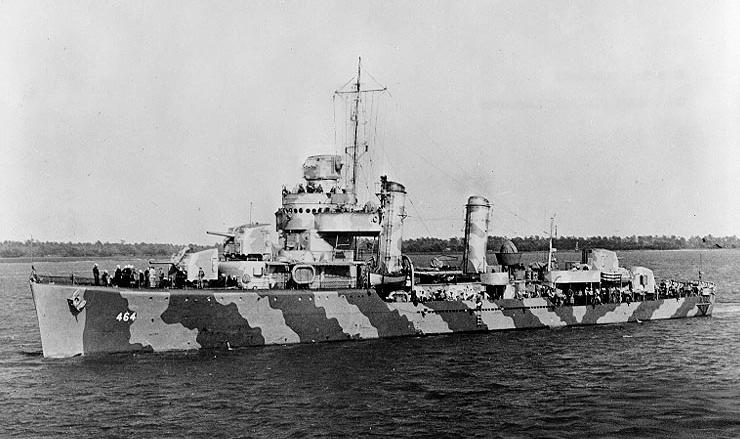
Hobson was built at Charleston (cost $5 million), launched 8 September 1941, commissioned 22 January 1942. Flag DesDiv 20 (USS Forrest, Fitch, Corry) and DesDiv 19 made in DesRon 10. After shakedown training Casco Bay escorted USS Ranger to Africa. Next Operation Torch with TG 34.2 Airgroup (Ranger, Suwannee, Cleveland), TF 34 Western Naval Task Force tp Morocco. Witnessed the Naval Battle of Casablanca, spotted French submarine Le Tonnant, dropped DCs. Back to Norfolk, Casco Bay, Panama Canal and back with Ranger early 1943, ASW group western Atlantic. Portsmouth, NS Argentia, escorted RMS Queen Mary to Quebec Conference. Operation Leader, Bodø from Scapa Flow. Hunter-killer anti-submarine duty with USS Bogue (CVE-9). Norfolk, joined Operation Neptune, Utah Beach, Assault Group “U”, Bombardment Group 125.8 to “Point Mike”. Duelled with shore batteries, hit amidships. Temp. Repairs taer, took part in the Bombardment of Cherbourg, TF 129.Jobson praised for accuracy. Assembled Northern Ireland to Mediterranean, TG 120.6, Mers-el-Kébir, Taranto, and Operation Dragoon. Next Palermo convoy duty. Assisted S.S. Johns Hopkins. October-November converted as DMS 26. San Diego, San Francisco, Pearl Harbor 11 February 1945, MinDiv 58, MinRon 20 TU 18.2.3 Ulithi for Operation Iceberg (Okinawa).
13 April 1945 radar picket station. Kamaikaze attacks on her and USS Pringle. Hobson hit by bomb on starboard side. Fires gunnery workshop, machine, electrical shops, 4 kia 6 wounded. Under control after 45 minutes, rescued Pringle’s 258 survivors. Back Ulithi 29 April 1945, Pearl Harbor for repairs, San Diego, Norfolk on 15 June, learned surrender.
From February 1946 mine-sweeping operations, East Coast-Caribbean, amphibious/mine warfare operations, exercizes RCN late 1948. Korean War, June 1950, plane guard screening ship. Joined USS Wasp (CV-18) off Newfoundland, night flight operations en route to Gibraltar. Course changed, USS Hobson rammed by Wasp, broke in two. 40 survivors aft section. Worst non-combat accident since USS Cyclops. Court of Inquiry. 6 battle stars.
 USS Aaron Ward DD 483
USS Aaron Ward DD 483
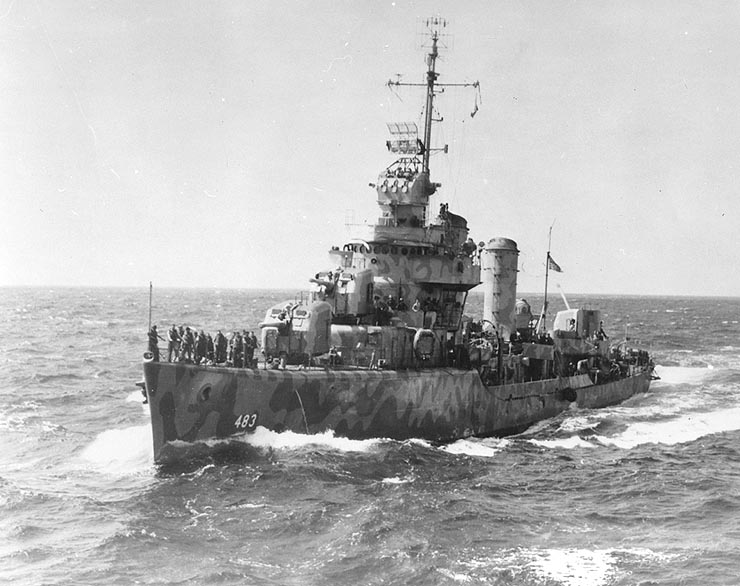
Aaron Ward built at Kearny, launched 22 November 1941, commissioned 4 March 1942. Part of the batch sent to the Pacific, 20 May 1942, San Diego. Part of VADM William S. Pye TF 1 (4 BBs + USS Long Island). Tonga Islands with TF 18, escort duties, escorted USS Cimarron (AO-22) to Nouméa. 2 sub contacts, DC attacks. Guadalcanal: Was there when USS Wasp was torpedoed by I-19 15 September 1942. Lunga Roads, shore bombardment, attacked by five enemy bombers, shot one. Assisted USS Chester sunk by I-176. Later screened USS Atlanta, flag, off Lunga Point. Took part in the Naval Battle of Guadalcanal, 13 November 1942. Had two near misses torpedoes, narrowly avoided San Francisco fired on IJN Akatsuki but received 10+ direct hits and cleared the area, lost steering 0225, latter spotted Hiei, but restarted, met tug Bobolink, until respotted by Hiei, more damaged, but lost sight, joined Tulagi harbor, temp. repairs, Hawaii. Back February 1943, escorted USS Ward and LSTs from Russell Islands to Savo. Air raid at Guadalcanal. Near miss, one hit engine room, lost control, hole port side, rudder, two near misses port side, 20 Kia, 59 wounded, 7 MiA. Sank, rescued. Rediscovered 4 September 1994. 4 battle stars.
 USS Buchanan DD 484
USS Buchanan DD 484
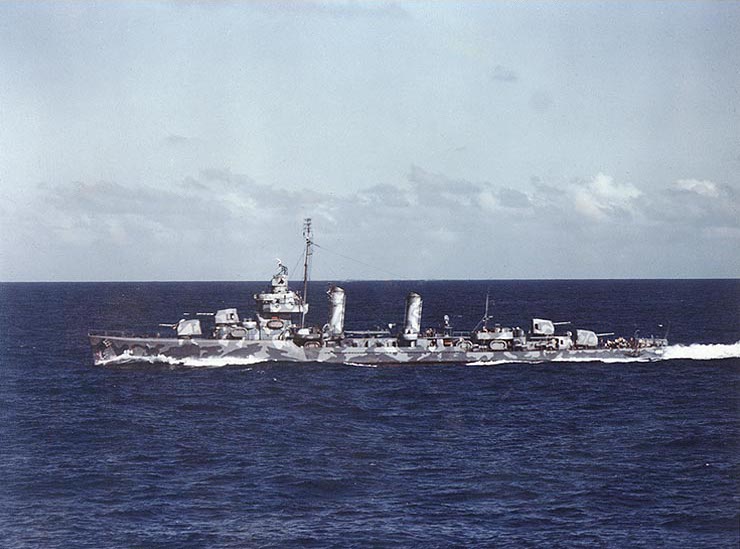
USS Buchanan was launched on 22 November 1941 (Kearny) commissioned on 21 March 1942. She started service in the Pacific from 28 May 1942. Landings at Guadalcanal and Tulagi, Battle of Savo Island, joined TF 64.2, landings of Funafuti Island. Battle of Cape Esperance. Friendly fire at the initial stages of the Naval Battle of Guadalcanal. Repaired Austrlia, convoy escort duty until February 1943. TF 15, New Georgia Operations. Bombardment of Munda (12 July) and the Battle of Kolombangara (collided with Woodworth). Treasury-Bougainville operation, sank IJN sub RO-37. Bismarck Archipelago operation. Philippines Campaign. Southern Palaus, damaged typhoon. Ops Luzon, Formosa, and the China coast, Iwo Jima and Okinawa. Presidential Unit Citation, 16 battle stars. Decom, recom 11 December 1948 Charleston, transferred 28 April 1949 Turkish Navy as TCG Gelibolu (D-346), stricken 1976.
 USS Duncan DD 485
USS Duncan DD 485
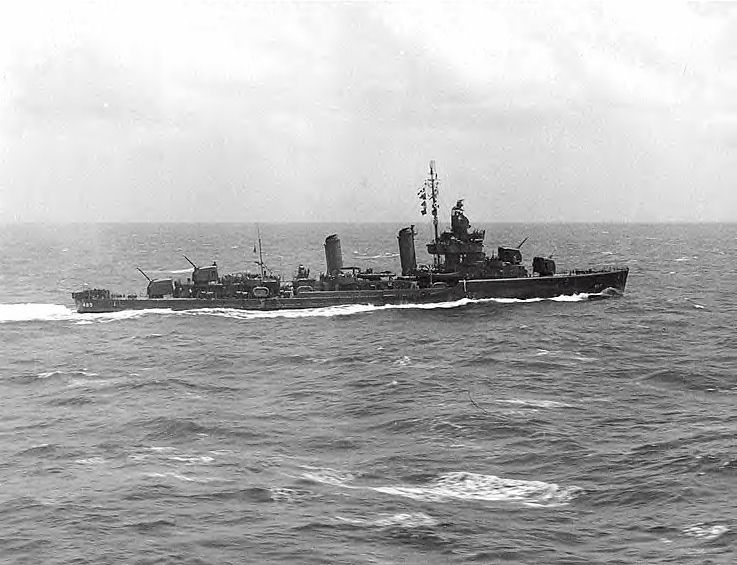
USS Duncan launched 20 February 1942 (Kearny), commissioned 16 April 1942 Lt. Cdr Edmund B. Taylor. June 1942 South Pacific, Espiritu Santo, escorted 7th Marine Regiment to Guadalcanal, screened USS Wasp when torpedoed. Full Solomons campaign. 11 October screened TF 64, Battle of Cape Esperance, hit a cruiser, shifted fire to a destroyer, dodged two torpedoes from Furutaka, but received many hits, destroyed. CO later awarded the Navy Cross for his evacuation, staying on ship to the last, attempted to beach her on Savo Island but abandoned ship, sank 12 October 1942. 195 rescued. 1 battle star.
 USS Landsdowne DD 486
USS Landsdowne DD 486
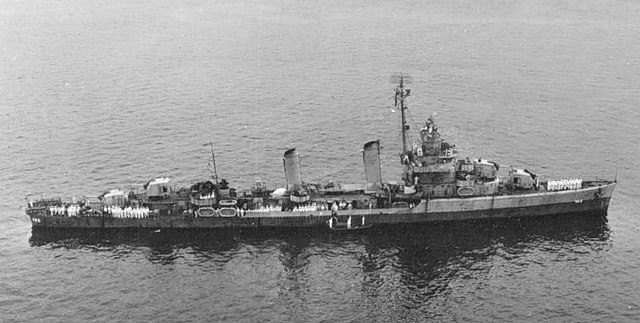
Built at Kearny, launched 20 February 1942, commissioned 29 April (Lt. Cmdr. William R. Smedberg III). Atlantic seaboard made an U-Boat attack on Cape Hatteras 3 July. ASW patrol Panama sunk U-153. South Pacific, Tonga, Nukuʻalofa Bay, TF 18, USS Wasp screen. Rescued 447 of Wasp’s crew and sank her with torpedoes, clearly showing the defaults of the Mark 14 torpedo. TG 64.1, occupation of Funafuti and screened various task forces, British Solomons, destroyed landing barges, shore bombardment. Escort to Sydney, Auckland, Nouméa. Grounded in the Russells 26 February repairs San Francisco. Aleutians Campaign, Kiska. Espiritu Santo, Vella Lavella, Solomons, Fiji; Buka-Bonis, Rabaul, Empress Augusta Bay, Torokina, Bougainville, Green Island. Sank a 6,800-ton Japanese cargo ship off New Hanover. Joined TFs 77-78 Aitape–Hollandia–Tanahmerah, New Guinea, Palau, Yap, Ulithi. Majuro, TF 58, Marianas Campaign, Bonins, Battle of the Philippines in June, Guam, Tinian. OVL Washington, back Ulithi 29 October 1944. Western Carolines until 5 May 1945, Okinawa Campaign. Surrender Tokyo Bay, repatriated POWs to USS Missouri. Yokohama, back home via Cape Town, Brooklyn NyD 6 December 1945. Charleston, decommissioned, Atlantic Reserve Fleet 2 May 1946, 10 June 1949 transferred Turkish NavyTCG Gaziantep, stricke 1973. 12 battle stars.
 USS Lardner DD 487
USS Lardner DD 487
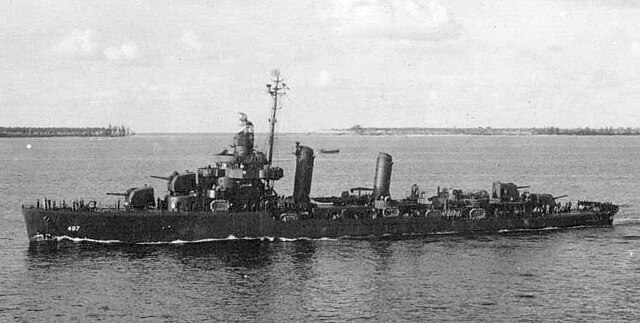
Laid down 15 September 1941 (Kearny), launched 20 March 1942, commissioned 13 May. New England exercizes until July 1942. Patrolled for U-boat. August 1942 South Pacific, Tongatapu, screen for convoys to Nouméa and Espiritu Santo. Guadalcanal, shore bombardments. TF 18 assisted USS Wasp, torpedoed 15 September. Lunga Point attacks. TF 7, Battle of Tassafaronga. OVL in Nouméa December. Escorts Espiritu Santo, Purvis Bay, Guadalcanal. 17 February repelled air attacks. Convoys to Fiji, Espiritu Santo. TF 15, Pearl Harbor in May, OVL. Bremerton, San Francisco in July, Samoa, Pearl Harbor, Pago Pago, joined TF 37, Espiritu Santo, Vella Lavella. Escorts New Caledonia-Solomons, Bougainville Campaign. TF 38, Green Island. Attack on Rabaul, Karavia Bay, Kavieng (shrapnel damage); Palaus raid, landing at Hollandia, Ops at Guam, Saipan, Tinian, Bonin raid, Battle of the Philippine Sea. OVL Bremerton. Until March 1945 convoys between Ulithi, Eniwetok, Leyte. Ran aground 9 January, repaired Ulithi. Patrol station Pelelieu-Angaur. Screened raids to Okinawa and Formosa, east coast. Saipan August 1945, Okinawa, Tokyo Bay. Ocupation duties until 15 October, sailed for home via South Africa. Was in NyC February 1946, Charleston, decommissioned 16 May 1946, Atlantic Reserve Fleet, transferred 10 June 1949 as TCG Gemlik (D 347), diescarded 1974. 10 Battle stars.
 USS McCalla DD 488
USS McCalla DD 488
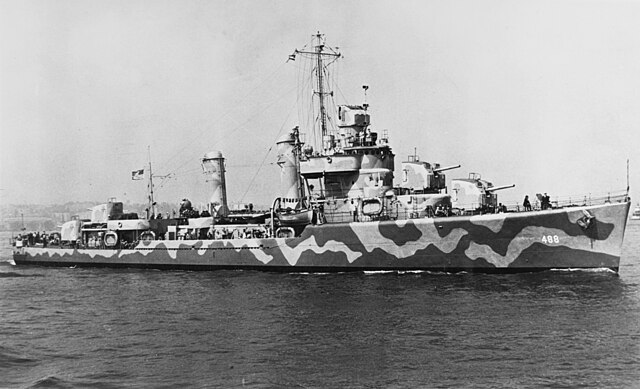
A Kearny ship, launched 20 March 1942, commissioned on 27 May 1942. Escorted a covoy from Cape May, New Jersey to NyC 19 July 1942. ASW patrols mid Atlantic coast, escorted oilers to Aruba, thtn reported ComSoPac 28 September, HQ Nouméa. Solomons Campaign, TF 64. Battle of Cape Esperance. She rescued 195 of Duncan’s crew. Destroyed IJN barges at Tassafaronga Point. Escorts to the Fiji, New Hebrides, Solomons, New Georgia campaign. 30 June destroyed 2 Japanese aircraft. Rice Anchorage operation, gunline Munda airfield. Collided with USS Patterson. Repaired Purvis Bay, Mare Island. Back Ops January 1944, Majuro, Marshalls Campaign. Attached Carrier fleet TF 58: Marianas, Bonins, Palaus, Philippines, Formosa, Okinawa. Detached, Convoys Ulithi, Eniwetok, Pelelieu, Manus, Leyte. Inter-island escort duties Philippines, to Netherlands East Indies. Last Ops western Carolines. OVL Portland, deactivation, January 1946 Charleston, decommissioned 17 May, recom. 11 December 1948, transferred as TCG Giresun (D 345) stricken 1973. 10 Battle stars.
 USS Mervine DD 489
USS Mervine DD 489
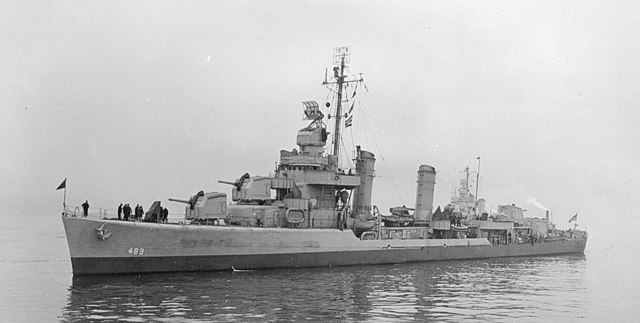
From Kearny, she was launched on 3 May 1942, commissioned on 17 June 1942. After shakedown training she reported for coastal escort HP New Orleans from August 1942. October TF 34, Op. Torch, Safi. Next seven months coastal and transatlantic convoys. June 1943 TF 65 North Africa, TF 85 Operation HUSKY. Resumed North Atlantic and Mediterranean escorts. For convoy KMF25 flagship when attacked by German bombers off Algeria 6 November 1943, rescued over 600 survivors from two ships sunk. May 1945 Philadelphia Navy Yard conv. DMS-31, Pacific but arrived at Okinawa 28 September 1945, cleared mines Kyūshū, Honshū and back San Francisco March 1946. 2 years west coast and March 1948 Yokosuka, Tsingtao, for escort. Same 1949. Decom. 27 May 1950, Pacific Reserve Fleet, San Diego. DD-489 15 July 1955, Columbia River Reserve Group, Bremerton, stricken 31 July 1968, sold 1969. 3 battle stars.
 USS Quick DD 490
USS Quick DD 490
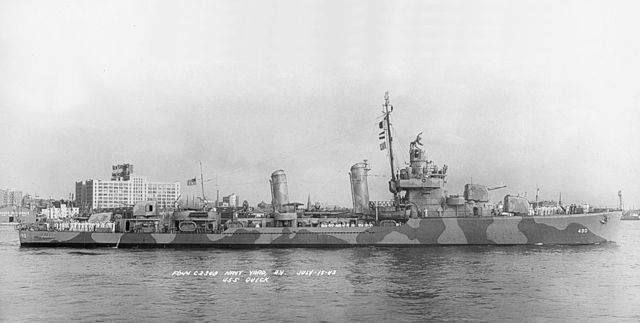
USS Quick was from Kearny, launched 3 May 1942, commissioned 3 July 1942. Shakedown New England, HP New York 6 September 1942 Caribbean-Gulf Mexico escort. October Norfolk, TF 34 for Operation TORCH. 14 November Casablanca and 16th, assisted sunk U-173. Next six months coastal/trans-Atlantic convoys. Operation HUSKY. 13 June 1945 conv. Charleston DMS-32. San Diego, arrived after V-Day, went on for Pearl Harbor, Eniwetok, Sasebo, nine-month TOD China coast, Okinawa and Japanese waters. Marianas December 1946-February 1947. Marshall Islands and Marianas for three months and inactivated for 8 months, decomm. 28 May 1949, DD-490, stricken 15 January 1972, sold 27 August 1973, BU. 4 battle stars.
 USS Farenholt DD 491
USS Farenholt DD 491
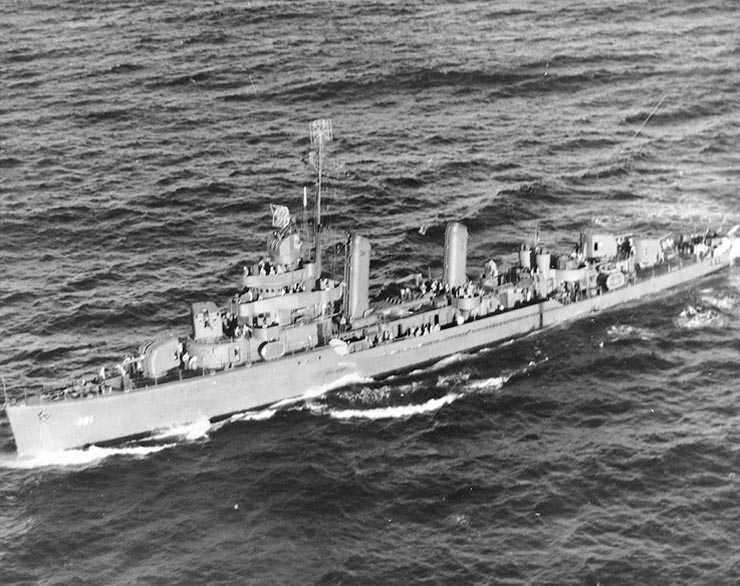
Farenholt was launched on 19 November 1941 (Bethlehem Steel Company, Staten Island, New York), commissioned 2 April 1942. Shakedown, sent Pacific, San Diego July 1942, Tonga Islands, USS Wasp TF, invasion of Guadalcanal, flag DesRon 12. Torpedoing 15 September, rescued 143 survivors; Reinforcement of Guadalcanal, Battle of Cape Esperance, sank a Japanese destroyer, received three hits (3 kia, 43 wd), crippled, to Espiritu Santo 13 October. New Hebrides, Solomons, Lunga Point; 7 April attacked by 14 torpedo bombers, claimed 1, same on 13 May. New Georgia operation. Escort missiones 1943, OVL West Coast, back June 1944, Guam, Palaus operation, Philippines Campain. Assault on Leyte, Battle for Leyte Gulf. Still flag DesRon 12, Western Carolines/Marianas Patrol Ulithi-Kossol Passage. May 1945, Okinawa, screened carriers. Raids Japanese home islands, southern Ryukyus. Back Charleston, decom. 26 April 1946, stricken June 1971, sold November 1972. 11 battle stars.
 USS Bailey DD 492
USS Bailey DD 492
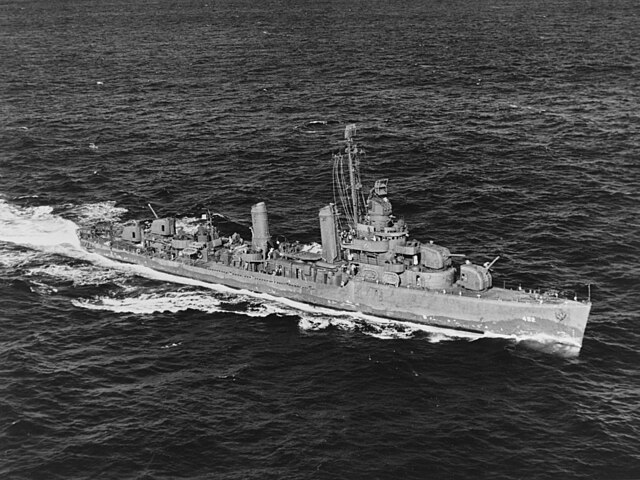
Launched 19 December 1941 (Bethlehem Steel), commissioned 11 May 1942, assigned Pacific Fleet (CDR John Atkeson). TF 8 Aleutian Islands. 12 January 1943, Amchitka. 26 March Battle of the Komandorski Islands L. Scored hits on Nachi, three 8-in in return (5 Kia, 6 wd) (Navy Unit Commendation). repairs Dutch Harbor, Mare Island. Back 16 October 1943. Until October 1944 invasions of Tarawa, Maloelap and Kwajalein, Marshall Islands, Saipan, Tinian, Marianas, Peleliu and Angaur, Palau. Attacked October 1944 on picket duty (9 killes, 16 wd), repaired Mare Island. Back 24 December 1944, landings on Mindanao, Borneo. 11 December back Boston, decom. 2 May 1946, stricken 1 June 1968, sunk as a target 4 November 1969. 9 battle stars.
 USS Carmick DD 493
USS Carmick DD 493
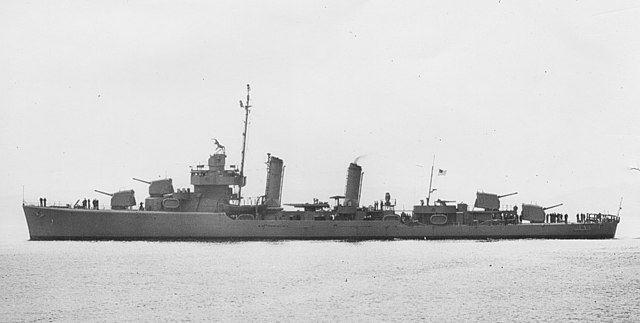
Launched 8 March 1942 (Seattle-Tacoma), commissioned 28 December 1942. HP San Diego February 1943, Norfolk in March, Atlantic escort service from April 1943, NS Argentia, NyC, Casablanca. Derry, Aruba, screened US Hornet, USS Wasp to Trinidad. Hunter-killer ops for DesRon 18. 2 April 1944 two depth charge attacks on sound contact. 18 April, sent Plymouth. 6 June, flanks of Omaha Beach, ASW/E-boat screen, close gunfire support, until 17 June and 10 June downed Heinkel bomber. Mediterranean 18 July 1944, Op. Dragoon in August. 18 August, destroyed enemy E-boat. OVL NyC, Casablanca-Oran. June 1945 converted at Philadelphia Navy Yard DMS-33. 27 August 1945 dept. Norfolk, arrived Okinawa 15 October, minesweeping Yellow Sea. Back 20 April 1946, San Diego. Tout of duty in the Korean War with TF 95 HP Yokosuka, fire-support/minesweeping until 3 December 1950, Chinnampo (Navy Unit Commendation). Back San Diego 21 November 1951. 2nd Korean TOD Yang Do Island, Songjin, until February 1953. OVL, Fleet Sonar School, San Diego. Decom. 13 February 1954. 3 battle stars WW2, 5 battle stars Korea.
 USS Doyle DD 494
USS Doyle DD 494
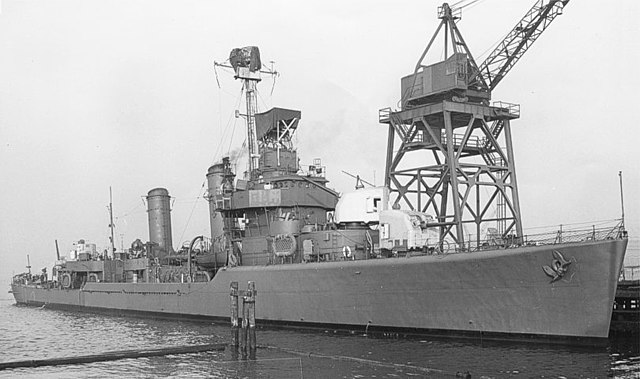
Launched 17 March 1942 (Seattle-Tacoma), commissioned 27 January 1943. New York 26 April 1943, until 29 November 4 convoy escort missions (Casablanca, Greenock, Derry, and Atlantic Coast-Caribbean service, escorted USS Bataan. Plymouth, invasion of Normandy, 31st Minesweeping Flotilla, patrols. Oran, Operation Dragoon. Patrols Naples, Marseilles. OVL New York, back north Africa until June 1945. Norfolk, 20 June conversio DMS-34, sailed late August for Pacific, San Diego, Okinawa, Sasebo. occupation duty, flagsCommander, Mine Force. Back San Francisco March 1946. Western Pacific service 18 August 1947-19 April 1948. Korean war, Sasebo. Mine ops. near Wonsan, shelled Rei, Hungnam area, fire-support, Suwon Dan, until December 1950. San Diego March 1951, OVL, 2nd TOD October 1951 – 8 August 1952, WestPack and station ship Hong Kong. Back Charleston 7 September 1953, east coast-Mediterranean (6th Fleet) until 27 May 1954. Reserve, decom. 19 May 1955 Orange, Texas. Sold 6 October 1972. 2 battle stars.
 USS Endicott DD 495
USS Endicott DD 495
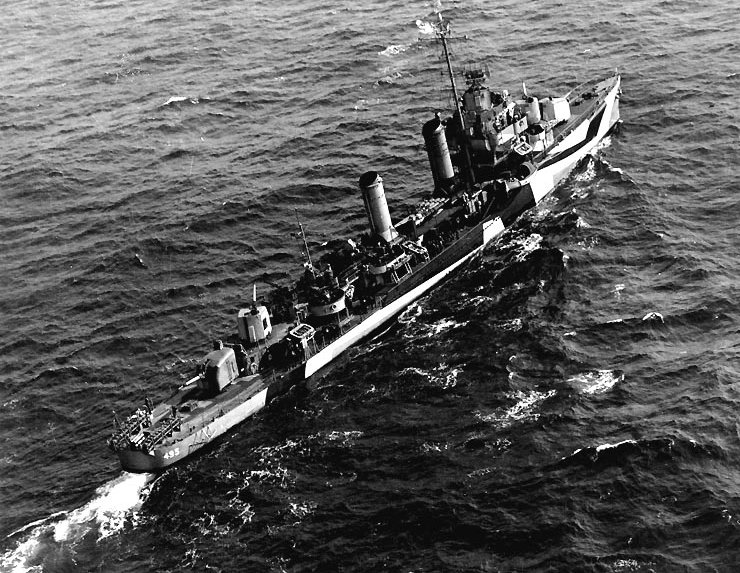
Launched Seattle-Tacoma 5 April 1942, commissioned 25 February 1943. Atlantic Fleet, escorted two convoys to Africa and Ireland, Panama, Trinidad. 24 May 1944 collided with freighter SS Exhibitor, repaired Cardiff. Operation Dragoon. Diversionary attack against La Ciotat coast. Sank German merchantman. Destroyed two German gunboats. Next Salerno operation. OVK home, January 1945 joined TG 21.5 USS Quincy Pdt Franklin D. Roosevelt to Malta and NyC. Escort to Oran back Charleston converted high-speed minesweeper DMS-35 on 30 May 1945. San Diego, V-Day then reported to TF 52 at Okinawa 23 September 1945, minesweeping Yellow Sea, flag, Inland Sea and Kure. OVL May 1946, west coast service until Korean War. Escorted USS Badoeng Strait and Sicily, was off Chinhae Wan, direct fire support and Chang Sa Dong. Inchon landings, Wonsan, Hungnam. OVL San Diego, 2nd Korean TOD. Songjin Patrol, gunline. 3rd Korean TOD. OVL Long Beach, decom. 17 August 1954 San Diego. Stricke, sold and BU.
 USS McCook DD 496
USS McCook DD 496
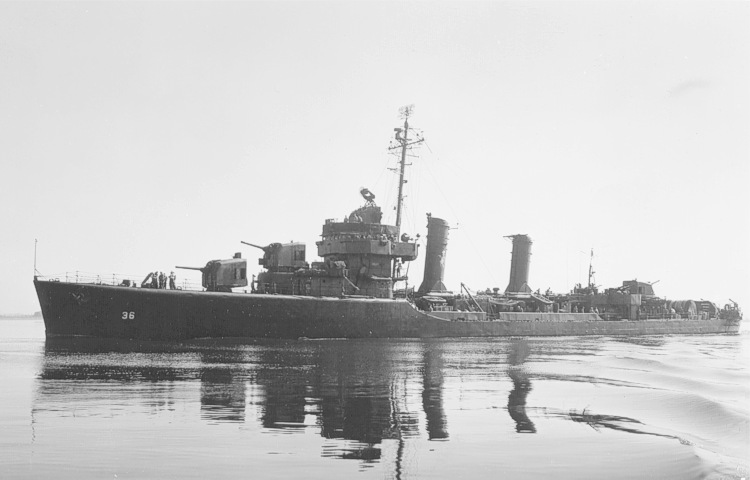
USS McCook was built at Seattle-Tacoma, launched 30 April 1942, commissioned 15 March 1943. Shakedown off San Diego, east coast May 1943, HP Norfolk June 1943 convoy to Casablanca; northeastern coast, training, resumed escort January 1944, Trinidad with USS Wasp(ii) shakedown. Joined TG 27.8 Plymouth, Portland, amphibious. 28 May air raid, damage, repaired tender Melville. Normandy landings, DesRon 18 Assault Force “O” until 14 July. Bizerte, escorted LSTs to Mers-el-Kebir, Naples Operation Anvil. Back New York October, east coast, transatlantic convoys. May 1945 Philadelphia NyD converted DMS-36. Okinawa 28 September, two typhoons, Yellow Sea MinRon 1, Sasebo, Kure–Hiroshima, Shanghai, Yokosuka, San Francisco 31 March 1946 until 14 January 1947, San Diego, Underwater Training Unit. Cruise Marshalls and Marianas until September 1947. Deactivation January 1949, decom. stricken 15 January 1972, sold 27 August 1973, BU, 3 battle stars.
 USS Frankford DD 497
USS Frankford DD 497
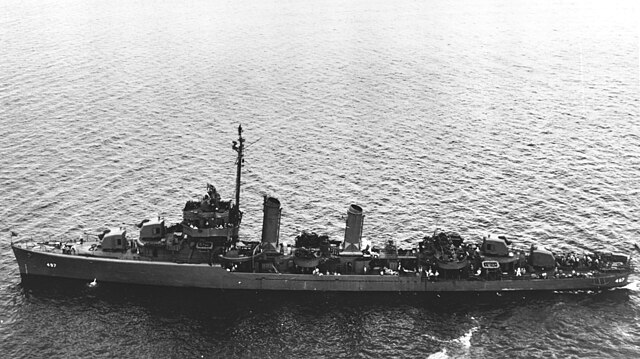
Launched 17 May 1942 (Seattle-Tacoma), commissioned 31 March 1943. Coastal escort duty, 3 runs east coast-Casablanca or Northern Ireland until 29 November. Plymouth, pres invasion of Normandy, escorted transports Scotland. Omaha Beach 6 June, gunfire support and drove off E-boat attacks. Mediterranean, Naples, op. Anvil. New York October 1944 OVL. January 1945 Norfolk-Azores, screen USS Quincy, president to Malta. ASW patrols Atlantic coast, escorted CVs. Pearl Harbor 8 August 1945, V-Day. coast of Japan, landings on Honshū, Tokyo Bay. Back home, decom. March 1946 Charleston, stricken 1 June 1971, sunk as target 4 December 1973. 2 battle stars.
 USS Davison DD 618
USS Davison DD 618
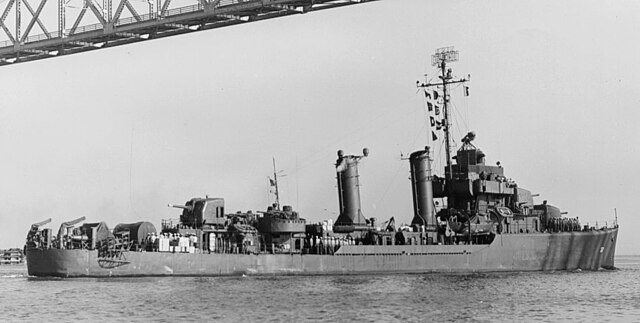
Davison was launched on 19 July 1942 (Kearny) commissioned on 11 September 1942. Left New York 13 November 1942, escort to Safi, back NyC. Two more voyages to North Africa. 4 July joined TF 85, invasion of Sicily. Other run to Bizerte, to Belfast, Palermo, under attack 6 November. Made two more escort Northern Ireland-Scotland and New York, Naples, Marseilles, Oran until 7 June 1945. Converted Charleston DMS-37, exercizes until 27 August. Okinawa 15 October, swept mines Yellow Sea until 11 March 1946, San Francisco. Another WesPac TOD until 29 March 1947. 3rd Westpac 10 March 1948. Served with the Naval Research Laboratory for balloon tests, Marshall Islands. Decom. San Diego 24 June 1949. Stricken 15 January 1972, sold, BU, 3 battle stars.
 USS Edwards DD 619
USS Edwards DD 619
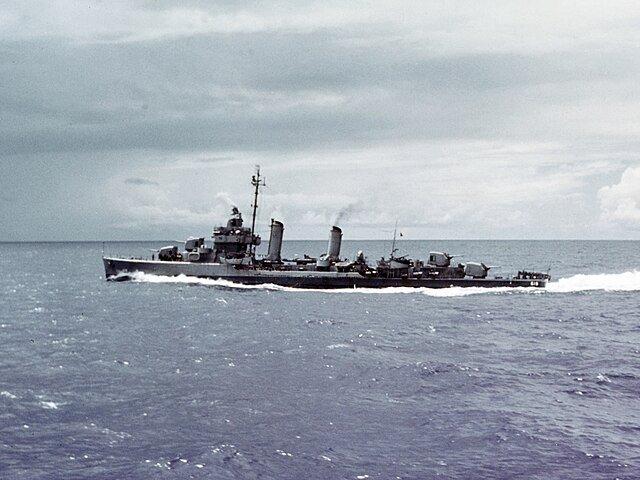
USS Edwards launched 19 July 1942 (Kearny), commissioned 18 September 1942. Convoys east coast-Caribbean. Departed 8 November 1942 TF 18, 4 January 1943 to Guadalcanal. Under attack 29 January by Japanese torpedo bombers off Rennell Island. Pearl Harbor, OVL 27 March, Aleutians, Attu 26 April, screened USS Pennsylvania, sunk I-31. ASW, shelled Kiska, back to Espiritu Santo, screen carriers for air strikes: Rabaul, Tarawa, Majuro, Mili Atoll, Palaus with 5th Fleet (TF 58). Also New Guinea and Truk, Eastern Marshalls (Mili, Jaluit, Maloelap, Wotje). OVL Pearl Harbor August 1944, Leyte, landings Ormoc. 7 December attacks by Japanese planes, shot down 3, one more hit her fantail. Escorts to Mindoro, Lingayen Gulf, Polloc, Davao Gulf. 9 May 1945 Morotai, invasion of Borneo, Iwo Jima, Okinawa in escort s, sailed home 16 September. Charleston, decom. 11 April, stricken 1 July 1971, sold 25 May 1973 for BU. 14 Battle Stars (most decorated Gleaves class destroyer)
 USS Glennon DD-620
USS Glennon DD-620
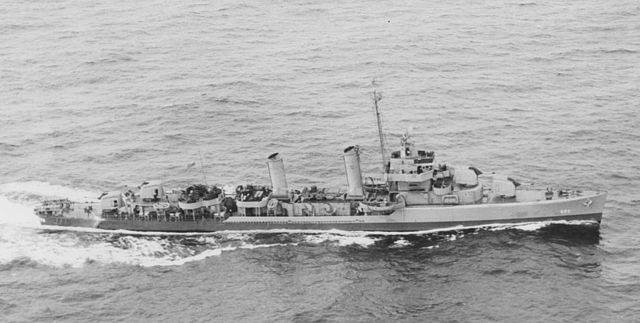
USS Glennon was launched on 26 August 1942 (Federal, Kearny), commissioned on 8 October 1942. After shakedown training, New England coast, convoy duty, Allied invasion of Sicily, Campaign of Italy. Battle of Gela 9-15 July 1943. HP NyC, two more trips from December 1943, British Isles, Gibraltar. Relocated Belfast prepared for the Invasion of Normandy, Assault Force “U”, Western Naval Task Force. Was in Baie de Seine 6 June, patrols bombardment group for U-Boats/E-Boats and joined gunline. 7 June fired ahore off Quinéville and on 8 June when hit mine. Assisted by minesweepers Staff and Threat, escort, but heavy explosion at the stern and second that blew a 50-foot (15 m) section there, then third under her forecastle. Amazingly, she survived until 9 June, but on the 10th targeted by German shore battery near Quinéville. 3 hits, abandoned, and rolled over 21:45, sank (25 lost, 38 wounded). 2 battle stars.
 USS Jeffers DD 621
USS Jeffers DD 621
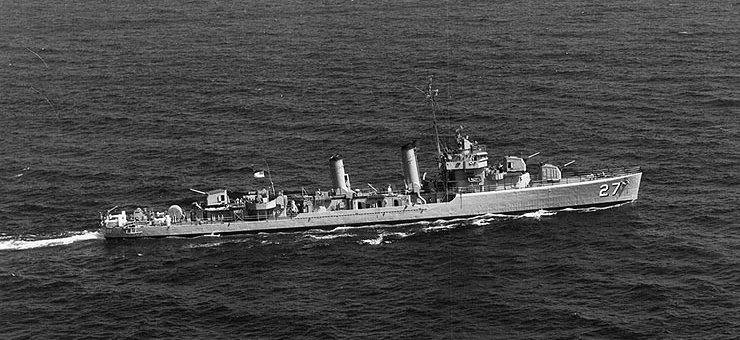
Built at Federal, Kearny, launched 26 August 1942, commissioned 5 November 1942. Post-shakedown/training off Maine, East Coast escorts, HP Norfolk and first transatlantic mission from February 1943 to Casablanca. NS Argentia, then Norfolk, departed for the invasion of Sicily with TF 65, Oran 22 June. Shoting down German bomber 6 July off Bizerte. Landings at Gela 9 July. Bizerte 18 July, Palermo 31th, Oran, New York. Then East Coast-Scotland until April 1944. May 1944, prep. invasion of Normandy, Belfast, Utah Beach until 29 Jun. Mediterranean 16 July, Malta 12 August, Cannes-Toulon until 28 September. New York 7 October, prep. Pacific.
Converted to DMS-27 15 November, dept. 3 January 1945 for Panama, San Diego, Pearl Harbor, Ulithi: Okinawa invasion, preliminary minesweeping group, 24 March 1945. Attack of 6 April downed twin-engine bomber. Radar picket station, shot down others, near-hit by a Yokosuka MXY-7 Ohka human missile. Assisted USS Mannert L. Abele. Repaired Kerama Retto, joined carrier group. More repairs Guam, Ulithi and back to Kerama Retto, ops. north of Okinawa until 15 August 1945. Tokyo Bay, occupation forces, surrender ceremonies, HP Sasebo, ops. Yellow Sea in November, back home. Norfolk 9 January 1946, short training cruise, maneuverse Caribbean, exercises East Coast until 1949. HP Charleston, Mediterranean TOD, 2nd 1951, 6th Fleet, 3rd June 1952, 4th 1953, decommissioned Charleston 23 May 1955, Reserve Fleet, stricken 1 July 1971, sold 25 May 1973, BU. 7 battle stars.
 USS Maddox DD 622
USS Maddox DD 622
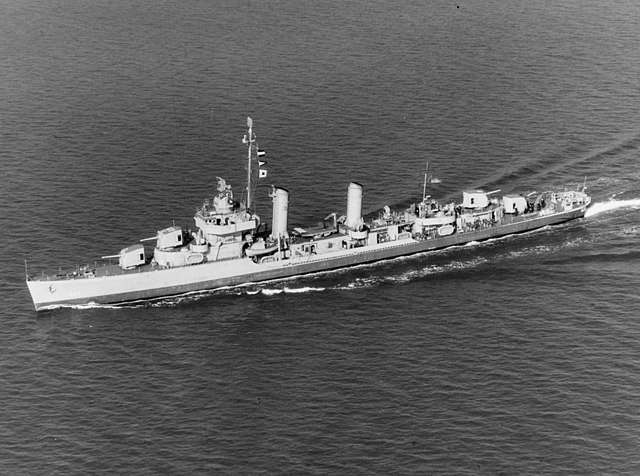
Built at Kearny (laid down 7 May 1942), launched 15 September 1942, commissioned 31 October 1942 (LtCdr Eugene S. Sarsfield). Shakedown, departed New York 2 January 1943 for Norfolk, escort fleet oilers to Galvesto, Aruba and trans-Atlantic to North Africa. 8 June 1943, Oran, TF 81 Sicilian invasion. Battle of Gela. 10 July 16 miles offshore attacked by Ju 88 bomber, KG 54, Italian Ju 87, aft magazine bomb hit, roll over and sink in two minutes. 74 saved of 284. Stricken 19 August 1943, 2 battle stars.
 USS Nelson DD 623
USS Nelson DD 623
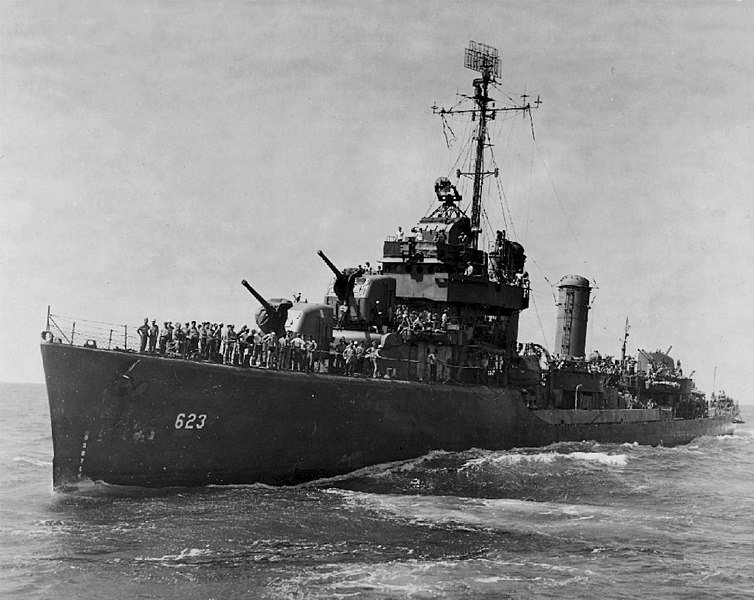
USS Nelson was built at Kearny from 7 May 1942, launched 15 September 1942, commissioned 26 November 1942. Post shakedown, Atlantic convoys from 21 January 1943 to 29 May, flagship DesRon 17, to Bermuda, Port of Spain, Trinidad, Dakar, French West Africa, Aruba, Casablanca, Gibraltar. Took part in the Invasion of Sicily in June, screening USS Boise to Algiers, glag Commander TF 81, central Western Task Force at Gela. Repelled luftwaffe on 12 July, splashed one. ASW patrol Gela-Scoglitti in July, troopships to Palermo, downed one plane on 1 August. New York August, Cdr change, North Atlantic convoy runs, Belfast, Greenock Bay, Gibraltar. Took part in the Invasion of Normandy. 24 May 1944 moored alongside a tanker at Plymouth her port screw fouled a mooring buoy, repaired drydock, but she got underway on 2 June with starboard screw only, arriving 8 June, pos. No. 13 “Dixie Line”, E-boat screen, Omaha beach. Night of 8/9 sank two E-boats.
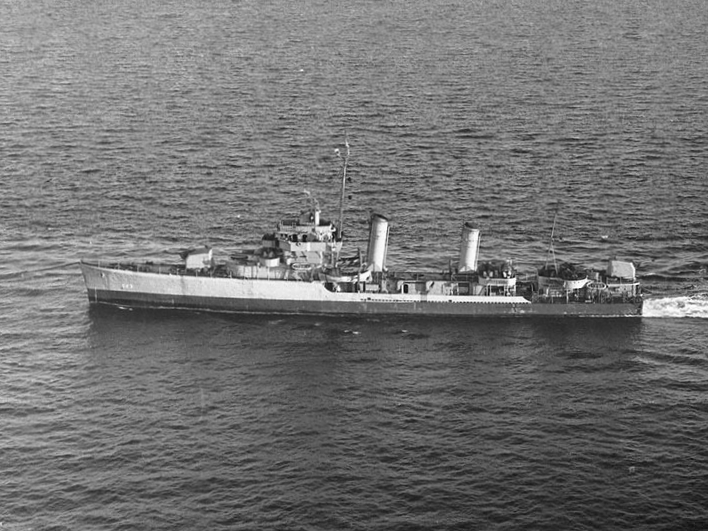
12 June night glide bomb near miss. 13 June, attacked by E-Boat by night, one torpedo struck aft of No. 4 gun, stern. Personal evacuated by Maloy, taken in tow (22 Kia, 9 wounded). Emergency repairs Derry, towed to Boston to received a new stern. Completed 23 November 1944, back to Atlantic patrol duty, Plymouth, and February 1945 convoy to Oran. Then plane guard/screen for USS Card. Panama 1 August 1945 to Pearl Harbor, Tokyo Bay 3–14 September. Occupation duties, Okinawa, Korea, Singapore, Colombo, Cape Town, and home. January 1946 Charleston, decom. January 1947, stricken 1 March 1968, sold. 2 battle stars.
 USS Baldwin DD 624
USS Baldwin DD 624
⚠ Note:
From the next ones, completion with be gradual (one per day). It’s the last time i will go into depth in the career of all the class destroyers. Indeed for the next subject, the Fletcher class in October, i will rather detail more the development history, technical aspects and some career examples and assess overall performances, and same for the next Gearing and Allen M. Sumner. Instead a list will be pointing out to the most relevant source for each ship’s career. This page is indeed already overbloated and very slow to load.
 USS Harding DD 625
USS Harding DD 625
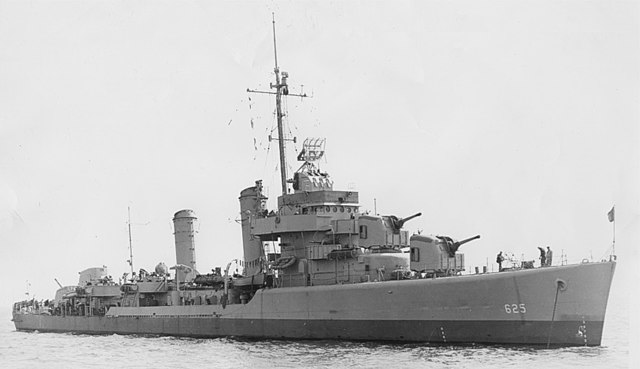
USS Harding off the New York Naval Shipyard on 5 October 1943. Note the simplified construction flat bridge is clearly visible here.
USS Harding was launched on 28 June 1942 at Seattle-Tacoma, commissioned on 25 May 1943. After shakedown off San Diego, she joined Norfolk, Hampton Roads, trained in Chesapeake Bay with a first convoy on 16 August 1943, ASW patrols in the Atlantic and runs to Casablanca. She escorted USS Texas in training and took part in the invasion of Normandy at the fire support station, Omaha. Her accurate gunfire was praised by the troops ashore. She sent a boat at Pointe du Hoc to supply the embattled Rangers and take back POWs and wounded. She left Normandy on 16 July, for various duties in the Channel. Next she was in Mediterranean, Oran, for the landings in southern France as screening ship and covered the liberation of Corsica, and back to southern France. On 17-18 August, she recovered a downed German plane, and had a unidentified contact, illuminated as four E-boats. She battled with thel, firing star shell until they were all sunk, three by her. By later august she took part in other convoys back and forth with NyC. Cobverted as DMS-28 on 15 November 1944 she went for the Pacific, San Diego, Pearl Harbor, Ulithi on 9 March 1945 to take part of minesweeping operations around Okinawa. She had a nea miss on 6 April, provided fire support on 8 April and Kamikaze attack on 16 April one crashing on her side with the bomb exploding. She survived, towed to Kerama Retto (14 Kia, 8 Mia, 9 wounded), repaired, then again (partially) at Pearl Harbor via Saipan, learning about the capitulation in between. She ended in San Diego, Norfolk on 17 September, decommissioned on 2 November, sold for scrap, 16 April 1947. 3 battle stars.

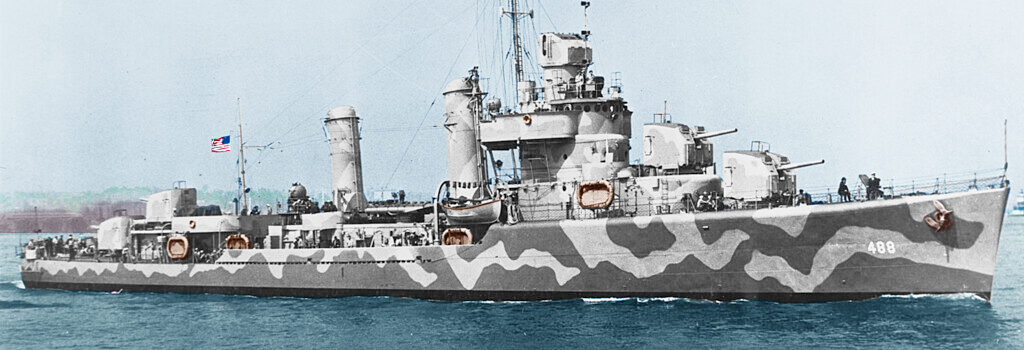
 Latest Facebook Entry -
Latest Facebook Entry -  X(Tweeter) Naval Encyclopedia's deck archive
X(Tweeter) Naval Encyclopedia's deck archive Instagram (@navalencyc)
Instagram (@navalencyc)





 French Navy
French Navy Royal Navy
Royal Navy Russian Navy
Russian Navy Armada Espanola
Armada Espanola Austrian Navy
Austrian Navy K.u.K. Kriegsmarine
K.u.K. Kriegsmarine Dansk Marine
Dansk Marine Nautiko Hellenon
Nautiko Hellenon Koninklije Marine 1870
Koninklije Marine 1870 Marinha do Brasil
Marinha do Brasil Osmanlı Donanması
Osmanlı Donanması Marina Do Peru
Marina Do Peru Marinha do Portugal
Marinha do Portugal Regia Marina 1870
Regia Marina 1870 Nihhon Kaigun 1870
Nihhon Kaigun 1870 Preußische Marine 1870
Preußische Marine 1870 Russkiy Flot 1870
Russkiy Flot 1870 Svenska marinen
Svenska marinen Søværnet
Søværnet Union Navy
Union Navy Confederate Navy
Confederate Navy Armada de Argentina
Armada de Argentina Imperial Chinese Navy
Imperial Chinese Navy Marinha do Portugal
Marinha do Portugal Mexico
Mexico Kaiserliche Marine
Kaiserliche Marine 1898 US Navy
1898 US Navy Sovietskiy Flot
Sovietskiy Flot Royal Canadian Navy
Royal Canadian Navy Royal Australian Navy
Royal Australian Navy RNZN Fleet
RNZN Fleet Chinese Navy 1937
Chinese Navy 1937 Kriegsmarine
Kriegsmarine Chilean Navy
Chilean Navy Danish Navy
Danish Navy Finnish Navy
Finnish Navy Hellenic Navy
Hellenic Navy Polish Navy
Polish Navy Romanian Navy
Romanian Navy Turkish Navy
Turkish Navy Royal Yugoslav Navy
Royal Yugoslav Navy Royal Thai Navy
Royal Thai Navy Minor Navies
Minor Navies Albania
Albania Austria
Austria Belgium
Belgium Columbia
Columbia Costa Rica
Costa Rica Cuba
Cuba Czechoslovakia
Czechoslovakia Dominican Republic
Dominican Republic Haiti
Haiti Hungary
Hungary Honduras
Honduras Estonia
Estonia Iceland
Iceland Eire
Eire Equador
Equador Iran
Iran Iraq
Iraq Latvia
Latvia Liberia
Liberia Lithuania
Lithuania Mandchukuo
Mandchukuo Morocco
Morocco Nicaragua
Nicaragua Persia
Persia San Salvador
San Salvador Sarawak
Sarawak Uruguay
Uruguay Venezuela
Venezuela Zanzibar
Zanzibar Warsaw Pact Navies
Warsaw Pact Navies Bulgaria
Bulgaria Hungary
Hungary

 Bundesmarine
Bundesmarine Dutch Navy
Dutch Navy Hellenic Navy
Hellenic Navy Marina Militare
Marina Militare Yugoslav Navy
Yugoslav Navy Chinese Navy
Chinese Navy Indian Navy
Indian Navy Indonesian Navy
Indonesian Navy JMSDF
JMSDF North Korean Navy
North Korean Navy Pakistani Navy
Pakistani Navy Philippines Navy
Philippines Navy ROKN
ROKN Rep. of Singapore Navy
Rep. of Singapore Navy Taiwanese Navy
Taiwanese Navy IDF Navy
IDF Navy Saudi Navy
Saudi Navy Royal New Zealand Navy
Royal New Zealand Navy Egyptian Navy
Egyptian Navy South African Navy
South African Navy






























 Ukrainian Navy
Ukrainian Navy dbodesign
dbodesign